Abstract
Background
Acupuncture is often used for migraine prevention but its effectiveness is still controversial. We present an update of our Cochrane review from 2009.
Objectives
To investigate whether acupuncture is a) more effective than no prophylactic treatment/routine care only; b) more effective than sham (placebo) acupuncture; and c) as effective as prophylactic treatment with drugs in reducing headache frequency in adults with episodic migraine.
Search methods
We searched the Cochrane Central Register of Controlled Trials (CENTRAL: 2016, issue 1); MEDLINE (via Ovid, 2008 to January 2016); Ovid EMBASE (2008 to January 2016); and Ovid AMED (1985 to January 2016). We checked PubMed for recent publications to April 2016. We searched the World Health Organization (WHO) Clinical Trials Registry Platform to February 2016 for ongoing and unpublished trials.
Selection criteria
We included randomized trials at least eight weeks in duration that compared an acupuncture intervention with a no‐acupuncture control (no prophylactic treatment or routine care only), a sham‐acupuncture intervention, or prophylactic drug in participants with episodic migraine.
Data collection and analysis
Two reviewers checked eligibility; extracted information on participants, interventions, methods and results, and assessed risk of bias and quality of the acupuncture intervention. The primary outcome was migraine frequency (preferably migraine days, attacks or headache days if migraine days not measured/reported) after treatment and at follow‐up. The secondary outcome was response (at least 50% frequency reduction). Safety outcomes were number of participants dropping out due to adverse effects and number of participants reporting at least one adverse effect. We calculated pooled effect size estimates using a fixed‐effect model. We assessed the evidence using GRADE and created 'Summary of findings' tables.
Main results
Twenty‐two trials including 4985 participants in total (median 71, range 30 to 1715) met our updated selection criteria. We excluded five previously included trials from this update because they included people who had had migraine for less than 12 months, and included five new trials. Five trials had a no‐acupuncture control group (either treatment of attacks only or non‐regulated routine care), 15 a sham‐acupuncture control group, and five a comparator group receiving prophylactic drug treatment. In comparisons with no‐acupuncture control groups and groups receiving prophylactic drug treatment, there was risk of performance and detection bias as blinding was not possible. Overall the quality of the evidence was moderate.
Comparison with no acupuncture
Acupuncture was associated with a moderate reduction of headache frequency over no acupuncture after treatment (four trials, 2199 participants; standardised mean difference (SMD) ‐0.56; 95% CI ‐0.65 to ‐0.48); findings were statistically heterogeneous (I² = 57%; moderate quality evidence). After treatment headache frequency at least halved in 41% of participants receiving acupuncture and 17% receiving no acupuncture (pooled risk ratio (RR) 2.40; 95% CI 2.08 to 2.76; 4 studies, 2519 participants) with a corresponding number needed to treat for an additional beneficial outcome (NNTB) of 4 (95% CI 3 to 6); there was no indication of statistical heterogeneity (I² = 7%; moderate quality evidence). The only trial with post‐treatment follow‐up found a small but significant benefit 12 months after randomisation (RR 2.16; 95% CI 1.35 to 3.45; NNT 7; 95% 4 to 25; 377 participants, low quality evidence).
Comparison with sham acupuncture
Both after treatment (12 trials, 1646 participants) and at follow‐up (10 trials, 1534 participants), acupuncture was associated with a small but statistically significant frequency reduction over sham (moderate quality evidence). The SMD was ‐0.18 (95% CI ‐0.28 to ‐0.08; I² = 47%) after treatment and ‐0.19 (95% CI ‐0.30 to ‐0.09; I² = 59%) at follow‐up. After treatment headache frequency at least halved in 50% of participants receiving true acupuncture and 41% receiving sham acupuncture (pooled RR 1.23, 95% CI 1.11 to 1.36; I² = 48%; 14 trials, 1825 participants) and at follow‐up in 53% and 42%, respectively (pooled RR 1.25, 95% CI 1.13 to 1.39; I² = 61%; 11 trials, 1683 participants; moderate quality evidence). The corresponding NNTBs are 11 (95% CI 7.00 to 20.00) and 10 (95% CI 6.00 to 18.00), respectively. The number of participants dropping out due to adverse effects (odds ratio (OR) 2.84; 95% CI 0.43 to 18.71; 7 trials, 931 participants; low quality evidence) and the number of participants reporting adverse effects (OR 1.15; 95% CI 0.85 to 1.56; 4 trials, 1414 participants; moderate quality evidence) did not differ significantly between acupuncture and sham groups.
Comparison with prophylactic drug treatment
Acupuncture reduced migraine frequency significantly more than drug prophylaxis after treatment ( SMD ‐0.25; 95% CI ‐0.39 to ‐0.10; 3 trials, 739 participants), but the significance was not maintained at follow‐up (SMD ‐0.13; 95% CI ‐0.28 to 0.01; 3 trials, 744 participants; moderate quality evidence). After three months headache frequency at least halved in 57% of participants receiving acupuncture and 46% receiving prophylactic drugs (pooled RR 1.24; 95% CI 1.08 to 1.44) and after six months in 59% and 54%, respectively (pooled RR 1.11; 95% CI 0.97 to 1.26; moderate quality evidence). Findings were consistent among trials with I² being 0% in all analyses. Trial participants receiving acupuncture were less likely to drop out due to adverse effects (OR 0.27; 95% CI 0.08 to 0.86; 4 trials, 451 participants) and to report adverse effects (OR 0.25; 95% CI 0.10 to 0.62; 5 trials 931 participants) than participants receiving prophylactic drugs (moderate quality evidence).
Authors' conclusions
The available evidence suggests that adding acupuncture to symptomatic treatment of attacks reduces the frequency of headaches. Contrary to the previous findings, the updated evidence also suggests that there is an effect over sham, but this effect is small. The available trials also suggest that acupuncture may be at least similarly effective as treatment with prophylactic drugs. Acupuncture can be considered a treatment option for patients willing to undergo this treatment. As for other migraine treatments, long‐term studies, more than one year in duration, are lacking.
Keywords: Female, Humans, Male, Acupuncture Therapy, Acupuncture Therapy/adverse effects, Migraine Disorders, Migraine Disorders/drug therapy, Migraine Disorders/prevention & control, Migraine with Aura, Migraine with Aura/prevention & control, Migraine without Aura, Migraine without Aura/prevention & control, Randomized Controlled Trials as Topic
Plain language summary
Acupuncture for preventing migraine attacks
Bottom line
The available evidence suggests that a course of acupuncture consisting of at least six treatment sessions can be a valuable option for people with migraine.
Background
Individuals with migraine have repeated attacks of severe headache, usually just on one side and often with vomiting. Acupuncture is a therapy in which thin needles are inserted into the skin at particular points. It originated in China, and is now used in many countries to treat people with migraine. We evaluated whether acupuncture reduces the number of episodes of migraine. We looked at the number of people in whom the number of migraine days per month was reduced by half or more than half.
Key results
For this update, we reviewed 22 trials with 4985 people, published up to January 2016. We omitted five trials from the original review because they included people who had had migraine for less than 12 months. We included five new trials in this update.
In four trials, acupuncture added to usual care or treatment of migraine on onset only (usually with pain‐killers) resulted in 41 in 100 people having the frequency of headaches at least halved, compared to 17 of 100 people given usual care only.
In 15 trials, acupuncture was compared with 'fake' acupuncture, where needles are inserted at incorrect points or do not penetrate the skin. The frequency of headaches halved in 50 of 100 people receiving true acupuncture, compared with 41 of 100 people receiving 'fake' acupuncture. The results were dominated by three good quality large trials (with about 1200 people) showing that the effect of true acupuncture was still present after six months. There were no differences in the number of side effects of real and 'fake' acupuncture, or the numbers dropping out because of side effects.
In five trials, acupuncture was compared to a drug proven to reduce the frequency of migraine attacks, but only three trials provided useful information. At three months, headache frequency halved in 57 of 100 people receiving acupuncture, compared with 46 of 100 people taking the drug. After six months, headache frequency halved in 59 of 100 people receiving acupuncture, compared with 54 of 100 people taking the drug. People receiving acupuncture reported side effects less often than people receiving drugs, and were less likely to drop out of the trial.
Our findings about the number of days with migraine per month can be summarized as follows. If people have six days with migraine per month on average before starting treatment, this would be reduced to five days in people receiving only usual care, to four days in those receiving fake acupuncture or a prophylactic drug, and to three and a half days in those receiving true acupuncture.
Quality of the evidence
Overall the quality of the evidence was moderate.
Summary of findings
Summary of findings for the main comparison. Acupuncture compared to no treatment/usual care.
| Acupuncture compared to no treatment/usual care | ||||||
| Patient or population: people with episodic migraine Setting: primary care or outpatient care Intervention: acupuncture Comparison: no treatment/usual care | ||||||
| Outcomes | Anticipated absolute effects* (95% CI) | Relative effect (95% CI) | № of participants (studies) | Quality of the evidence (GRADE) | Comments | |
| Risk with no treatment/usual care | Risk with Acupuncture | |||||
| Headache frequency (after treatment)
assessed with days per month follow‐up: median 3 months |
Headache frequency was 0.56 SDs (‐0.65 to ‐0.48) lower than in the groups receiving no/usual treatment | ‐ | 2199 (4 RCTs) | ⊕⊕⊕⊝ MODERATE 1 2 | As a rule of thumb 0.2 SD represents a small difference, 0.5 a moderate, and 0.8 a large difference. Size of difference open to change with more trials | |
| Headache frequency (follow‐up)
assessed with days per month follow‐up: 12 months |
Headache frequency was 0.36 SDs (‐0.59 to ‐0.12) lower than in the groups receiving no/usual treatment | ‐ | 284 (1 RCT) | ⊕⊕⊝⊝ LOW 2 3 | Only single large trial available. As a rule of thumb 0.2 SD represents a small difference, 0.5 a moderate, and 0.8 a large difference. Size of difference open to change with more trials. | |
| Response (after treatment)
assessed with proportion of participants with at least 50% headache frequency reduction follow‐up: median 3 months |
Study population | RR 2.40 (2.08 to 2.76) | 2519 (4 RCTs) | ⊕⊕⊕⊝ MODERATE 2 | No blinding, variable care in control groups, variable size of effects, but moderate to large effects in all three larger trials | |
| 171 per 1000 | 410 per 1000 (355 to 472) | |||||
| Response (follow‐up)
assessed with proportion of participants with at least 50% headache frequency reduction follow‐up: 12 months |
Study population | RR 2.16 (1.35 to 3.45) | 377 (1 RCT) | ⊕⊕⊝⊝ LOW 2 3 | Only single large trial available | |
| 98 per 1000 | 212 per 1000 (133 to 339) | |||||
| *The risk in the intervention group (and its 95% confidence interval) is based on the assumed risk in the comparison group and the relative effect of the intervention (and its 95% CI). CI: Confidence interval; RR: Risk ratio; OR: Odds ratio | ||||||
| GRADE Working Group grades of evidence High quality: We are very confident that the true effect lies close to that of the estimate of the effect Moderate quality: We are moderately confident in the effect estimate: The true effect is likely to be close to the estimate of the effect, but there is a possibility that it is substantially different Low quality: Our confidence in the effect estimate is limited: The true effect may be substantially different from the estimate of the effect Very low quality: We have very little confidence in the effect estimate: The true effect is likely to be substantially different from the estimate of effect | ||||||
1 Interventions in control groups and study findings variable (I² = 57%; Chi² = 6.96, P value = 0.07), but effects moderate to large in all three larger trials
2 Downgraded once: no blinding
3 Downgraded once: only one study
Summary of findings 2. Acupuncture compared to sham interventions.
| Acupuncture compared to sham acupuncture | ||||||
| Patient or population: people with episodic migraine Setting: primary care or outpatient care Intervention: acupuncture Comparison: sham acupuncture | ||||||
| Outcomes | Anticipated absolute effects* (95% CI) | Relative effect (95% CI) | № of participants (studies) | Quality of the evidence (GRADE) | Comments | |
| Risk with sham acupuncture | Risk with Acupuncture | |||||
| Headache frequency (after treatment) assessed with days per month follow‐up: median 12 weeks | Headache frequency was 0.18 SDs (‐0.28 to ‐0.08) lower than in the groups receiving sham treatment | ‐ | 1646 (12 RCTs) | ⊕⊕⊕⊝ MODERATE 1 | As a rule of thumb 0.2 SD represents a small difference, 0.5 a moderate, and 0.8 a large difference | |
| Headache frequency (follow‐up) assessed with days per month follow‐up: median 6 months | Assuming a mean number of 3.5 (SD 3.0) migraine days in the sham group, participants in the acupuncture group would have 0.6 days (95% CI 0.3 to 1.1 days) less (SMD = ‐0.19; 95% CI ‐0.30 to ‐0.09; 896 patients receiving acupuncture, 638 sham) | ‐ | 1534 (10 RCTs) |
⊕⊕⊕⊝ MODERATE 2 | As a rule of thumb 0.2 SD represents a small difference, 0.5 a moderate, and 0.8 a large difference | |
| Response (after treatment) assessed with proportion of participants with at least 50% headache frequency reduction follow‐up: median 12 weeks | Study population | RR 1.23 (1.11 to 1.36) | 1825 (14 RCTs) | ⊕⊕⊕⊝ MODERATE 3 | Variable results between studies; modest effect size leaves magnitude of effect open to change with further large trials | |
| 408 per 1000 | 502 per 1000 (453 to 555) | |||||
| Response (follow‐up) assessed with proportion of participants with at least 50% headache frequency reduction follow‐up: median 6 months | Study population | RR 1.25 (1.13 to 1.39) | 1683 (11 RCTs) | ⊕⊕⊕⊝ MODERATE 4 | Variable results between studies; modest effect size leaves magnitude of effect open to change with further large trials | |
| 423 per 1000 | 529 per 1000 (479 to 589) | |||||
| Number of participants dropping out due to adverse effects | Study population | RR 2.84 (0.43 to 18.71) | 931 (7 RCTs) | ⊕⊕⊝⊝ LOW 5 | Relevant uncertainty due to low event rates | |
| Only 3/621 participants receiving acupuncture and 0/310 receiving sham dropped out due to adverse effects | ||||||
| Number of participants reporting adverse effects | Study population | RR 1.15 (0.85 to 1.56) | 1414 (4 RCTs) | ⊕⊕⊕⊕ HIGH | Only 4 large trials report this outcome adequately; variable methods to document adverse effects, yet results of trials are consistent | |
| 173 per 1000 | 199 per 1000 (147 to 270) | |||||
| *The risk in the intervention group (and its 95% confidence interval) is based on the assumed risk in the comparison group and the relative effect of the intervention (and its 95% CI). CI: Confidence interval; RR: Risk ratio; OR: Odds ratio | ||||||
| GRADE Working Group grades of evidence High quality: We are very confident that the true effect lies close to that of the estimate of the effect Moderate quality: We are moderately confident in the effect estimate: The true effect is likely to be close to the estimate of the effect, but there is a possibility that it is substantially different Low quality: Our confidence in the effect estimate is limited: The true effect may be substantially different from the estimate of the effect Very low quality: We have very little confidence in the effect estimate: The true effect is likely to be substantially different from the estimate of effect | ||||||
1 Downgraded once: pronounced heterogeneity of study results (I² = 47%; Chi² = 20.69; P value = 0.04)
2 Downgraded once: pronounced heterogeneity of study results (I² = 59%; Chi² = 27.10; P value = 0.0003)
3 Downgraded once: pronounced heterogeneity of study results (I² = 48%; Chi² = 25.09; P value = 0.02)
4 Downgraded once: pronounced heterogeneity of study results (I² = 61%; Chi² = 25.50; P value = 0.004)
5 Downgraded twice: only very few events
Summary of findings 3. Acupuncture compared to prophylactic drugs.
| Acupuncture compared to prophylactic drugs | ||||||
| Patient or population: people with episodic migraine Setting: primary care or outpatient care Intervention: acupuncture Comparison: prophylactic drug treatment | ||||||
| Outcomes | Anticipated absolute effects* (95% CI) | Relative effect (95% CI) | № of participants (studies) | Quality of the evidence (GRADE) | Comments | |
| Risk with prophylactic drug treatment | Risk with acupuncture | |||||
| Headache frequency assessed with days per month follow‐up median 3 months | Headache frequency was 0.25 SDs (‐039 to ‐0.10) lower than in the groups receiving prophylactic drug treatment | ‐ | 739 (3 RCTs) | ⊕⊕⊕⊝ MODERATE 1 | As a rule of thumb 0.2 SD represents a small difference, 0.5 a moderate, and 0.8 a large difference. Size of difference open to change with more trials | |
| Headache frequency assessed with days per month follow‐up: median 6 months | Headache frequency was 0.13 SDs (‐0.28 to 0.01) lower than in the groups receiving prophylactic drug treatment | ‐ | 744 (3 RCTs) | ⊕⊕⊕⊝ MODERATE 1 | As a rule of thumb 0.2 SD represents a small difference, 0.5 a moderate, and 0.8 a large difference. Size of difference open to change with more trials | |
| Response assessed with proportion of participants with at least 50% headache frequency reduction follow‐up: median 3 months | Study population | RR 1.24 (1.08 to 1.44) | 743 (3 RCTs) | ⊕⊕⊕⊝ MODERATE 1 | Due to the limited number of trials and risk of bias size of differences open to change with more trials | |
| 461 per 1000 | 572 per 1000 (498 to 664) | |||||
| Response assessed with proportion of participants with at least 50% headache frequency reduction follow‐up: median 6 months | Study population | RR 1.11 (0.97 to 1.26) | 744 (3 RCTs) | ⊕⊕⊕⊝ MODERATE 1 | Due to the limited number of trials and risk of bias size of differences open to change with more trials | |
| 536 per 1000 | 595 per 1000 (520 to 675) | |||||
| Number of participants dropping out due to adverse effects | Study population | OR 0.27 (0.08 to 0.86) | 451 (4 RCTs) | ⊕⊕⊕⊝ MODERATE 2 | Consistent results between studies, but uncertainty about size of difference due to low frequency of events in acupuncture group | |
| 71 per 1000 | 20 per 1000 (6 to 62) | |||||
| Number of participants reporting adverse effects | Study population | OR 0.25 (0.10 to 0.62) | 931 (5 RCTs) | ⊕⊕⊕⊝ MODERATE 3 | Consistently fewer adverse effects in acupuncture groups, but strong variability of size of differences (probably due to different assessment methods) | |
| 341 per 1000 | 114 per 1000 (49 to 243) | |||||
| *The risk in the intervention group (and its 95% confidence interval) is based on the assumed risk in the comparison group and the relative effect of the intervention (and its 95% CI). CI: Confidence interval; RR: Risk ratio; OR: Odds ratio; | ||||||
| GRADE Working Group grades of evidence High quality: We are very confident that the true effect lies close to that of the estimate of the effect Moderate quality: We are moderately confident in the effect estimate: The true effect is likely to be close to the estimate of the effect, but there is a possibility that it is substantially different Low quality: Our confidence in the effect estimate is limited: The true effect may be substantially different from the estimate of the effect Very low quality: We have very little confidence in the effect estimate: The true effect is likely to be substantially different from the estimate of effect | ||||||
1 Downgraded once: in two of three studies a relevant proportion of participants randomized to drug treatment dropped out early (analysis included only participants receiving at least a minimal amount of treatment); no blinding of participants
2 Downgraded once: few events in acupuncture group; wide confidence interval
3 Downgraded once: size of differences highly variable (I² = 78%; Chi² = 17.95, P value = 0.001), but consistently more adverse effects in drug groups
Background
This review is an update of a previously published review in The Cochrane Database of Systematic Reviews [Issue 1, 2009] on acupuncture for migraine (Linde 2009).
Description of the condition
Migraine is a disorder with recurrent headaches manifesting in attacks lasting from four to 72 hours. Typical characteristics of the headache are unilateral location, pulsating quality, moderate or severe intensity, aggravation by routine physical activity and association with nausea, photophobia or phonophobia, or any combination of all three (IHS 2013). Epidemiological studies have consistently shown that migraine is a common disorder with a one‐year prevalence of around 10% to 12% and a lifetime prevalence of between 15% and 20% (Oleson 2007). In Europe, the economic cost of migraine is estimated at EUR 27 billion per year (Andlin‐Sobocki 2005). Migraine is subclassified into the more frequent episodic migraine (fewer than 15 days with migrainous headaches per month) and the less frequent chronic migraine (more than 15 days per month). Most people with migraine can be adequately managed by treatingof acute headaches alone, but a relevant minority need prophylactic interventions, as their attacks are either very frequent or are insufficiently controlled by acute therapy. Several drugs, such as propranolol, metoprolol, flunarizine, valproic acid and topiramate, have been shown to reduce attack frequency in some people (Dodick 2007; Linde M 2013a; Linde M 2013b), however, all these drugs are associated with adverse effects. Dropout rates in most clinical trials are high, suggesting that the drugs are not well accepted by patients. There is some evidence that behavioural interventions such as relaxation or biofeedback are beneficial (Holroyd 1990; Nestoriuc 2007), but additional effective, low‐risk treatments are clearly desirable.
Description of the intervention
Acupuncture in the context of this review is defined as the needling of specific points of the body. It is one of the most widely used complementary therapies in many countries (Bodeker 2005). For example, according to a population‐based survey in 2002 in the United States of America (USA), 4.1% of respondents reported lifetime use of acupuncture, and 1.1% reported recent use (Burke 2006). A similar survey in Germany performed in the same year found that 8.7% of adults between 18 and 69 years of age had received acupuncture treatment in the previous 12 months (Härtel 2004). Acupuncture was originally developed as part of Chinese medicine wherein the purpose of treatment was to bring the patient back to the state of equilibrium postulated to exist prior to illness (Endres 2007). Some acupuncture practitioners have dispensed with these concepts and understand acupuncture in terms of conventional neurophysiology. Acupuncture is often used to treat headache, especially migraine. For example, 9.9% of the acupuncture users in the US survey mentioned above stated that they had been treated for migraine or other headaches (Burke 2006).
How the intervention might work
Many studies have shown that acupuncture has short‐term effects on a variety of physiological variables relevant to analgesia (Bäcker 2004; Endres 2007). However, it is unclear to what extent these observations from experimental settings are relevant to the long‐term effects reported by practitioners. It is assumed that a variable combination of local effects; spinal and supraspinal mechanisms; and cortical, psychological or 'placebo' mechanisms contribute to the clinical effects in routine care (Carlsson 2002). While there is little doubt that acupuncture interventions cause neurophysiological changes in the organism, the traditional concepts of acupuncture involving specifically located points on a system of 'channels' called meridians are controversial (Kaptchuk 2002). As for many non‐pharmacological interventions, it is difficult to create sham interventions for acupuncture which are both indistinguishable and physiologically inert. This is due both to technical reasons and the unclear mechanism of action. Consequently, trials using sham acupuncture controls must be interpreted carefully, as sham treatments might not be inactive placebos, while trials comparing acupuncture with no prophylactic treatment, prophylactic drugs or other interventions must also be interpreted carefully, as they have a higher risk of bias due to lack of blinding.
Why it is important to do this review
Despite acupuncture's widespread use its effectiveness is still discussed controversially (Da Silva 2015, McGeeney 2015). Since the publication of the previous version of our Cochrane review (Linde 2009) a number of new trials have been published. Therefore, an update of the review was necessary. To sharpen the focus of our review we narrowed our selection criteria. In particular, we now focus on episodic migraine.
Objectives
To investigate whether acupuncture is a) more effective than no prophylactic treatment/routine care only; b) more effective than 'sham' (placebo) acupuncture; and c) as effective as prophylactic treatment with drugs in reducing headache frequency in patients with episodic migraine.
Methods
Criteria for considering studies for this review
Types of studies
We included controlled trials investigating the prophylactic effect of acupuncture in which allocation to treatment was explicitly randomized, and in which participants were followed up for at least eight weeks after randomisation. We excluded trials in which a clearly inappropriate method of randomisation was used, for example, open alternation.
Types of participants
We included trials in which study participants had been diagnosed with episodic migraine (the word episodic did not have to be mentioned in the report explicitly; see exclusion criteria below to exclude trials focusing on chronic migraine). Studies focusing on migraine but including participants with additional tension‐type headache were included. We included studies including participants with headaches of various types (for example, some participants with migraine, some with tension‐type headache) only if findings for participants with migraine were available separately, or if more than 90% of participants suffered from migraine.
The duration of the condition had to be longer than one year in the great majority (more than 80%) of participants. This criterion was considered met if:
duration for longer than year was an inclusion criterion; or
the mean duration minus one standard deviation was more than one year; or
the mean duration (standard deviation not reported) was more than 10 years; or
other information was presented that made it highly likely that the criterion was met (e.g. study authors presented proportions with duration ranges).
We excluded trials in patients with chronic migraine, chronic daily headache or in which at baseline more than half of participants had more than 15 days with migrainous headache per month. We also excluded trials in which there was no information of the duration of headache complaints.
Changes to previous version
In this update of the review we have excluded trials focusing on chronic migraine, as the definition of chronic migraine is still debated and the separation from other diagnoses, for example headache due to medication overuse, is difficult (in the previous version of this review (Linde 2009) we were not aware of any trials on chronic migraine and they were not explicitly excluded). In the current update we have also excluded trials in which a relevant proportion of participants had been suffering from migraine for less than one year or in which duration was unclear.
Types of interventions
Experimental interventions
Any treatment involving needle insertion (with or without manual or electrical stimulation) at acupuncture points, pain points or trigger points, described as acupuncture. The planned treatment course must have had at least six treatment sessions, and been given at least once per week. Trials with individualised strategies were included if the median or mean number of treatments was at least six sessions, and there was no reason to believe that treatments were given less frequently than once per week in the majority of participants.
-
We excluded studies that:
exclusively investigated acupuncture at specific ‘micro‐systems’ (e.g. scalp or ear acupuncture), although we included trials using micro‐system points in addition to body acupuncture;
investigated other methods of stimulating acupuncture points without needle insertion, for example, acupressure, laser stimulation or transcutaneous electrical stimulation;
injected fluids at acupuncture or trigger points.
Control interventions
No treatment other than treatment of acute migraine attacks or routine care (which typically includes treatment of acute attacks, but might also include other treatments; however, trials normally require that no new experimental or standardized treatment be initiated during the trial period).
Sham interventions (interventions mimicking 'true' acupuncture/true treatment, but deviating in at least one aspect considered important by acupuncture theory, such as skin penetration or correct point location).
Prophylactic pharmacological treatment (for example, β‐blocking agents, calcium channel antagonists, anti‐epileptic drugs) given for at least eight weeks.
We excluded trials comparing acupuncture to food supplements, herbal drugs or combinations of herbal drugs, and trials that only compared different forms of acupuncture.
Changes to previous version
In the previous version of the review (Linde 2009) we included trials using any prophylactic treatment other than acupuncture as comparison. With a slowly increasing number of trials using a wide range of different treatments (mainly various herbal medicines) we decided to concentrate on conventional prophylactic pharmacological treatment to keep the review focused. We have defined a minimum number and frequency of acupuncture treatment sessions to ensure that treatments meet basic quality criteria.
Types of outcome measures
We included studies if they measured at least one of the following outcome measures for at least eight weeks after randomisation:
headache frequency (attacks, days, hours, headache‐free days) per defined time period;
response (≥ 50% frequency reduction documented in a headache diary);
disability or quality of life with a validated measure.
We excluded trials that:
focussed on the treatment and measurement of acute attacks;
reported only measures such as “total effectiveness rate” (e.g. proportion of participants healed, much improved, improved, unchanged);
reported only physiological or laboratory parameters;
had outcome measurement periods of less than eight weeks (from randomisation to final observation).
Changes to previous version
We have defined outcome measures more precisely to ensure that measurement methods meet current standards of migraine research.
Primary outcomes
The primary efficacy outcome of our systematic review was headache frequency at completion of treatment and at follow‐up. The primary safety/acceptability outcomes were the number of participants dropping out due to adverse effects and the number of participants reporting at least one adverse event or effect (see Measures of treatment effect for details).
Secondary outcomes
The secondary efficacy outcome of our systematic review was the proportion of 'responders' at completion of treatment and at follow‐up.
Search methods for identification of studies
Electronic searches
For this update we searched the following databases without language restrictions (date of the last search 20 January 2016):
Cochrane Central Register of Controlled Trials (CENTRAL; The Cochrane Library 2016, Issue 1), searched from 2008 to 2016;
MEDLINE (via Ovid) 2008 to week 1 of January 2016;
EMBASE (via Ovid) 2008 to 19 January 2016;
AMED (via OVID) 1985 to January 2016.
The search strategies are reported in Appendix 1. In addition, the first author checked PubMed monthly for new publications, screening all hits for 'acupuncture AND (headache OR migraine)' (last search 12 April 2016). For previous versions of this review (Melchart 2001; Linde 2009) we had searched the Cochrane Complementary Medicine Field Trials Register (whose results are now included in CENTRAL without relevant delay) and the Cochrane Pain, Palliative & Supportive Care Trials Register (no longer updated).
Searching other resources
We searched the World Health Organization (WHO) International Clinical Trials Registry Platform (ICTRP; apps.who.int/trialsearch/) and ClinicalTrials.gov (ClinicalTrials.gov) for completed or ongoing trials using the search string 'acupuncture AND (headache OR migraine)'. The last search was on February 10, 2016. We also searched the reference lists of all eligible studies for additional studies.
Data collection and analysis
Selection of studies
Two review authors screened all abstracts identified by the updated search and excluded those that were clearly irrelevant (for example, studies focusing on other conditions, reviews, etc.). We obtained full texts of all remaining references and, again, screened them to exclude clearly irrelevant papers. At least two review authors formally checked all remaining articles and all trials included in the previous version of our review (Linde 2009) for eligibility according to the above‐mentioned selection criteria. We resolved any disagreements by discussion.
Data extraction and management
At least two review authors independently extracted information on participants, methods, interventions, outcomes and results using a specially designed form before entry into Review Manager (RevMan) (RevMan 2014). In particular, we extracted exact diagnoses; headache classifications used; number and type of centres; age; sex; duration of disease; number of participants randomized, treated and analysed; number of, and reasons for dropouts; duration of baseline, treatment and follow‐up periods; details of acupuncture treatments (such as selection of points; number, frequency and duration of sessions; achievement of de‐chi (an irradiating feeling considered to indicate effective needling); number, training and experience of acupuncturists); and details of control interventions (sham technique, type and dosage of drugs). For details regarding methodological issues and study results, see below.
Where necessary, we sought additional information from the first or corresponding authors of the included studies.
For six trials (Diener 2006; Jena 2008; Li 2012; Linde K 2005; Streng 2006; Vickers 2004) included in the individual patient database of the Acupuncture Trialists' Collaboration (ATC), an international collaborative network for high quality randomized trials of acupuncture for chronic pain (see Vickers 2010; Vickers 2012), we obtained uniformly re‐analysed summary data for numeric variables and the number of responders for calculation of effect sizes. We used these data to ensure that we obtained the most precise estimate of treatment effect. For each trial, we created an analysis of covariance (ANCOVA) model for each numeric outcome at each time point and adjusted for the baseline value of that outcome, treatment group (acupuncture or control), and any variables that were used to stratify randomisation in the original trial. Using this model, we calculated the adjusted mean outcome values for each group (acupuncture and control), and we used the standard error for the effect of treatment from the ANCOVA model to calculate the standard deviation for the difference in adjusted means. Therefore, effect sizes calculated in our analyses might to some degree deviate from those in the original publications of the six trials. Use of raw data also allowed us to calculate response rates, such as for a 50% reduction in pain, even if this was not reported in the original trial publication.
Assessment of risk of bias in included studies
For the assessment of study quality, the risk of bias approach for Cochrane reviews was used (Higgins 2011). We used the following six separate criteria:
adequate sequence generation;
allocation concealment;
blinding;
incomplete outcome data addressed (up to three months after randomisation);
incomplete follow‐up outcome data addressed (four to 12 months after randomisation);
free of selective reporting.
We did not include the item 'other potential threats to validity' in a formal manner, but noted if relevant flaws were detected.
In a first step, we copied information relevant to making a judgment on a criterion from the original publication into an assessment table. We entered any additional information from the study authors into the table, if it was available, , along with an indication that this was unpublished information. At least two reviewers independently made a judgment on whether the risk of bias for each criterion was considered low, high or unclear. We resolved any disagreements by discussion.
For the first five criteria (above), we followed the recommendations of the Cochrane Handbook for Systematic Reviews of Interventions (Higgins 2011). For 'selective reporting', we decided to use a more liberal definition. Headache trials typically measure a multiplicity of headache outcomes at several time points using diaries, and there is a plethora of slightly different outcome measurement methods. While a single primary endpoint is sometimes predefined, the overall pattern of a variety of outcomes is necessary to get a clinically interpretable picture. If we had applied the strict guidelines in the Cochrane Handbook for Systematic Reviews of Interventions, almost all trials would have been rated 'unclear' for 'selective reporting'. We considered trials as having a low risk of bias for selective reporting if they reported the results of the most relevant headache outcomes assessed (typically a frequency measure, intensity, analgesic use and response) for the most relevant time points (end of treatment and, if done, follow‐up), and if the outcomes and time points reported made it unlikely that study investigators had picked them out because they were particularly favourable or unfavourable.
If trials had both blinded sham control groups and unblinded comparison groups receiving no prophylactic treatment or drug treatment, in the risk of bias tables, the 'Judgement' column always relates to the comparison with sham interventions. In the 'Description' column, we included the assessment for the other comparison group(s). As the risk of bias table does not include a 'not applicable' option, we rated the item 'incomplete follow‐up outcome data addressed (four to 12 months after randomisation)?' as 'unclear' for trials that did not follow participants longer than three months.
We also assessed the adequacy of concealment of allocation according to the criteria of the ATC (Vickers 2010) which are stricter than those in the Cochrane Handbook for Systematic Reviews of Interventions. In particular, in the case of envelope randomisation, investigators must have established and described detailed procedures to ensure that allocation could neither be predicted nor changed post hoc. For example, there should have been procedures to prevent investigators resealing and reusing an envelope after it had been opened (e.g. envelopes were held by an independent party). As the level of information needed for this assessment was often not available in publications, we contacted study authors for clarification. If information was not available, we did not consider adequacy of concealment to be "unambiguously adequate".
Assessment of the adequacy of the acupuncture intervention
We also attempted to provide a crude estimate of the quality of acupuncture. At least two reviewers who are trained in acupuncture and have several years of practical experience (GA, BB, YF, AW) answered two questions. First, they were asked how they would treat the participants included in the study. Answer options were 'exactly or almost exactly the same way', 'similarly', 'differently', 'completely differently' or 'could not assess' due to insufficient information (on acupuncture or on the participants). Second, they were asked to rate their degree of confidence that acupuncture was applied in an appropriate manner on a 100‐mm visual scale (with 0% = complete absence of evidence that the acupuncture was appropriate, and 100% = total certainty that the acupuncture was appropriate). A member of the review team (AW) proposed the latter method , which was used in a systematic review of clinical trials of acupuncture for back pain (Ernst 1998). In the Characteristics of included studies table, the acupuncturists' assessments are summarized under 'Methods' (for example, "similarly/70%" indicates a trial where the acupuncturist‐reviewer would treat 'similarly' and is '70%' confident that acupuncture was applied appropriately).
Measures of treatment effect
Main analysis
Our primary efficacy outcome was headache frequency at completion of treatment and at follow‐up (closest to six months after randomisation). As studies may report either attacks, migraine days or headache days as a measure of headache frequency, we used a system where various frequency measures could be used. As available, we used (in descending order of preference) absolute values from four‐week periods or other periods for (again, in descending order of preference) migraine days, migraine attacks or headache days. Due to the variability of outcomes, standardized mean differences (SMD) were calculated as effect size measures. Negative values indicate better outcomes in the acupuncture group.
Our secondary efficacy outcome was the proportion of 'responders' at completion of treatment and at follow‐up (closest to six months after randomisation). Response was defined as a reduction in migraine days of at least 50% compared to baseline. If the number of responders regarding migraine days was not available we used at least 50% reduction in number of migraine attacks (second preference), or at least 50% reduction in number of headache days (third preference). We calculated risk ratios (RR) of having a response and 95% confidence intervals (CI) as effect size measures. Risk ratios greater than 1 indicate that there were more responders in the acupuncture group compared to the comparator group. When reporting results on response in this review (in the abstract, the plain language summary, the results section and the 'Summary of findings' tables) these are based on the observed proportion (sum of participants with response divided by the sum of participants randomized) in the control group and the expected proportion based on the pooled risk ratio from meta‐analysis.
As primary safety/acceptability outcomes we used the number of participants dropping out due to adverse effects and the number of participants reporting at least one adverse event or effect. Further safety/acceptability outcomes were the number of participants not reaching the primary endpoint (we originally had planned to extract the number of participants dropping out but this proved difficult due to multiple measurement time points and reporting issues) and the number of participants with serious adverse events. As the number of events was typically low we calculated odds ratios (OR) instead of risk ratios. Odds ratios greater than 1 indicate more events (e.g. dropouts) in the acupuncture group.
Time window analysis
In the previous version of this review (Linde 2009) we analysed findings according to the four time windows described below. This had the advantage that measurement times used were similar across trials. However, it had two disadvantages. Firstly, duration of treatment periods was quite variable, so while in some trials treatment was already completed (e.g. at 8 weeks) it was still ongoing (e.g. until week 16) in others; secondly, four time windows for each outcome made the 'Summary of findings' tables very complex. Therefore, in this update we have reported the time window analyses as additional analyses only.
We used the following time windows:
up to eight weeks/two months after randomisation;
three to four months after randomisation;
five to six months after randomisation; and
more than six months after randomisation.
If more than one data point was available for a given time window, we used: for the first time window, preferably data closest to eight weeks; for the second window, data closest to the four weeks after completion of treatment (for example, if treatment lasted eight weeks, data for weeks nine to 12); for the third window, data closest to six months; and for the fourth window, data closest to 12 months.
The following outcomes were used in the time windows analysis.
Frequency of migraine attacks (means and standard deviations) per four‐week period. Mean differences were calculated as effect size measures
Response (risk ratio of having a response).
Number of migraine days (means and standard deviations) per four‐week period (mean differences).
Number of headache days (means and standard deviations) per four‐week period (mean differences).
Headache intensity (any measures available, extraction of means and standard deviations, calculation of SMDs).
Frequency of analgesic use (any continuous or rank measures available, extraction of means and standard deviations, calculation of SMDs).
Headache scores (SMDs)
All these outcomes rely on participant reports, mainly collected in headache diaries.
Unit of analysis issues
The unit of analysis was the individual participant.
Dealing with missing data
If publications reported study findings with insufficient detail or in an inconsistent manner we attempted to obtain further information from the study authors.
Regarding missing participant data due to dropout or loss to follow‐up in the included studies we used the following strategies.
-
Efficacy outcomes:
for comparisons of acupuncture with no acupuncture and sham we used for continuous measures, if available, the data from intention‐to‐treat analyses with missing values replaced; otherwise, we used the presented data on available cases;
for response we used the number of responders divided by the number of participants randomized to the respective group (counting missing information as non‐response). In studies comparing acupuncture with drug treatment, we used as first preference analyses of participants having at least started treatment as first preference, available cases as second preference and intention‐to‐treat analyses as third preference.
-
Safety outcomes:
for all comparisons we used the number of participants randomized as denominator for the outcomes number of participants dropping out due to adverse effects, not reaching the primary endpoint and experiencing serious adverse events;
for the outcome number of participants reporting adverse effects we used the number of participants having received at least one treatment as denominator.
Assessment of heterogeneity
We assessed heterogeneity with the Chi² test (Deeks 2011) and the I² statistic (Higgins 2003).
Assessment of reporting biases
In forest plots studies are ordered according to their weight in meta‐analysis. The weight depends on the standard errors of the point estimate (precision) which is dependent on sample size and variability/frequency of events. This gives readers a crude impression whether more and less precise trials yield similar findings.
Data synthesis
For the purposes of summarizing results, we categorized the included trials according to control groups:
comparisons with no acupuncture (acute treatment only or routine care);
comparisons with sham acupuncture interventions;
comparisons with prophylactic drug treatment.
If a trial included more than one acupuncture group, we pooled results of the groups so that participants in the control group were counted more than once.
We calculated pooled fixed‐effect estimates, their 95% confidence intervals, the Chi2 test for heterogeneity and the I2 statistic. If the P value of the Chi² test for heterogeneity was less than 0.2 or I² greater than 40%, or both, we also reported random‐effects estimates.
Change to previous version
Based on the recommendation of the statistician in our team (AV) we have used fixed‐effect models for calculating pooled estimates in this updated review. This is primarily because the fixed‐effect analysis constitutes a valid test of the null hypothesis. Moreover, due to very large discrepancies in sample size, a random‐effects model would have resulted in participants in small studies being given greater weight that participants in large studies. . Nonetheless, if the P value of the Chi² test for heterogeneity was less than 0.2 or I² was greater than 40%, or both, we have also reported random‐effect estimates.
We used the GRADE approach to assess the quality of evidence related to each of the key outcomes as appropriate (GRADEpro GDT 2015; Schünemann 2011). GRADE Working Group grades of evidence are:
High quality: we are very confident that the true effect lies close to that of the estimate of the effect.
Moderate quality: we are moderately confident in the effect estimate, the true effect is likely to be close to the estimate of the effect, but there is a possibility that it is substantially different.
Low quality: our confidence in the effect estimate is limited, the true effect may be substantially different from the estimate of the effect.
Very low quality: we have very little confidence in the effect estimate, the true effect is likely to be substantially different from the estimate of effect.
Subgroup analysis and investigation of heterogeneity
To investigate potential sources of heterogeneity and the robustness of our findings we performed subgroup analyses for the primary outcome, headache frequency, and for the secondary outcome, response, both after treatment and at follow‐up for the comparison vs. sham (the number of trials being too small for the other two comparisons) for four variables. These variables were selected after reviewing the trials qualitatively but before running analyses: unambiguously adequate randomisation vs. other; larger (sample size above median of the trials included in the analysis) vs. smaller trials; number of treatment sessions up to 12 vs. 16 and more; and sham penetrating the skin vs. non‐penetrating sham.
Results
Description of studies
Results of the search
Update searches identified 528 hits (518 by database searches, six by checking references and alerts, and four from checking entries in trials registries not identified otherwise). Thirty‐six full‐text publications and four entries in clinical trial registries that were deemed potentially eligible were formally checked against the eligibility criteria (see Figure 1). As we had modified selection criteria for this update, we reassessed the 22 trials included in the previous version for eligibility. Five new trials met the revised selection criteria (Facco 2013; Li 2012; Wallasch 2012; Wang 2015; Zhao 2014), while five trials included in the previous version or our review had to be excluded (Baust 1978; Doerr‐Proske 1985; Dowson 1985; Henry 1985; Wylie 1997; see Characteristics of excluded studies).
1.

Flow diagram
Included studies
General characteristics
Twenty‐two trials including 4985 participants in total (median 71, range 30 to 1715) met our selection criteria; 18 studies were two‐armed, two were three‐armed and a further two were four‐armed (see Characteristics of included studies). All trials used parallel‐group designs; there were no cross‐over studies. Fifteen trials included a sham acupuncture control group (Alecrim 2005; Alecrim 2006; Alecrim 2008; Ceccherelli 1992; Diener 2006; Facco 2008; Li 2012; Linde K 2005; Linde M 2004; Vincent 1989; Wallasch 2012; Wang 2015; Weinschütz 1993; Weinschütz 1994; Zhao 2014), five a no‐acupuncture control group (Facco 2008; Jena 2008; Linde K 2005; Linde M 2000; Vickers 2004), and five a comparator group receiving prophylactic drug treatment (Allais 2002; Diener 2006; Facco 2013; Hesse 1994; Streng 2006). Sixteen trials were performed in a single centre and six were multicentre trials. Seven trials were performed in Germany, four in Italy, three in Brazil, two each in China, Sweden and the UK, and one each in Denmark and Australia. Seven trials were published between 1989 and 2002 and 15 between 2004 and 2015. We tried to contact corresponding authors of all trials at least once (either for previous versions of this review or for the current update). For one trial we could not obtain a valid contact address (Hesse 1994) and three study authors or co‐authors did not provide additional information before completion of this update (Wallasch 2012; Weinschütz 1993; Weinschütz 1994). For the remaining 18 trials we obtained some additional information. Detailed additional data for effect size calculation was obtained from study authors or from the individual patient database of the ATC for 11 trials (Alecrim 2005; Alecrim 2006; Alecrim 2008; Allais 2002; Diener 2006; Jena 2008; Li 2012; Linde K 2005; Streng 2006; Vickers 2004; Vincent 1989).
Study participants
Fifteen trials included participants diagnosed as having migraine with or without aura, six exclusively participants without aura, and one recruited only women with menstrually‐related migraine (Linde M 2004). In two large, pragmatic multicentre trials (Jena 2008; Vickers 2004) baseline headache frequency and the reported diagnoses make it likely that, in spite of the use of the criteria of the International Headache Society, there was some diagnostic misclassification (i.e. some participants were likely to suffer from tension‐type headache and not migraine). This applied to a minor extent also to three other multicenter trials (Diener 2006; Linde K 2005; Streng 2006).
Acupuncture interventions
The acupuncture interventions tested in the included trials varied to a great extent. Five trials (Allais 2002; Ceccherelli 1992; Li 2012; Wallasch 2012; Zhao 2014 ) standardized acupuncture treatments (all participants were treated at the same points); seven (Alecrim 2006; Diener 2006; Facco 2013; Linde K 2005; Linde M 2000; Linde M 2004; Wang 2015) semi‐standardized treatments (either all participants were treated at some basic points and additional individualized points, or there were different predefined needling schemes depending on symptom patterns); and 10 trials individualized the selection of acupuncture points (Alecrim 2005; Alecrim 2008; Facco 2008; Hesse 1994; Jena 2008; Streng 2006; Vickers 2004; Vincent 1989; Weinschütz 1993; Weinschütz 1994). The number of treatment sessions was between six and 12 in 13 trials, and 16 or more in nine trials. Most trials reporting the duration of sessions, left needles in place for between 20 and 30 minutes; one trial (Hesse 1994) investigated brief needling for a few seconds. Electro‐stimulation of needles was used in one trial (Li 2012). Agreement among acupuncturists on whether they would do acupuncture similarly to that used in the study assessed and whether they had confidence in the quality of the acupuncture was low (intra‐class correlation coefficients ‐0.08 and 0.24). For two studies (Hesse 1994; Linde M 2004) both acupuncturists rating the study had 50% or less confidence that the acupuncture had adequate quality. For a further six studies (Ceccherelli 1992; Li 2012; Linde M 2000; Wallasch 2012; Weinschütz 1993; Weinschütz 1994) at least one acupuncturist gave a rating of 50% or lower. We could not assess four trials using individualized treatments not described in detail (Alecrim 2005; Alecrim 2008; Facco 2008; Jena 2008).
Comparator interventions
Five trials included a group which either received treatment of acute attacks only (Facco 2008; Linde K 2005; Linde M 2000) or 'routine care' that was not specified by protocol (Jena 2008; Vickers 2004), while the experimental group received acupuncture in addition. In the 15 trials with a sham control, techniques varied considerably. Four trials superficially needled recognized acupuncture points considered inadequate for the treatment of migraine (Alecrim 2005; Alecrim 2006; Alecrim 2008; Zhao 2014); seven trials used needling (mostly superficial) of non‐acupuncture points at variable distance from true points (Diener 2006; Li 2012; Linde K 2005; Vincent 1989; Wallasch 2012; Weinschütz 1993; Weinschütz 1994). Two trials (Facco 2008; Linde M 2004) used 'placebo' needles (telescopic needles with blunt tips not penetrating the skin). In Linde M 2004 these were placed at the same predefined points as in the true treatment group. Facco 2008 had two sham groups: in one group the placebo needles were placed at correct, individualized points after the same process of Chinese diagnosis as in the true treatment group. In the second group placebo needles were placed at standardized points without the 'Chinese ritual' (to investigate whether the different interaction and process affected outcomes). One study (Ceccherelli 1992) used a complex procedure without real needling. One study used a mix of superficial needling at non‐acupuncture points and a non‐penetrating technique (with a blunted cocktail stick) for points on the head (Wang 2015). Five trials compared acupuncture to prophylactic drug treatment, using metoprolol (Hesse 1994; Streng 2006), flunarizine (Allais 2002), valproic acid (Facco 2013) or individualized treatment according to guidelines (Diener 2006). In four of these trials participants were unblinded, while one blinded trial used a double‐dummy approach (true acupuncture + metoprolol placebo vs. metoprolol + sham acupuncture; Hesse 1994).
Excluded studies
Results were not yet available for eight studies registered in trial registries likely to meet selection criteria. For four of these, detailed protocols have been published (Chen 2013; Lan 2013; Vas 2008; Zhang 2013); for the other four only the registry entries were available (Li 2007; Liang 2013; Wang J 2015; Xing 2015). For at least four trials recruitment has been completed (Lan 2013; Li 2007; Vas 2008; Wang J 2015) (see Characteristics of ongoing studies).
Twenty studies (described in 23 publications) did not meet selection criteria (Agro 2005; Boutouyrie 2010; Ceccherelli 2012; Deng 2006; Ferro 2012; Foroughipour 2014; Han 2011; Jia 2009; Matra 2012; Qin 2006; Vijayalakshmi 2014; Wang 2011; Wu 2011; Yang 2009; Yang 2011; Zhang 2006; Zhang 2009; Zheng 2013; Zhong 2009; Zhou 2007). A number of Chinese trials were excluded due to inadequate duration of prophylactic drug treatment (several Chinese trials gave flunarizine or other drugs for four weeks only), overall observation of less than eight weeks, inclusion of participants with recent onset of migraine, and lack of relevant outcome measures. Furthermore, five trials included in the previous version of our review were excluded (Baust 1978; Doerr‐Proske 1985; Dowson 1985; Henry 1985; Wylie 1997). Reasons for exclusions are reported in the Characteristics of excluded studies.
Studies awaiting classification
We classified three trials (five publications) identified by our most recent update search as awaiting assessment (see Characteristics of studies awaiting classification). One (Giannini 2015) is an abstract of an interim analysis of a trial comparing acupuncture and individualized prophylactic drug treatment. The abstract does not provide sufficient information but based on background information available to one of us (KL) it seems likely that the trial will meet our eligibility criteria when a full publication with final data becomes available. A second trial originating from China (Li 2016) was published in February and April 2016 after all analyses for this review had been completed. The two publications focus on functional magnetic resonance imaging (fMRI) outcomes but also report headache frequency data for participants completing all fMRI measurements. It seems likely that these trials will meet inclusion criteria. A third trial of uncertain eligibility (participants with "menstrual headache") is available only in Chinese (Sun 2015). Full text translation has to be available before final assessment of eligibility.
Risk of bias in included studies
We discuss the methodological quality of trials (risk of bias) for the three comparisons separately, as problems differ according to control groups. The risk of bias assessments of single trials are displayed in Figure 2; a summary across trials is presented in Figure 3. It should be noted that three trials rated unclear for the item 'incomplete follow‐up outcome data' actually did not include a follow‐up (Ceccherelli 1992; Jena 2008; Zhao 2014).
2.

Risk of bias summary: review authors' judgements about each risk of bias item for each included study. Note: for trials including both a comparison with sham and a no‐acupuncture control/prophylactic drugs (Diener 2006, Facco 2008, Linde K 2005) blinding was assessed for the comparisons with sham. For the comparisons with no acupuncture/prophylactic drugs the risk of bias is high (no blinding).
3.
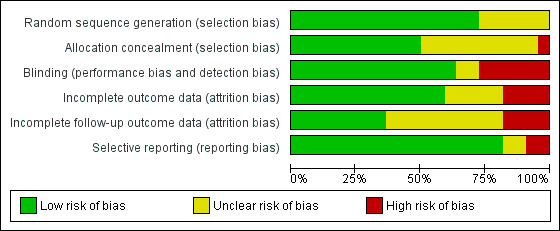
Risk of bias graph: review authors' judgements about each risk of bias item presented as percentages across all included studies
Comparisons with no acupuncture (acute treatment only or routine care)
Four trials (Facco 2008; Jena 2008; Linde K 2005; Vickers 2004) used adequate methods for allocation sequence generation and concealment of allocation when judged according to the Cochrane 'Risk of bias' tool (Higgins 2011). According to the definition of the ATC, three trials (Jena 2008; Linde K 2005; Vickers 2004) were "unambiguously adequately concealed". For the two other trials sequence generation was adequate but concealment was inadequate (Linde M 2000) or not fully adequate (Facco 2008). Given the comparison between acupuncture and no acupuncture, the participants (who were also assessing all relevant outcomes) were unblinded in all six trials. In consequence, bias could not be ruled out. The use of headache diaries to monitor symptoms closely over a long period of time (Linde K 2005; Linde M 2000; Vickers 2004) might be less prone to bias than the use of questionnaires with retrospective assessment of symptoms for the preceding weeks (Facco 2008; Jena 2008). Attrition in the first three months was high in Linde M 2000 and minor to moderate in the remaining trials. The analyses of Jena 2008, Linde K 2005 and Vickers 2004 took account of attrition, suggesting a low risk of bias. This also applied to the long‐term follow‐up in Vickers 2004. Facco 2008 presented only a per‐protocol analysis. Although presentation of results was not always optimal, we considered the risk of selective reporting to be low as the most important outcome measures were always presented and consistent. Overall, due to the lack of blinding in all studies there was some risk of performance and detection bias for this comparison.
Comparisons with sham interventions
We could not formally assess the quality of Alecrim 2005, for which only an abstract and additional unpublished information provided by the authors were available. Unpublished information provided by the authors and published information from the two other trials (Alecrim 2006; Alecrim 2008) conducted by the same group suggested that the risk of bias in this trial was low. Among the 13 trials formally assessed, the risk of bias regarding sequence generation was low for 10 (Alecrim 2006; Alecrim 2008; Ceccherelli 1992; Diener 2006; Facco 2008; Li 2012; Linde K 2005; Linde M 2004; Wang 2015; Zhao 2014) and unclear in five. Publications for five trials reported adequate methods of allocation concealment (Alecrim 2006; Alecrim 2008; Diener 2006; Li 2012; Linde K 2005); for a further two trials, such information was provided by the authors (Ceccherelli 1992; Facco 2008). All the trials attempted to blind participants. Several trials that used sham interventions which were not strictly indistinguishable from 'true' acupuncture (Ceccherelli 1992; Diener 2006; Facco 2008; Linde K 2005) did not mention explicitly the use of a sham or placebo control in the informed consent procedure. This is ethically problematic, but enhances the credibility of the sham interventions. Taking into account also the results of the trials, we considered the risk of bias to be low in all trials. Reporting of dropouts was insufficient in several older trials. We considered the risk of bias to be low regarding short‐term outcomes (up to three months) in nine trials (Alecrim 2006; Alecrim 2008; Diener 2006; Li 2012; Linde K 2005; Linde M 2004; Vincent 1989; Wang 2015; Zhao 2014), and low regarding long‐term outcomes in six (Alecrim 2008; Diener 2006; Li 2012; Linde K 2005; Linde M 2004; Wang 2015). For two trials (Weinschütz 1993; Weinschütz 1994) outcomes were reported so inadequately that selective reporting could not be ruled out. Overall, the risk of bias was variable, but, particularly in the three largest trials, good quality. However, as acupuncturists could not be blinded in any trial performance, bias could not be ruled out completely.
Comparisons with prophylactic drug treatment
Three trials (Allais 2002; Diener 2006; Streng 2006) used adequate methods for sequence generation and concealment, one trial reported an adequate method for sequence generation but insufficient detail regarding concealment (Facco 2013), and one trial (Hesse 1994) did not describe the methods. Four trials (Allais 2002; Diener 2006; Facco 2013; Streng 2006) compared acupuncture and drug treatment in an open manner, which implies that bias on this level is possible. The use of a double‐dummy technique allowed participant blinding in Hesse 1994, but this approach might be associated with other problems (see Discussion). While there is little risk of bias due to low attrition rates in Allais 2002 and Hesse 1994, and unclear risk in Facco 2013, a relevant problem occurred in the two German trials (Diener 2006; Streng 2006). The recruitment situation for these trials made it likely that participants had a preference for acupuncture. This resulted in a high proportion of participants allocated to drug treatment withdrawing informed consent immediately after randomisation (34% in Diener 2006 and 13% in Streng 2006), as well as high treatment discontinuation (18% in Diener 2006) or dropout rates due to adverse effects (16% in Streng 2006). These trials did not include participants refusing informed consent immediately after randomisation in analyses, and one (Streng 2006) also excluded early dropouts. Such analyses should normally tend to favour drug treatment. Both trials presented additional analyses restricted to participants complying with the protocol. All five trials presented the most important outcomes measured, so we considered the risk of bias of selective reporting to be low. Overall, as four of the trials were not blinded and two trials had a problem with relevant attrition in the drug group there is a considerable risk of bias (see also Discussion).
Effects of interventions
See: Table 1; Table 2; Table 3
Comparisons with no acupuncture (acute treatment only or routine care)
The five trials comparing acupuncture with a control group receiving either treatment of acute migraine attacks only or routine care are clinically very heterogeneous. Facco 2008 performed a four‐armed trial (n = 160) in which participants in the control group all received acute treatment of attacks with rizatriptan. Jena 2008 is a very large, highly pragmatic study which included a total of 15,056 headache sufferers recruited by more than 4000 physicians in Germany. A total of 11,874 people not giving consent to randomisation received up to 15 acupuncture treatments within three months and were followed for an additional three months. This was also the case for 1613 participants randomized to immediate acupuncture, while the remaining 1569 participants remained on routine care (not further defined) for three months and then received acupuncture. The published analysis of this trial is on all randomized participants, but we received unpublished results of subgroup analyses on the 1715 participants with migraine from the study authors for the previous version of our review and we re‐analysed the data from the ATC for this update. Linde M 2000 was a small pilot trial (n = 39) performed in a specialized migraine clinic in Sweden in which control participants continued with their individualized treatment of acute attacks but did not receive additional acupuncture. A similar approach was used for the waiting‐list control group in the three‐armed (also sham control group) Linde K 2005 (n = 302) trial. Finally, in the Vickers 2004 trial (n = 401), acupuncture in addition to routine care in the British National Health Service was compared to a strategy, 'avoid acupuncture'. In addition to the strong clinical heterogeneity, the methods and timing of outcome measurement in these trials also differed considerably.
Therefore, pooled effect size estimates have to be interpreted with caution. Nevertheless, the findings show that acupuncture treatment is associated with a moderately large short‐term benefit compared to no acupuncture control groups (Figure 4; Figure 5).
4.
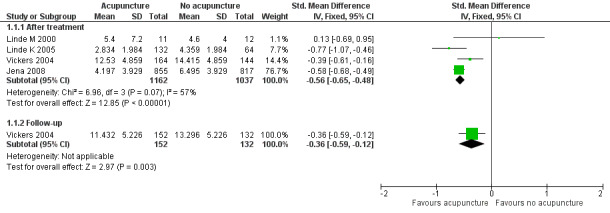
Forest plot of comparison: 1 Acupuncture vs. no acupuncture, outcome: 1.1 Headache frequency
5.
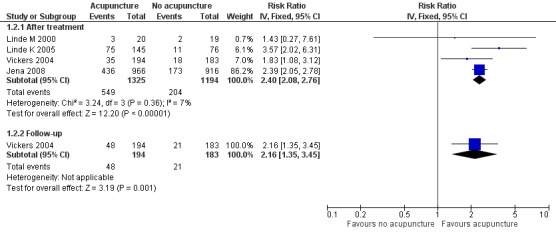
Forest plot of comparison: 1 Acupuncture vs. no acupuncture, outcome: 1.2 Response (at least 50% frequency reduction)
Among the four trials providing sufficient data the pooled fixed‐effects standardized mean difference (SMD) was ‐0.56 (95% CI ‐0.65 to ‐0.48; 2199 participants); findings were statistically heterogeneous (P value = 0.07; I² = 57%; random‐effects estimate ‐0.53; 95% CI ‐0.72 to ‐0.34).
After treatment, headache frequency at least halved in 41% of participants receiving acupuncture and 17% receiving no acupuncture. The fixed effects risk ratio (RR) was 2.40 (95% CI 2.08 to 2.76; 4 trials, 2519 participants); there was no indication of statistical heterogeneity (P value = 0.36; I² = 7%). We consider these findings after treatment as moderate quality evidence because as the large trials consistently show clinically relevant differences, in spite of the risk of bias due to lack of blinding, we found some indication of heterogeneity (headache frequency) and clinical differences between trials. The corresponding number needed to treat for an additional beneficial outcome (NNTB) was 4 (95% CI 3 to 6). There was only one trial with a follow‐up beyond three months (Vickers 2004; 12 month follow‐up). The SMD (frequency) was ‐0.36 (95% CI ‐0.59 to ‐0.12; 284 participants with data) and the RR for response was 2.16 (95% CI 1.35 to 3.45; 377 participants). The NNTB based on this trial was 7 (95% CI 4.00 to 25.00; proportion of participants with response in the sham group 11%). Although the trial was large we consider its long‐term findings to be low quality evidence as, given the variable effect sizes after treatment in the available trials, future trials performed in different settings might well yield different effect sizes. Findings in the time window analyses are consistent with those of the main analysis (Analysis 1.3; Analysis 1.4). The single specific frequency outcomes, migraine attacks, migraine days and headache days were not measured or reported in any trials but findings were consistent with those in our primary outcome, headache frequency (Analysis 1.5; Analysis 1.6; Analysis 1.7). This also applies to the outcomes headache intensity, analgesic use and headache scores (Analysis 1.8; Analysis 1.9; Analysis 1.10). We did not explore reasons for heterogeneity due to the small number of trials.
1.3. Analysis.
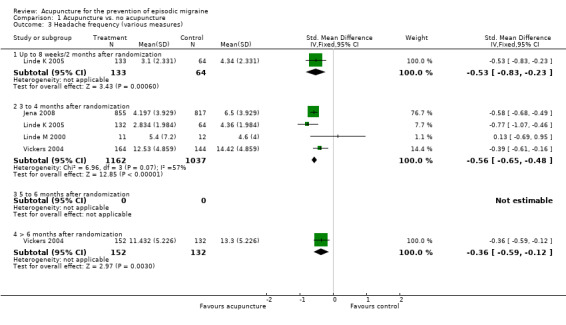
Comparison 1 Acupuncture vs. no acupuncture, Outcome 3 Headache frequency (various measures).
1.4. Analysis.
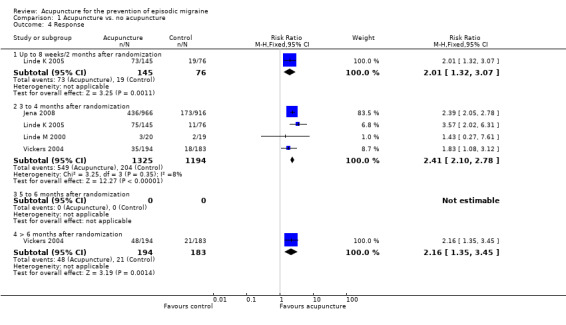
Comparison 1 Acupuncture vs. no acupuncture, Outcome 4 Response.
1.5. Analysis.
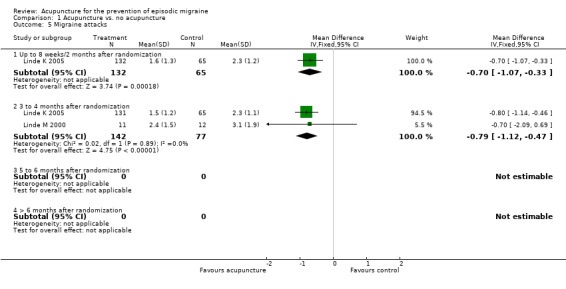
Comparison 1 Acupuncture vs. no acupuncture, Outcome 5 Migraine attacks.
1.6. Analysis.

Comparison 1 Acupuncture vs. no acupuncture, Outcome 6 Migraine days.
1.7. Analysis.
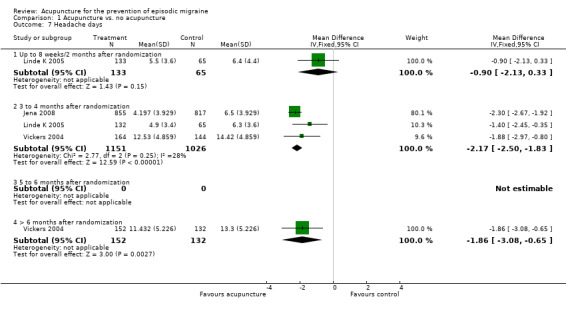
Comparison 1 Acupuncture vs. no acupuncture, Outcome 7 Headache days.
1.8. Analysis.
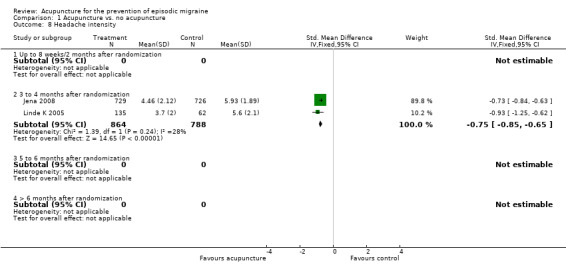
Comparison 1 Acupuncture vs. no acupuncture, Outcome 8 Headache intensity.
1.9. Analysis.
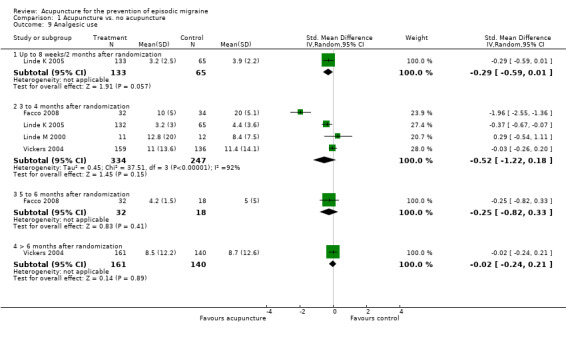
Comparison 1 Acupuncture vs. no acupuncture, Outcome 9 Analgesic use.
1.10. Analysis.
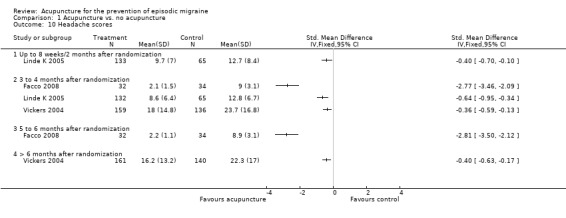
Comparison 1 Acupuncture vs. no acupuncture, Outcome 10 Headache scores.
The number of participants not reaching the primary endpoint was slightly lower in acupuncture than in non‐acupuncture groups (OR 0.69; 95% CI 0.46 to 1.05); there was some heterogeneity (P value = 0.13; I² = 47%). In the two trials reporting reasons for attrition there were no dropouts due to adverse effects. Information on other safety/acceptability outcomes was reported insufficiently (see Analysis 1.11).
1.11. Analysis.
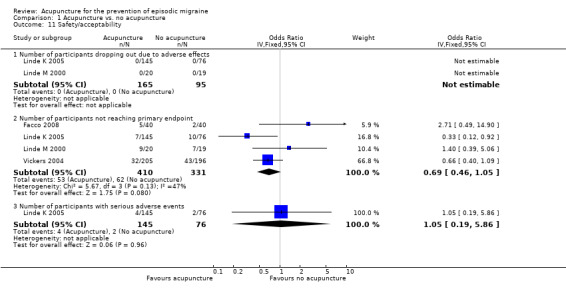
Comparison 1 Acupuncture vs. no acupuncture, Outcome 11 Safety/acceptability.
Comparisons with sham interventions
Both after treatment (12 trials providing data from 1646 participants) and at follow‐up (10 trials, 1534 participants) acupuncture was associated with a small but statistically significant frequency reduction over sham in the fixed‐effect analyses (Figure 6). The SMD was ‐0.18 (95% ‐0.28 to ‐0.08; P value from the Chi² test for heterogeneity = 0.04, I² = 47%) after treatment and ‐0.19 (95% ‐0.30 to ‐0.09; P value from the Chi² test for heterogeneity = 0.01, I² = 59%) at follow‐up. The results of the random‐effects models were similar (SMD ‐0.24; 95% CI ‐0.41 to ‐0.07 for post‐treatment, SMD‐0.16; 95% CI ‐0.37 to 0.04 at follow‐up).
6.
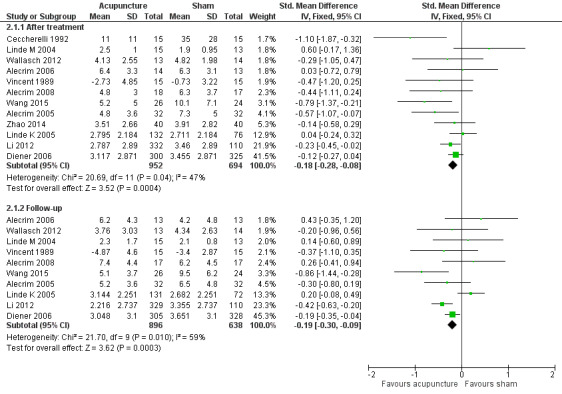
Forest plot of comparison: 2 Acupuncture vs. sham interventions, outcome: 2.1 Headache frequency
After treatment, headache frequency at least halved in 50% of participants receiving true acupuncture and 41% receiving sham acupuncture (pooled RR 1.23, 95% CI 1.11 to 1.36; P value = 0.02, I² = 48%; 14 trials, 1825 participants) and at follow‐up in 53% and 42%, respectively. The pooled fixed effects RR was 1.23 (95% CI 1.11 to 1.36; P value from the Chi² test for heterogeneity = 0.02, I² = 48%; 14 trials, 1825 participants) after treatment and 1.25 (95% CI 1.13 to 1.39; P value from the Chi² test for heterogeneity = 0.004, I² = 61%; 11 trials, 1683 participants) at follow‐up (Figure 7). The corresponding NNTB would be 11 (95% CI 7.00 to 20.00) after treatment and 10 (95% CI 6.00 to 18.00) at follow‐up. Random‐effects RRs were 1.39 (95% CI 1.14 to 1.69) and 1.33 (95% CI 1.05 to 1.70). The results were dominated by the three large, high‐quality trials (Diener 2006; Li 2012; Linde K 2005; 75% and 82% weight, respectively, in the meta‐analyses). We consider the findings for the outcomes headache frequency and response both after treatment and at follow‐up as moderate quality evidence (indication of heterogeneity and small effect sizes leaving magnitude and statistical significance of effect open to some change with more trials). The time windows analyses yielded findings which were consistent with our main analyses (Analysis 2.3; Analysis 2.4). Specific frequency outcomes as well as intensity, analgesic use and headache scores were typically available for less than half of the trials (Analysis 2.5; Analysis 2.6; Analysis 2.7; Analysis 2.8; Analysis 2.9; Analysis 2.10).
7.

Forest plot of comparison: 2 Acupuncture vs. sham interventions, outcome: 2.2 Response (at least 50% frequency reduction)
2.3. Analysis.
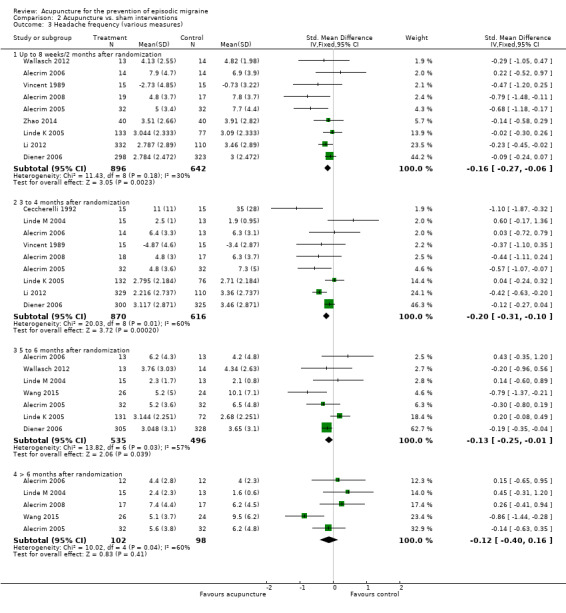
Comparison 2 Acupuncture vs. sham interventions, Outcome 3 Headache frequency (various measures).
2.4. Analysis.
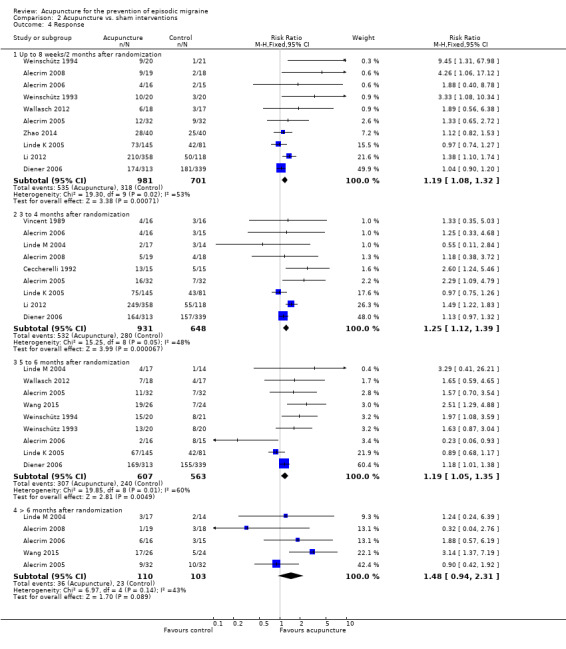
Comparison 2 Acupuncture vs. sham interventions, Outcome 4 Response.
2.5. Analysis.
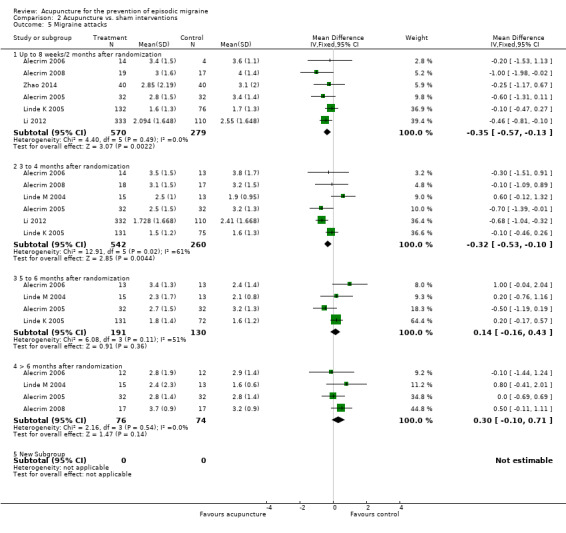
Comparison 2 Acupuncture vs. sham interventions, Outcome 5 Migraine attacks.
2.6. Analysis.
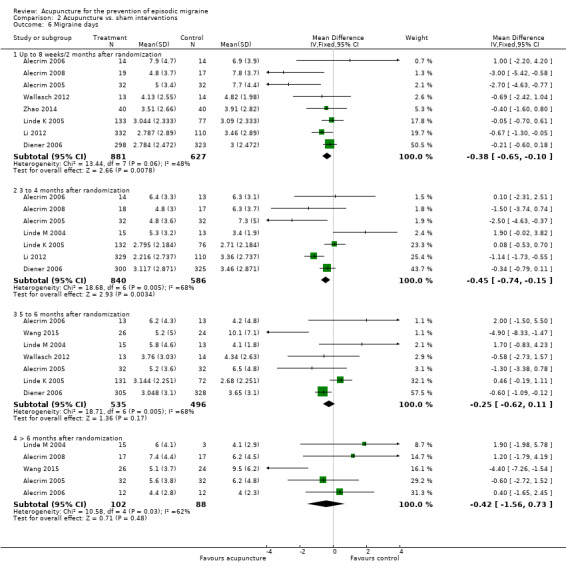
Comparison 2 Acupuncture vs. sham interventions, Outcome 6 Migraine days.
2.7. Analysis.
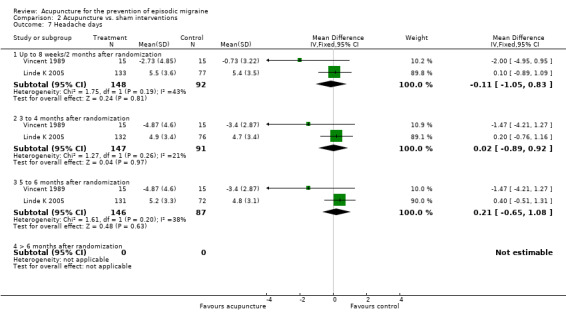
Comparison 2 Acupuncture vs. sham interventions, Outcome 7 Headache days.
2.8. Analysis.
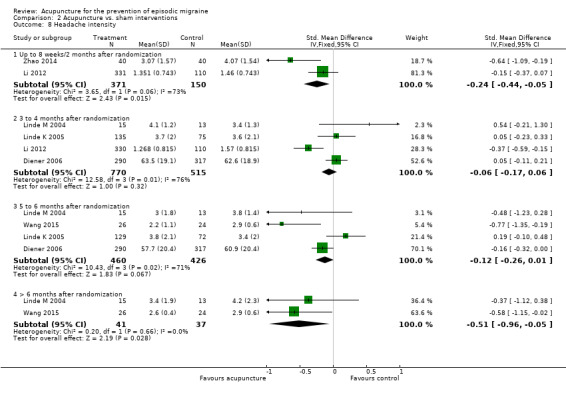
Comparison 2 Acupuncture vs. sham interventions, Outcome 8 Headache intensity.
2.9. Analysis.
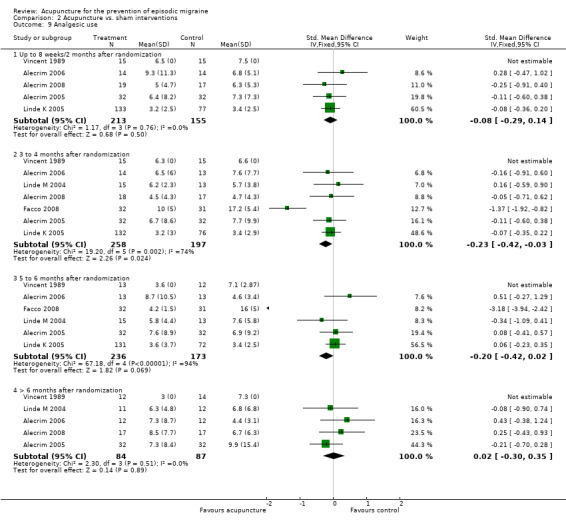
Comparison 2 Acupuncture vs. sham interventions, Outcome 9 Analgesic use.
2.10. Analysis.
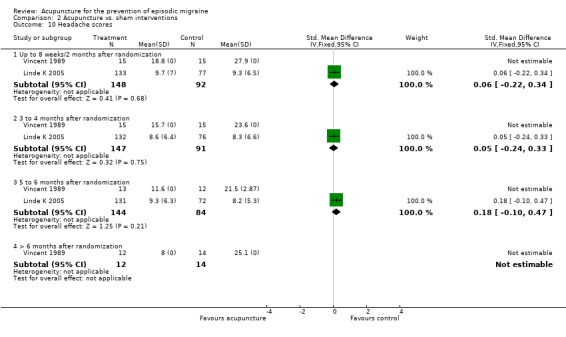
Comparison 2 Acupuncture vs. sham interventions, Outcome 10 Headache scores.
We performed subgroup analyses to investigate four potential sources of heterogeneity for both frequency and response, both after treatment and follow‐up (four analyses for each potential source of heterogeneity). While there were suggestions of subgroup differences, heterogeneity tended to remain considerable in most subgroups across analyses. Effects of acupuncture over sham were significantly smaller in the three unambiguously adequately concealed trials (which were also by far the three largest trials) than in the remaining trials in three (Analysis 2.11; Analysis 2.13Analysis 2.14) of four analyses (no significant difference in Analysis 2.12). In the analyses grouping trials into smaller and larger (number of participant up to or above the median number of participants in the trials included in the analysis) studies' differences tended to be somewhat smaller in larger trials but these findings were mainly driven by the three larger, unambiguously adequately concealed trials (Analysis 2.15; Analysis 2.16; Analysis 2.17; Analysis 2.22). Consistently, effects over sham tended to be larger in trials with 16 or more treatment sessions compared to trials with up to 12 sessions ( Analysis 2.18; Analysis 2.19; Analysis 2.20; Analysis 2.21;). Effects also tended to be somewhat larger in trials using non‐penetrating sham techniques, however, only three relatively small trials used such sham techniques (Analysis 2.23; Analysis 2.24; Analysis 2.25; Analysis 2.26). Re‐including the five trials excluded for this update (but included in the previous version of this review) had only minimal impact on results.
2.11. Analysis.
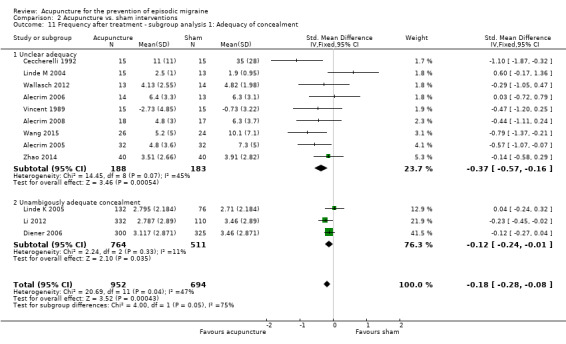
Comparison 2 Acupuncture vs. sham interventions, Outcome 11 Frequency after treatment ‐ subgroup analysis 1: Adequacy of concealment.
2.13. Analysis.
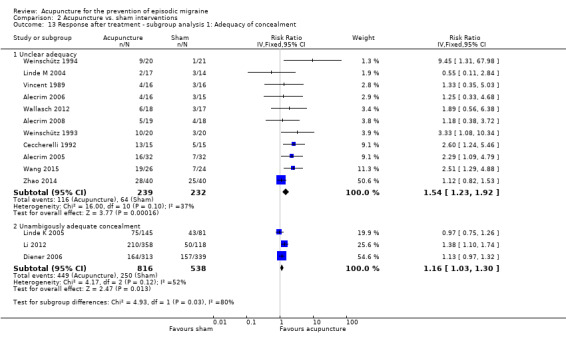
Comparison 2 Acupuncture vs. sham interventions, Outcome 13 Response after treatment ‐ subgroup analysis 1: Adequacy of concealment.
2.14. Analysis.
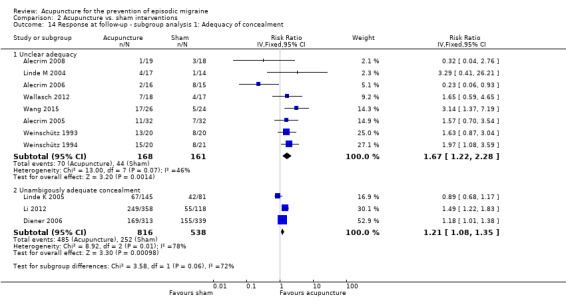
Comparison 2 Acupuncture vs. sham interventions, Outcome 14 Response at follow‐up ‐ subgroup analysis 1: Adequacy of concealment.
2.12. Analysis.
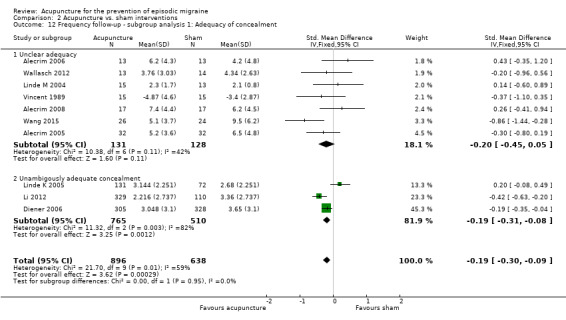
Comparison 2 Acupuncture vs. sham interventions, Outcome 12 Frequency follow‐up ‐ subgroup analysis 1: Adequacy of concealment.
2.15. Analysis.
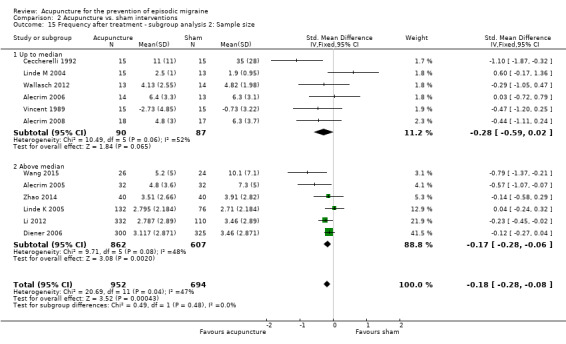
Comparison 2 Acupuncture vs. sham interventions, Outcome 15 Frequency after treatment ‐ subgroup analysis 2: Sample size.
2.16. Analysis.
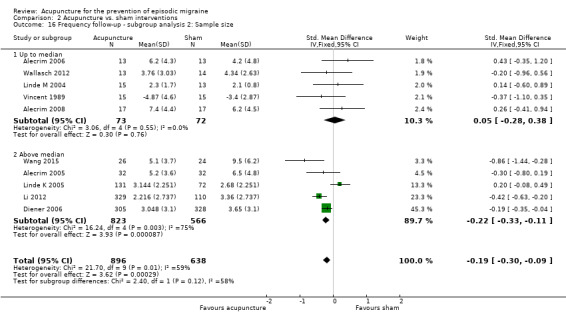
Comparison 2 Acupuncture vs. sham interventions, Outcome 16 Frequency follow‐up ‐ subgroup analysis 2: Sample size.
2.17. Analysis.
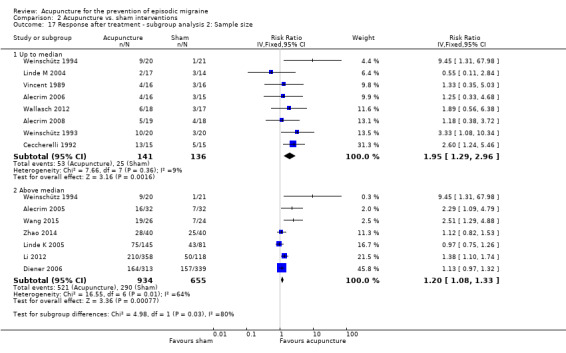
Comparison 2 Acupuncture vs. sham interventions, Outcome 17 Response after treatment ‐ subgroup analysis 2: Sample size.
2.22. Analysis.
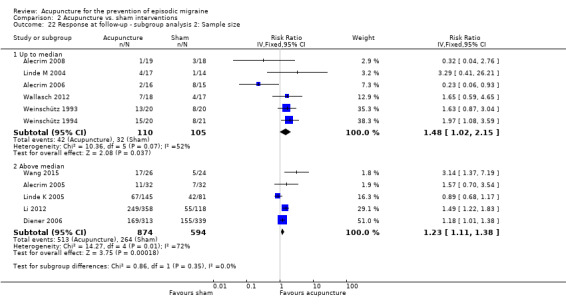
Comparison 2 Acupuncture vs. sham interventions, Outcome 22 Response at follow‐up ‐ subgroup analysis 2: Sample size.
2.18. Analysis.
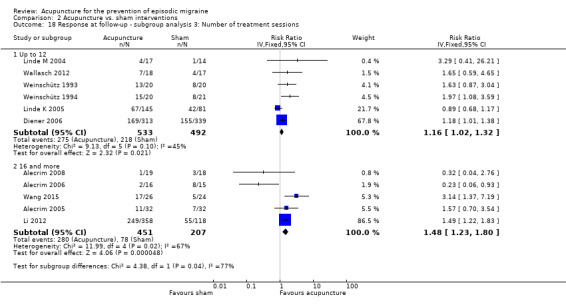
Comparison 2 Acupuncture vs. sham interventions, Outcome 18 Response at follow‐up ‐ subgroup analysis 3: Number of treatment sessions.
2.19. Analysis.
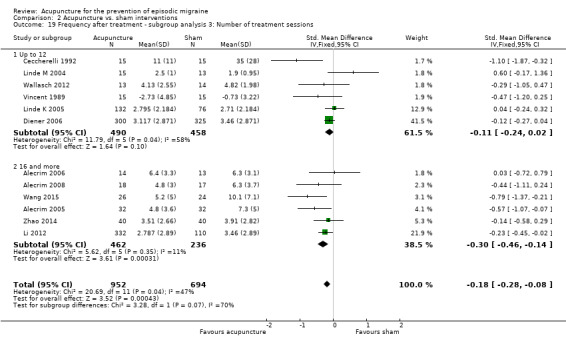
Comparison 2 Acupuncture vs. sham interventions, Outcome 19 Frequency after treatment ‐ subgroup analysis 3: Number of treatment sessions.
2.20. Analysis.
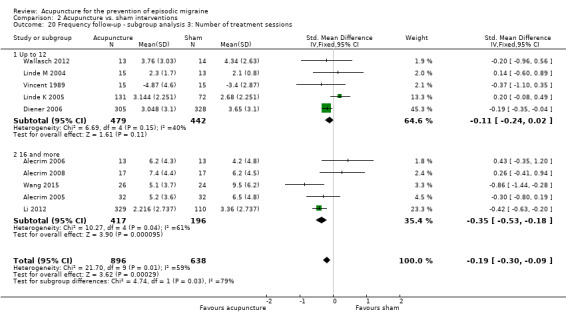
Comparison 2 Acupuncture vs. sham interventions, Outcome 20 Frequency follow‐up ‐ subgroup analysis 3: Number of treatment sessions.
2.21. Analysis.
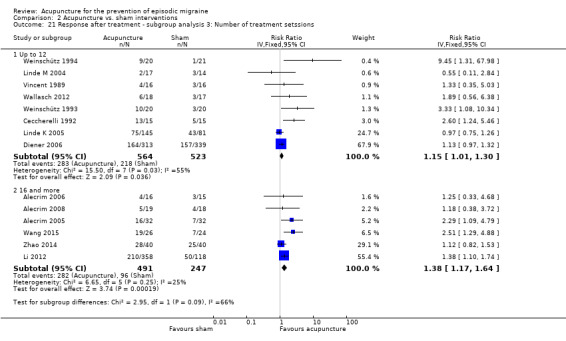
Comparison 2 Acupuncture vs. sham interventions, Outcome 21 Response after treatment ‐ subgroup analysis 3: Number of treatment setssions.
2.23. Analysis.
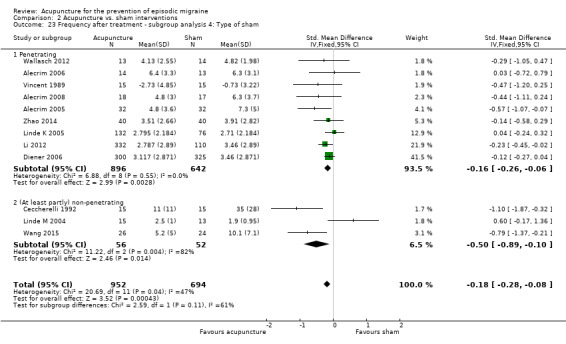
Comparison 2 Acupuncture vs. sham interventions, Outcome 23 Frequency after treatment ‐ subgroup analysis 4: Type of sham.
2.24. Analysis.
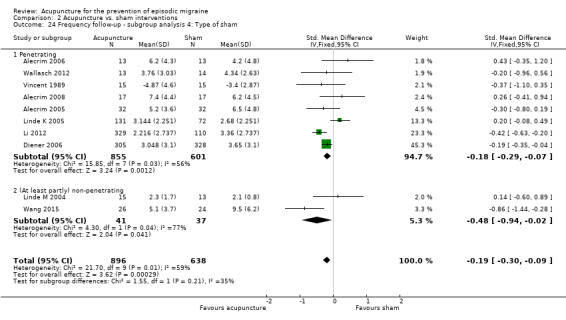
Comparison 2 Acupuncture vs. sham interventions, Outcome 24 Frequency follow‐up ‐ subgroup analysis 4: Type of sham.
2.25. Analysis.
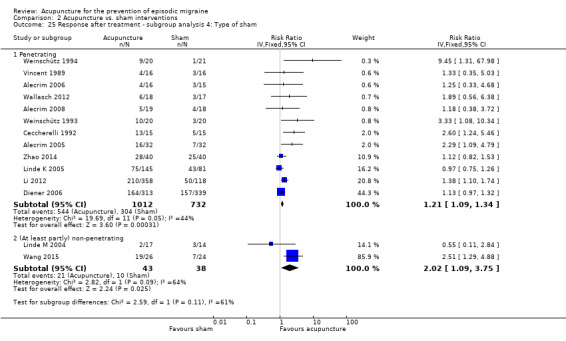
Comparison 2 Acupuncture vs. sham interventions, Outcome 25 Response after treatment ‐ subgroup analysis 4: Type of sham.
2.26. Analysis.
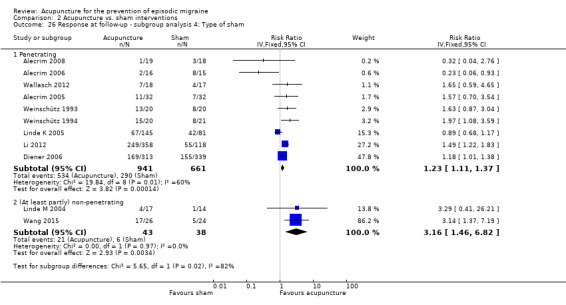
Comparison 2 Acupuncture vs. sham interventions, Outcome 26 Response at follow‐up ‐ subgroup analysis 4: Type of sham.
In the seven trials reporting this outcome only three of 621 participants receiving acupuncture and none of 310 in control groups dropped out due to adverse effects (OR 2.84; 95% CI 0.43 to 18.71; 7 trials, 931 participants; I² = 0%). We consider this low quality evidence as there is great uncertainty regarding the effect estimate due to the very small number of such dropouts. Only the four largest trials reported the number of participants reporting adverse effects. Among 847 participants receiving acupuncture 138 (16%) reported adverse effects compared to 98 (17%) receiving sham (OR 1.15; 95% CI 0.85 to 1.56; I² = 0%; moderate quality evidence; Analysis 2.27). There were also no significant differences in the number of participants not reaching the primary endpoint of the trial (OR 1.14; 95% CI 0.78 to 1.67; 11 trials, 1770 participants) and experiencing serious adverse events (OR 1.29; 95% CI 0.43 to 3.83; 6 trials, 1071 participants; Analysis 2.27).
2.27. Analysis.
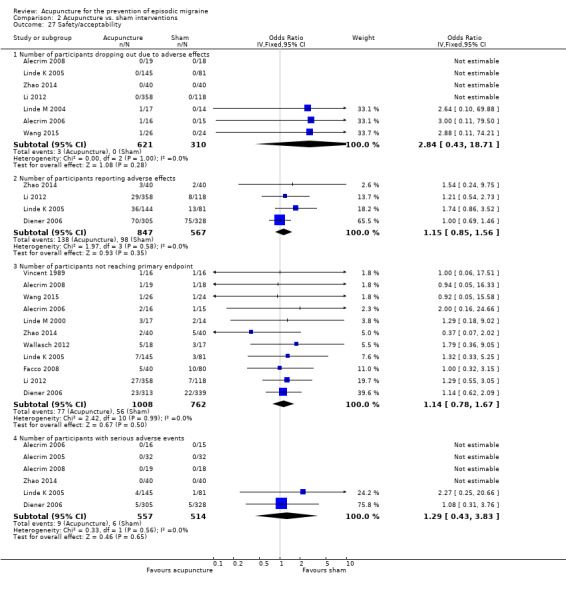
Comparison 2 Acupuncture vs. sham interventions, Outcome 27 Safety/acceptability.
Comparisons with prophylactic drug treatment
The results of Hesse 1994 regarding treatment effectiveness were not reported in a manner that allowed effect size estimation. Overall, the findings of this trial, which used a double‐dummy design (true acupuncture plus metoprolol placebo versus sham acupuncture plus metoprolol), showed similar improvements in both groups, slightly favouring the sham acupuncture plus metoprolol group. The acupuncture technique used in this trial (very brief needling of individual trigger points) was rather unusual and was considered with skepticism by our acupuncturists. The pragmatic trial, Facco 2013, which compared a traditional acupuncture strategy with valproic acid, did not use a headache diary, but only a questionnaire including the Migraine Disability (MIDAS) instrument (Stewart 2001). Participants were asked to report the number of headache days over periods of three months. The publication reported very large improvements (the median number of headache days went down from 18 days before the trial, to four days during the treatment phase and during the follow‐up phase in the acupuncture group, and from 17 to three and six days in the group receiving valproic acid), and very little variation (narrow interquartile ranges). The first author provided means and standard deviations, but standard deviations were very small. As we were uncertain about the reliability of the data we decided to not include it in meta‐analysis.
The remaining three trials could be entered into meta‐analyses. Acupuncture reduced migraine frequency significantly more than drug prophylaxis after treatment (SMD ‐0.25; 95% CI ‐0.39 to ‐0.10; 739 participants) while differences were smaller at follow‐up and were not significantly different (SMD ‐0.13; 95% CI ‐0.28 to 0.01; P value = 0.08; 744 participants; see Figure 8).
8.
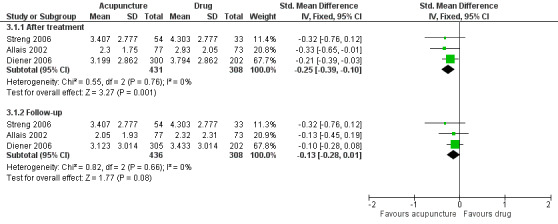
Forest plot of comparison: 3 Acupuncture vs. prophylactic drug treatment, outcome: 3.1 Headache frequency
Findings were similar for response (Figure 9). After a median follow‐up of three months headache frequency at least halved in 57% of participants receiving acupuncture and 46% receiving prophylactic drugs, and after six months in 59% and 54%, respectively. The RR was 1.24 (95% CI 1.08 to 1.44; 743 participants) after treatment and 1.11 (95% CI 0.97 to 1.26; 744 participants) at follow‐up. Findings were consistent among trials with P values from the Chi² test for heterogeneity being above 0.5 and I² being 0% in all analyses. While there was risk of bias due to lack of blinding in all three trials and relevant attrition in two trials, and future trials might not confirm the small effects of acupuncture over prophylactic drug treatment, we consider the highly consistent trial findings for both outcomes and both time points as moderate quality evidence that acupuncture is non‐inferior to prophylactic drug treatment.The time window analyses are consistent with these findings as are the findings on additional outcomes (Analysis 3.5; Analysis 3.6; Analysis 3.7; Analysis 3.8; Analysis 3.9; Analysis 3.10).
9.

Forest plot of comparison: 3 Acupuncture vs. prophylactic drug treatment, outcome: 3.2 Response (at least 50% frequency reduction)
3.5. Analysis.
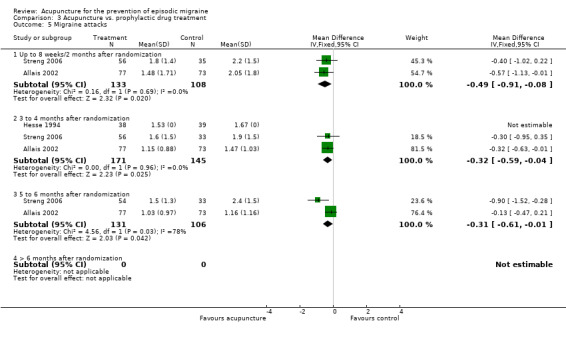
Comparison 3 Acupuncture vs. prophylactic drug treatment, Outcome 5 Migraine attacks.
3.6. Analysis.
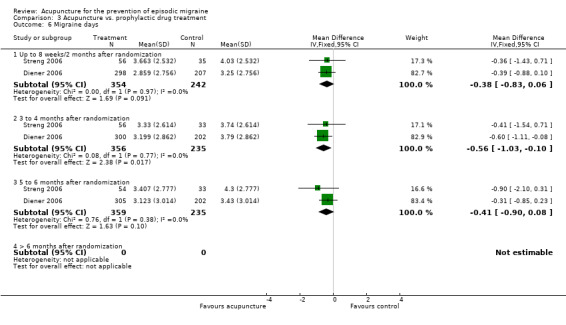
Comparison 3 Acupuncture vs. prophylactic drug treatment, Outcome 6 Migraine days.
3.7. Analysis.
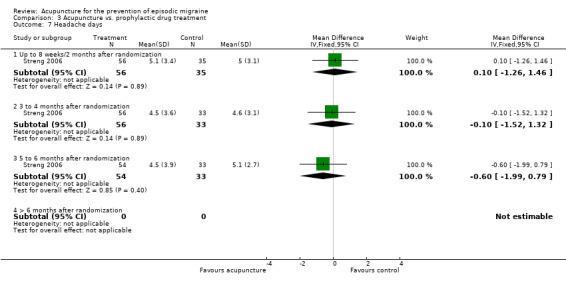
Comparison 3 Acupuncture vs. prophylactic drug treatment, Outcome 7 Headache days.
3.8. Analysis.
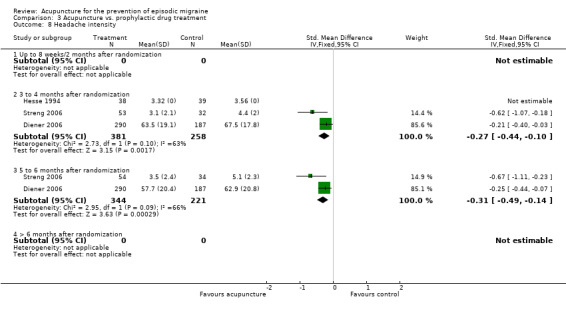
Comparison 3 Acupuncture vs. prophylactic drug treatment, Outcome 8 Headache intensity.
3.9. Analysis.
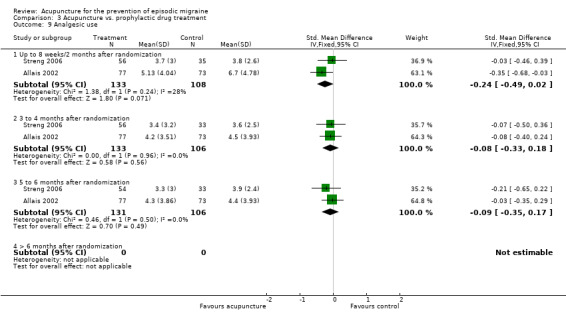
Comparison 3 Acupuncture vs. prophylactic drug treatment, Outcome 9 Analgesic use.
3.10. Analysis.
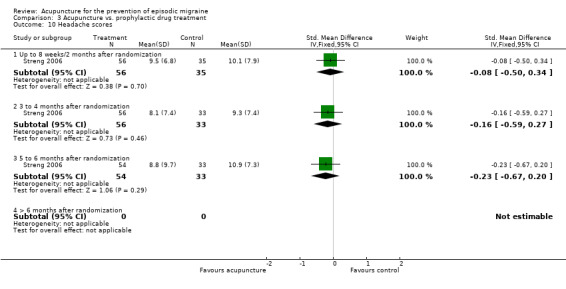
Comparison 3 Acupuncture vs. prophylactic drug treatment, Outcome 10 Headache scores.
In the four studies reporting this outcome three (1%) of 227 participants receiving acupuncture dropped out due to adverse effects compared to 16 (7%) receiving prophylactic drugs (OR 0.27; 95% CI 0.08 to 0.86; I² = 0%; Analysis 3.11). All five trials provided the number of participants reporting adverse effects. Probably due to different methods for documenting this outcome the absolute frequency of adverse effects in both groups varied greatly between trials. A total of 90 (17%) of 520 participants receiving acupuncture reported adverse effects compared to 140 (34%) of 411 participants receiving prophylactic drug treatment (OR 0.25; 95% CI 0.10 to 0.62; I² = 78%, P value from Chi² test for heterogeneity = 0.001). Despite some limitations (uncertainty regarding dropouts due to low event rates and heterogeneity regarding reporting of adverse effects) we consider this moderate quality evidence as study findings consistently favour acupuncture over prophylactic drug treatment. Furthermore, study findings also favoured acupuncture for the number of participants not reaching the primary endpoint (OR 0.28; 95% CI 0.10 to 0.78; 4 trials, 995 participants; I² = 80%; P value = 0.002). Serious adverse events were reported in seven (2%) of 313 participants receiving acupuncture compared to four (1%) of 307 participants receiving prophylactic drugs (OR 1.33; 95% CI 0.38 to 4.73; 4 trials; I² = 0%).
3.11. Analysis.
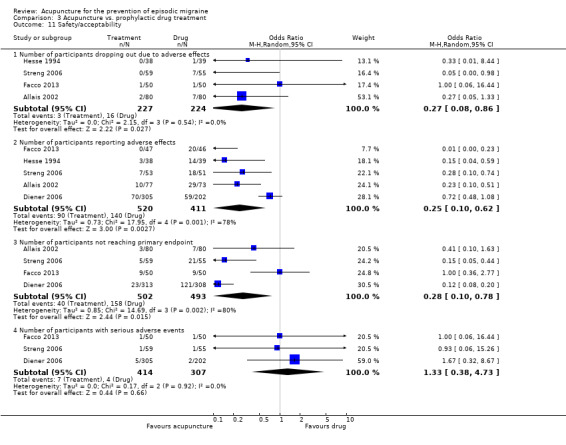
Comparison 3 Acupuncture vs. prophylactic drug treatment, Outcome 11 Safety/acceptability.
Discussion
Summary of main results
Several trials using quite variable methods and interventions consistently showed that the addition of acupuncture to treatment of acute migraine attacks or to routine care was beneficial for at least three months. Compared to no treatment or routine care only (which includes treatment of acute migraine attacks and possibly other interventions) the size of the effect seemed to be moderate according to usual standards for classifying effect size measures such as standardized mean differences. The only trial that investigated long‐term effects showed a sustained small to moderate response to acupuncture in addition to routine care provided by a GP (Vickers 2004). Compared to sham acupuncture, true acupuncture interventions were associated with small but statistically significant effects both after treatment and at follow‐up, but findings were statistically heterogeneous. In the largest, adequately concealed trials differences were even smaller (but still statistically significant). The pooled analyses of the available trials comparing acupuncture interventions with evidence‐based prophylactic drug treatment found a superiority of acupuncture at completion of treatment, though at follow‐up differences were no longer statistically significant. Compared to drug prophylaxis fewer participants dropped out due adverse effects or reported adverse effects.
Possible explanations of the findings
The interpretation of the findings of our review remains challenging. While, contrary to the results of the previous version of our review, differences between true acupuncture and sham interventions became statistically significant (after the inclusion of four new sham‐controlled trials), it seems still surprising that the size of the effect over sham is similar to that over prophylactic treatment with drugs that have been shown to be superior to placebo (Schürks 2008). Three factors could explain these findings (probably in combination). Firstly, sham acupuncture might have direct physiological effects on mechanisms relevant to migraine symptoms, secondly, acupuncture might be a particularly potent placebo, and thirdly, due to the lack of blinding, comparisons with routine care and prophylactic drug treatment might be biased.
We consider each of these possible explanations in turn.
Physiological effects of sham acupuncture
Many sham acupuncture procedures involve needling locations that are not traditional points with the same frequency and duration as in the true acupuncture group. In some studies needles are inserted into classical acupuncture points not indicated in migraine. Most physiological mechanisms proposed for acupuncture do not necessarily imply point specificity (Bäcker 2004). Even the non‐penetrating 'placebo' needles might activate unmyelinated (C 'tactile') afferent nerves which can influence pain perception (Lund 2006). Several researchers have argued that some effects of acupuncture might not be point‐specific (Han 1997; Lundeberg 2007), and that these might be particularly relevant for treating conditions other than localized nociceptive pain (Thomas 1996; Borud 2010). In individual patient data meta‐analysis, acupuncture was significantly superior to all categories of control group. For trials that used penetrating needles for sham control, acupuncture had smaller effect sizes than for trials with non‐penetrating sham or sham control without needles (MacPherson 2014).
Sham acupuncture as a strong placebo
According to the available evidence, the most important mechanisms for placebo effects are expectations, conditioning, anxiety reduction and social support (Crow 1999; Benedetti 2008). These elements are likely to be influenced by the treatment setting, its context and its meaning. Acupuncture ‐ with its repeated sessions, intense provider contact, slightly painful procedure, an often 'exotic' model of symptom explanation and associated relaxation during sessions ‐ might maximize such effects.
While the average clinical effect of placebo interventions seems to be small (Hróbjartsson 2010), there is some evidence that sham acupuncture is associated with larger effects than, for example, a placebo pill or other non‐pharmacological sham interventions. This evidence comes from one of the few randomized trials directly comparing different types of placebo (Kaptchuk 2006), from indirect comparison of trials including both a sham and a no‐treatment control (Linde 2010a), and from a network meta‐analysis of pharmacological and non‐pharmacological treatments and their placebos in migraine prophylaxis (Meissner 2013). Furthermore, a systematic review of randomized trials of acupuncture including both a sham and a no‐treatment control found on average moderately large (SMD 0.45) differences (Linde 2010b). It seems highly plausible that both the physiological and strong placebo effects contribute to these considerable 'non‐specific' effects of sham acupuncture. For example, a recent trial showed that the size of the effect associated with a sham acupuncture intervention can vary with the amount and characteristics of the patient‐provider interaction (Kaptchuk 2008). Both the above explanations would also imply that it would be difficult to detect any small, point‐specific effects in addition to potent placebo effects and non‐specific needling effects.
Possible bias due to lack of blinding
While participants in the sham‐controlled trials were blinded, this was (with the exception of the trial by Hesse 1994) not the case for the comparisons with treatment of acute migraine attacks only, routine care or other treatments. All clinically relevant outcome measures in clinical trials in migraine are patient‐reported (IHS 2000; IHS 2012). Preferably, outcomes are documented in diaries for at least four weeks before treatment and for longer time periods during and after treatment. It cannot be ruled out that participants allocated to acupuncture reported positively biased outcomes, while participants allocated to control reported negatively biased outcomes. However, response rates in participants allocated to drug treatment in the trials included in this review were comparable to those reported in drug trials (Van der Kuy 2002). Also, in groups receiving acute treatment only, response rates were within the range of placebo groups in drug trials (Van der Kuy 2002). In two trials comparing acupuncture and drug treatment (Diener 2006; Streng 2006), a relevant proportion of participants withdrew informed consent immediately after allocation to drug treatment. Additional participants dropped out during the study. This indicates that study participants had a preference for acupuncture. These problems could seriously bias the findings. However, participants not starting treatment were not included in the analyses, and per‐protocol analyses confirmed the study findings. Still, these trials must be interpreted with caution.
A fourth possible explanation for the lack of larger effects of true acupuncture over sham comes from the perspective of acupuncture practitioners. The quality of acupuncture interventions in clinical trials is often disputed. Study protocols often limit the flexibility of treatment procedures, particularly in sham‐controlled trials, and it is argued that better acupuncturists would have achieved better results. However, response rates in sham‐controlled trials were on average similar to those in pragmatic trials with flexible treatments. Furthermore, while there is always the possibility that some expert acupuncturists are particularly successful, in several of the larger trials included in this review the training of treatment providers was at least comparable to that of the average acupuncturists in their country. Still, it cannot be ruled out that inadequate study interventions contribute to the lack of differences compared to sham interventions.
Overall completeness and applicability of evidence
Acupuncture is a therapy which is applied in a variable manner in different countries and settings. For example, in Germany, where the majority of the large trials included in this review were performed, acupuncture is mainly provided by general practitioners and other physicians. Their approach to acupuncture is based on the theories of traditional Chinese medicine, although the amount of training they receive in traditional Chinese medicine is limited (Weidenhammer 2007). In the UK, the providers are likely to be non‐medical acupuncturists with a comparatively intense traditional training, physiotherapists or medical doctors with a more 'Western' approach (Dale 1997). The trials included in our review come from a variety of countries, and study designs range from very pragmatic (Jena 2008; Vickers 2004) to more experimental (Linde M 2004). Despite this distinct heterogeneity, within comparisons the findings seem broadly consistent.
Acupuncture is widely used in Asian countries, particularly China. We have not systematically searched Chinese databases for this version of the review, but plan to do so in the future. There is considerable skepticism toward clinical trials from China, as in the past results were almost exclusively positive (Vickers 1998). However, the quality and number of randomized trials published in Chinese have improved over recent years (Wang 2007), and it seems inadequate to neglect this evidence without examining it critically. Most of the identified, registered ongoing trials originate from China. Our update search (in non‐Chinese databases) identified a number of trials from China but only two met inclusion criteria (Li 2012; Zhao 2014). When reading excluded trials we noticed several characteristics which suggest that at least some migraine studies from China are different and problematic from the point of view of Western headache research. Excluded trials often included participants with recent‐onset of migraine, given acupuncture with the aim of 'curing' the condition. These trials seem hardly comparable to the many trials that included participants who had been suffering from migraine for a long time. Furthermore, most trials, including a group receiving prophylactic drugs, gave these only for four weeks, a period considered much too short by Western headache specialists (IHS 2012). Chinese trials also tend to use a higher number of treatment sessions and higher treatment frequency.
Large‐scale observational studies (Jena 2008; Melchart 2006) and a systematic comparison of findings from a randomized and an observational study (Linde 2007a) suggest that the response rates observed in clinical trials are also seen in conditions similar to routine practice. However, as the overall evidence also suggests that factors other than the correct selection of acupuncture points and needling procedures play an important role in outcomes, treatment setting and participant selection could have a strong impact and might vary considerably. For example, a pooled analysis of four trials on chronic pain (including Linde K 2005) found that even four months after completion of treatment, participants who had started acupuncture with a positive attitude and expectation had significantly better outcomes than participants with lower expectations (Linde 2007b).
People with migraine typically suffer from their headaches over many years. A general shortcoming of almost all randomized trials of any prophylactic treatments is their limited duration (rarely ever more than 12 months). Therefore, based on our review nothing can be said on sustainability of effects beyond 12 months.
Quality of the evidence
The methodological quality of the included trials was variable. Methods for sequence generation, allocation concealment, handling of dropouts and withdrawals and reporting of findings were adequate in most of the recent trials. Still, designing and performing clinical trials of acupuncture is a challenge, particularly with respect to blinding and selection of control interventions. We have mentioned that bias cannot be ruled out in the unblinded studies, and that comparisons with prophylactic drug treatment have to be interpreted with caution due to high dropout rates in two of the trials. Blinding in comparisons with drug treatment could be achieved by double‐dummy designs (drug plus sham acupuncture versus acupuncture plus drug placebo) as in the trials by Hesse 1994. However, if it is the case that sham acupuncture interventions are strong placebos and not physiologically inert, this approach would also be problematic.
We considered the overall quality of the evidence for most outcomes to be moderate. Reasons for not considering the quality of evidence to be high were lack of blinding of participants (for comparisons with no acupuncture controls and prophylactic drugs), unblinded treatment providers (all comparisons), indications of heterogeneity for some outcomes or major imprecision in the case of the outcome dropouts due to adverse effects. We did not further downgrade our rating because findings consistently showed clinically relevant effects in spite of variable effect sizes (efficacy outcomes for the comparison with no acupuncture controls) or very similar findings (efficacy outcomes for the comparison with prophylactic drugs).
Potential biases in the review process
We are confident that we have identified the existing large clinical trials relevant to our question, but we cannot rule out the possibility that there are additional small trials which are unpublished or published in sources not accessible to our search.
A relevant problem for systematic reviews on prophylactic treatments of migraine is the highly variable outcome measurement and the often inadequate reporting of results. Various measures of frequency, intensity, analgesic use and other outcomes are used, and as these measures have to be observed over longer time periods, the amount of data needed to obtain a good overview of the course of symptoms is considerable. Most trials in our review reported several outcome measures at different time points without evidence that these were selected in a biased way. Nevertheless, we were confronted with a complex mosaic of data. Several authors kindly provided unpublished data. Some sort of response and frequency measure was available for almost all trials, although the timing of the measurement and details of the measure often differed. As overall results are rather consistent, it seems unlikely that our results would have changed in a relevant manner if missing data had been available.
Four members of the review team were involved in at least one of the included trials. These trials were assessed by other members of the review team. All reviewers currently have affiliations to a CAM (complementary and alternative medicine) research centre, or have had such an affiliation in the past.
Agreements and disagreements with other studies or reviews
We are not aware of any systematic reviews published after the previous version of our review (Linde 2009) focusing exclusively on randomized trials of acupuncture for the prophylaxis of episodic migraine. The analysis of the pooled individual database of the Acupuncture Trialists' Collaboration analysing high quality trials on chronic pain (Vickers 2012) included three trials also included here. The findings are consistent with those presented here. This applies also to a review of placebo‐ and sham‐controlled trials of a variety of pharmacological and non‐pharmacological prophylactic treatment focusing on the differential effectiveness of the placebo treatments (Meissner 2013).
Compared to the previous version of our review, findings are similar for the comparisons with no acupuncture and prophylactic drug treatment, while, at a first glance, our current results seem more positive for the comparison with sham. In our previous review there were no statistically significant differences between true and sham acupuncture, neither for frequency nor for response. The main reason is clearly that our current analyses have considerably more power. This is primarily due to inclusion of new trials (particularly, the large Li 2012 trial). Furthermore, the approach to group our analysis by four time windows in our previous version further decreased the number of trials per analysis. Finally, based on the advice of our statistician, in this updatewe have used fixed‐effect models instead of random‐effects models for the main analyses, which leads to narrower confidence intervals (yet, we also present random‐effects estimates confirming our overall results). If one compares effect estimates qualitatively, findings are very similar for the time points after treatment (current version) and two/four months after treatment (previous version). Instead, the addition of the new trials made our findings more positive for six‐months' follow‐up.
It should also be noted that the original publication of the Li 2012 trial, which compared each of the three tested acupuncture interventions against sham separately, did not report significant differences after treatment. We pooled the data of the three acupuncture groups (ensuring that the sham group was not counted more than once as a control) which explains that the observed difference is statistically significant for this trial in our analyses.
Authors' conclusions
Implications for practice.
Acupuncture seems to be effective for migraine prophylaxis. The effects over sham acupuncture found in this review were small, but there were clinically relevant effects over no acupuncture/no prophylactic treatment, and acupuncture compared well with prophylactic drugs regarding effectiveness and side effects. As the findings of our main analysis on headache frequency use standardized mean differences as an effect measure they are somewhat difficult to interpret clinically. In terms of number of migraine days, our findings approximately indicate the following: assuming a frequency of six migraine days per month at baseline, this would be reduced to five days in the no‐treatment control group, to four in the sham group and the prophylactic drug group, and to three and a half in the acupuncture group. Acupuncture can be considered as a treatment option for people with migraine needing prophylactic treatment because of frequent or inadequately controlled migraine attacks, particularly people refusing prophylactic drug treatment or experiencing adverse effects from such treatment.
Implications for research.
As migraine is a chronic condition, it would be important for clinicians to know how long improvements associated with acupuncture treatment last, whether continued intermittent treatment sustains the effect, and whether a further treatment cycle again leads to improvement. These latter questions might be best investigated in cohort studies. In principle, it seems important to know which types of acupuncture work best, what is the optimal frequency and duration of sessions, and so on. Some studies have not shown important differences in the effects of different acupuncture techniques (Jena 2008; Weidenhammer 2006), but this review found an influence of number of treatment sessions, in line with other evidence on dose (number of needles, number of sessions) of treatment (MacPherson 2013); these issues could also be investigated in observational studies. For decision‐makers it would be important to know who is sufficiently qualified to deliver acupuncture. Randomized trials comparing outcomes after treatment by different types of practitioner are desirable, although very large sample sizes would be needed. Such studies would also be interesting from a more scientific perspective because it is unclear to what extent the effects of acupuncture are mainly mediated by context variables and generalized (i.e. not specific to traditional points) needling effects, and what contribution correct point location makes. Although further sham‐controlled trials are desirable, we think that such studies should not have the highest priority unless they also address other important questions. Further comparisons with prophylactic drug treatment and other non‐pharmacological interventions are needed. To facilitate future meta‐analyses, it would be helpful if some standards for reporting outcome data were established.
What's new
| Date | Event | Description |
|---|---|---|
| 19 April 2018 | Review declared as stable | See Published notes |
History
Protocol first published: Issue 3, 1998 Review first published: Issue 1, 2001
| Date | Event | Description |
|---|---|---|
| 10 August 2016 | Amended | Minor amendment to Acknowledgements section. |
| 12 April 2016 | New citation required and conclusions have changed | I. Compared to the previous version the selection criteria were slightly modified, new analyses have been added, new trials have been added and previously included trials excluded, and conclusions for the comparison with sham acupuncture were changed. II. The main search was updated on 20 January 2016 (further update searches in PubMed on 12 April 2016 and in the WHO Clinical Trials Platform 10 February 2016). III. Five previously included trials excluded (Baust 1978; Doerr‐Proske 1985; Dowson 1985; Henry 1985; Wylie 1997), five new trials included (Facco 2013; Li 2012; Wallasch 2012; Wang 2015; Zhao 2014). IV. The 22 trials reviewed include 4985 participants; the 22 trials in the previous version included 4419 participants. V. We changed the primary outcome from response to headache frequency; added new primary analysis time points (after treatment and follow‐up instead of four fixed time windows); and added safety/acceptability outcomes. VI. After the inclusion of the four new sham‐controlled trials differences between true and sham acupuncture are now statistically significant but they are small. Previous readers should re‐read the update. |
| 12 April 2016 | New search has been performed | This review has been updated to include the results of a new search; selection criteria have been slightly narrowed; new analyses have been added; new trials have been added and previously included trials excluded, and conclusions for the comparison with sham acupuncture were changed. |
| 10 August 2009 | Amended | Contact details updated. |
| 29 January 2009 | Amended | Contact details updated. |
| 7 November 2008 | New citation required and conclusions have changed | 1) A previously published Cochrane review on 'Acupuncture for idiopathic headache' has been split into two reviews: the present review on 'Acupuncture for migraine prophylaxis', and a separate review on 'Acupuncture for tension‐type headache'. 2) Twelve new trials of acupuncture for migraine prophylaxis are included in the present review (Alecrim 2005; Alecrim 2006; Alecrim 2008; Allais 2002; Diener 2006; Facco 2008; Jena 2008; Linde K 2005; Linde M 2000; Linde M 2005; Streng 2006; Vickers 2004). 3) Conclusions have changed as follows: In the previous version of this review, the evidence in support of acupuncture for migraine prophylaxis was considered promising but insufficient. Now the authors conclude that acupuncture should be considered as a treatment option for migraine patients needing prophylactic treatment, although the available results suggest that the selection of specific acupuncture points may not be as important as has been thought by providers. 4) The list of review authors has been slightly amended vis‐à‐vis the earlier review (D Melchart and B Berman no longer authors; E Manheimer added as new author). |
| 10 April 2008 | Amended | Converted to new review format. |
| 9 January 2008 | New search has been performed | All searches updated. |
Notes
A restricted search in April 2018 did not identify any potentially relevant studies likely to change the conclusions. Therefore, this review has now been stabilised following discussion with the authors and editors. The review will be re‐assessed for updating in two years. If appropriate, we will update the review before this date if new evidence likely to change the conclusions is published, or if standards change substantially which necessitate major revisions
Acknowledgements
We would like to thank the following individuals: the study authors who provided additional information on their trials; Andrew D. Hershey and Hans Christoph Diener for their constructive‐critical peer review; Joanne Abbott for performing update searches; Anna Erskine for answering many questions during the update process.
We acknowledge the institutional support from Cancer Center Support Grant P30 CA008748 (PI: Craig B. Thompson) for Emily Vertosick and Andrew Vickers.
Eric Manheimer, Dieter Melchart, Patricia Fischer and Brian Berman were involved in previous versions of the review.
Cochrane Review Group funding acknowledgement: The National Institute for Health Research (NIHR) is the largest single funder of the Cochrane PaPaS Group. Disclaimer: The views and opinions expressed therein are those of the authors and do not necessarily reflect those of the NIHR, National Health Service (NHS) or the Department of Health.
Appendices
Appendix 1. Search strategies
CENTRAL (The Cochrane Library)
#1 MeSH descriptor: [Acupuncture Therapy] explode all trees
#2 (acupunct* or electroacupunct* or electro‐acupunct*):ti,ab,kw (Word variations have been searched)
#3 #1 or #2
#4 MeSH descriptor: [Headache Disorders] explode all trees
#5 MeSH descriptor: [Headache] this term only
#6 (headache* or migrain* or cephalgi* or cephalalgi*):ti,ab,kw (Word variations have been searched)
#7 #4 or #5 or #6
MEDLINE (OVID)
1. exp Acupuncture Therapy/
2. (acupunct$ or electroacupunct$ or electro‐acupunct$).mp.
3. 1 or 2
4. exp HEADACHE DISORDERS/
5. HEADACHE/
6. (headache$ or migrain$ or cephalgi$ or cephalalgi$).mp.
7. 4 or 5 or 6
8. 3 and 7
9. randomized controlled trial.pt.
10. controlled clinical trial.pt.
11. randomized.ab.
12. placebo.ab.
13. drug therapy.fs.
14. randomly.ab.
15. trial.ab.
16. groups.ab.
17. 9 or 10 or 11 or 12 or 13 or 14 or 15 or 16
18. exp animals/ not humans.sh.
19. 17 not 18
20. 8 and 19
EMBASE (OVID)
1. exp acupuncture/
2. (acupunct$ or electroacupunct$ or electro‐acupunct$).mp.
3. 1 or 2
4. headache/
5. (headache$ or migrain$ or cephalgi$ or cephalalgi$).mp.
6. 4 or 5
7. 3 and 6
8. random$.tw.
9. factorial$.tw.
10. crossover$.tw.
11. cross over$.tw.
12. cross‐over$.tw.
13. placebo$.tw.
14. (doubl$ adj blind$).tw.
15. (singl$ adj blind$).tw.
16. assign$.tw.
17. allocat$.tw.
18. volunteer$.tw.
19. Crossover Procedure/
20. double‐blind procedure.tw.
21. Randomized Controlled Trial/
22. Single Blind Procedure/
23. or/8‐22
24. (animal/ or nonhuman/) not human/
25. 23 not 24
26. 7 and 25
AMED (OVID)
1. exp acupuncture therapy/
2. (acupunct$ or electroacupunct$ or electro‐acupunct$).mp. [mp=abstract, heading words, title]
3. 1 or 2
4. exp headache/
5. (headache$ or migrain$ or cephalgi$ or cephalalgi$).mp. [mp=abstract, heading words, title]
6. 4 or 5
7. 3 and 6
8. exp clinical trials/
9. (random* or trial*).mp. [mp=abstract, heading words, title]
10. placebo.mp.
11. 8 or 9 or 10
12. 7 and 11
Data and analyses
Comparison 1. Acupuncture vs. no acupuncture.
| Outcome or subgroup title | No. of studies | No. of participants | Statistical method | Effect size |
|---|---|---|---|---|
| 1 Headache frequency | 4 | Std. Mean Difference (IV, Fixed, 95% CI) | Subtotals only | |
| 1.1 After treatment | 4 | 2199 | Std. Mean Difference (IV, Fixed, 95% CI) | ‐0.56 [‐0.65, ‐0.48] |
| 1.2 Follow‐up | 1 | 284 | Std. Mean Difference (IV, Fixed, 95% CI) | ‐0.36 [‐0.59, ‐0.12] |
| 2 Response (at least 50% frequency reduction) | 4 | Risk Ratio (IV, Fixed, 95% CI) | Subtotals only | |
| 2.1 After treatment | 4 | 2519 | Risk Ratio (IV, Fixed, 95% CI) | 2.40 [2.08, 2.76] |
| 2.2 Follow‐up | 1 | 377 | Risk Ratio (IV, Fixed, 95% CI) | 2.16 [1.35, 3.45] |
| 3 Headache frequency (various measures) | 4 | Std. Mean Difference (IV, Fixed, 95% CI) | Subtotals only | |
| 3.1 Up to 8 weeks/2 months after randomization | 1 | 197 | Std. Mean Difference (IV, Fixed, 95% CI) | ‐0.53 [‐0.83, ‐0.23] |
| 3.2 3 to 4 months after randomization | 4 | 2199 | Std. Mean Difference (IV, Fixed, 95% CI) | ‐0.56 [‐0.65, ‐0.48] |
| 3.3 5 to 6 months after randomization | 0 | 0 | Std. Mean Difference (IV, Fixed, 95% CI) | 0.0 [0.0, 0.0] |
| 3.4 > 6 months after randomization | 1 | 284 | Std. Mean Difference (IV, Fixed, 95% CI) | ‐0.36 [‐0.59, ‐0.12] |
| 4 Response | 4 | Risk Ratio (M‐H, Fixed, 95% CI) | Subtotals only | |
| 4.1 Up to 8 weeks/2 months after randomization | 1 | 221 | Risk Ratio (M‐H, Fixed, 95% CI) | 2.01 [1.32, 3.07] |
| 4.2 3 to 4 months after randomization | 4 | 2519 | Risk Ratio (M‐H, Fixed, 95% CI) | 2.41 [2.10, 2.78] |
| 4.3 5 to 6 months after randomization | 0 | 0 | Risk Ratio (M‐H, Fixed, 95% CI) | 0.0 [0.0, 0.0] |
| 4.4 > 6 months after randomization | 1 | 377 | Risk Ratio (M‐H, Fixed, 95% CI) | 2.16 [1.35, 3.45] |
| 5 Migraine attacks | 2 | Mean Difference (IV, Fixed, 95% CI) | Subtotals only | |
| 5.1 Up to 8 weeks/2 months after randomization | 1 | 197 | Mean Difference (IV, Fixed, 95% CI) | ‐0.70 [‐1.07, ‐0.33] |
| 5.2 3 to 4 months after randomization | 2 | 219 | Mean Difference (IV, Fixed, 95% CI) | ‐0.79 [‐1.12, ‐0.47] |
| 5.3 5 to 6 months after randomization | 0 | 0 | Mean Difference (IV, Fixed, 95% CI) | 0.0 [0.0, 0.0] |
| 5.4 > 6 months after randomization | 0 | 0 | Mean Difference (IV, Fixed, 95% CI) | 0.0 [0.0, 0.0] |
| 6 Migraine days | 2 | Mean Difference (IV, Fixed, 95% CI) | Subtotals only | |
| 6.1 Up to 8 weeks/2 months after randomization | 1 | 198 | Mean Difference (IV, Fixed, 95% CI) | ‐1.50 [‐2.31, ‐0.69] |
| 6.2 3 to 4 months after randomization | 2 | 220 | Mean Difference (IV, Fixed, 95% CI) | ‐1.75 [‐2.43, ‐1.07] |
| 6.3 5 to 6 months after randomization | 0 | 0 | Mean Difference (IV, Fixed, 95% CI) | 0.0 [0.0, 0.0] |
| 6.4 > 6 months after randomization | 0 | 0 | Mean Difference (IV, Fixed, 95% CI) | 0.0 [0.0, 0.0] |
| 7 Headache days | 3 | Mean Difference (IV, Fixed, 95% CI) | Subtotals only | |
| 7.1 Up to 8 weeks/2 months after randomization | 1 | 198 | Mean Difference (IV, Fixed, 95% CI) | ‐0.90 [‐2.13, 0.33] |
| 7.2 3 to 4 months after randomization | 3 | 2177 | Mean Difference (IV, Fixed, 95% CI) | ‐2.17 [‐2.50, ‐1.83] |
| 7.3 5 to 6 months after randomization | 0 | 0 | Mean Difference (IV, Fixed, 95% CI) | 0.0 [0.0, 0.0] |
| 7.4 > 6 months after randomization | 1 | 284 | Mean Difference (IV, Fixed, 95% CI) | ‐1.86 [‐3.08, ‐0.65] |
| 8 Headache intensity | 2 | Std. Mean Difference (IV, Fixed, 95% CI) | Subtotals only | |
| 8.1 Up to 8 weeks/2 months after randomization | 0 | 0 | Std. Mean Difference (IV, Fixed, 95% CI) | 0.0 [0.0, 0.0] |
| 8.2 3 to 4 months after randomization | 2 | 1652 | Std. Mean Difference (IV, Fixed, 95% CI) | ‐0.75 [‐0.85, ‐0.65] |
| 8.3 5 to 6 months after randomization | 0 | 0 | Std. Mean Difference (IV, Fixed, 95% CI) | 0.0 [0.0, 0.0] |
| 8.4 > 6 months after randomization | 0 | 0 | Std. Mean Difference (IV, Fixed, 95% CI) | 0.0 [0.0, 0.0] |
| 9 Analgesic use | 4 | Std. Mean Difference (IV, Random, 95% CI) | Subtotals only | |
| 9.1 Up to 8 weeks/2 months after randomization | 1 | 198 | Std. Mean Difference (IV, Random, 95% CI) | ‐0.29 [‐0.59, 0.01] |
| 9.2 3 to 4 months after randomization | 4 | 581 | Std. Mean Difference (IV, Random, 95% CI) | ‐0.52 [‐1.22, 0.18] |
| 9.3 5 to 6 months after randomization | 1 | 50 | Std. Mean Difference (IV, Random, 95% CI) | ‐0.25 [‐0.82, 0.33] |
| 9.4 > 6 months after randomization | 1 | 301 | Std. Mean Difference (IV, Random, 95% CI) | ‐0.02 [‐0.24, 0.21] |
| 10 Headache scores | 3 | Std. Mean Difference (IV, Fixed, 95% CI) | Totals not selected | |
| 10.1 Up to 8 weeks/2 months after randomization | 1 | Std. Mean Difference (IV, Fixed, 95% CI) | 0.0 [0.0, 0.0] | |
| 10.2 3 to 4 months after randomization | 3 | Std. Mean Difference (IV, Fixed, 95% CI) | 0.0 [0.0, 0.0] | |
| 10.3 5 to 6 months after randomization | 1 | Std. Mean Difference (IV, Fixed, 95% CI) | 0.0 [0.0, 0.0] | |
| 10.4 > 6 months after randomization | 1 | Std. Mean Difference (IV, Fixed, 95% CI) | 0.0 [0.0, 0.0] | |
| 11 Safety/acceptability | 4 | Odds Ratio (IV, Fixed, 95% CI) | Subtotals only | |
| 11.1 Number of participants dropping out due to adverse effects | 2 | 260 | Odds Ratio (IV, Fixed, 95% CI) | 0.0 [0.0, 0.0] |
| 11.2 Number of participants not reaching primary endpoint | 4 | 741 | Odds Ratio (IV, Fixed, 95% CI) | 0.69 [0.46, 1.05] |
| 11.3 Number of participants with serious adverse events | 1 | 221 | Odds Ratio (IV, Fixed, 95% CI) | 1.05 [0.19, 5.86] |
1.1. Analysis.
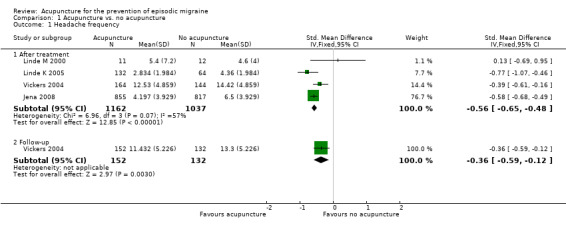
Comparison 1 Acupuncture vs. no acupuncture, Outcome 1 Headache frequency.
1.2. Analysis.
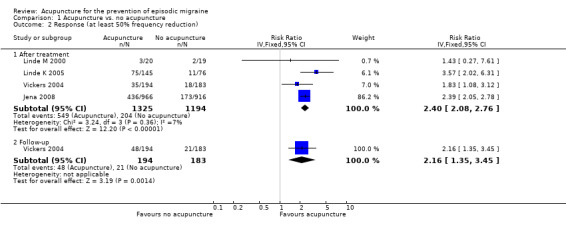
Comparison 1 Acupuncture vs. no acupuncture, Outcome 2 Response (at least 50% frequency reduction).
Comparison 2. Acupuncture vs. sham interventions.
| Outcome or subgroup title | No. of studies | No. of participants | Statistical method | Effect size |
|---|---|---|---|---|
| 1 Headache frequency | 12 | Std. Mean Difference (IV, Fixed, 95% CI) | Subtotals only | |
| 1.1 After treatment | 12 | 1646 | Std. Mean Difference (IV, Fixed, 95% CI) | ‐0.18 [‐0.28, ‐0.08] |
| 1.2 Follow‐up | 10 | 1534 | Std. Mean Difference (IV, Fixed, 95% CI) | ‐0.19 [‐0.30, ‐0.09] |
| 2 Response (at least 50% frequency reduction) | 14 | Risk Ratio (IV, Fixed, 95% CI) | Subtotals only | |
| 2.1 After treatment | 14 | 1825 | Risk Ratio (IV, Fixed, 95% CI) | 1.23 [1.11, 1.36] |
| 2.2 Follow‐up | 11 | 1683 | Risk Ratio (IV, Fixed, 95% CI) | 1.25 [1.13, 1.39] |
| 3 Headache frequency (various measures) | 12 | Std. Mean Difference (IV, Fixed, 95% CI) | Subtotals only | |
| 3.1 Up to 8 weeks/2 months after randomization | 9 | 1538 | Std. Mean Difference (IV, Fixed, 95% CI) | ‐0.16 [‐0.27, ‐0.06] |
| 3.2 3 to 4 months after randomization | 9 | 1486 | Std. Mean Difference (IV, Fixed, 95% CI) | ‐0.20 [‐0.31, ‐0.10] |
| 3.3 5 to 6 months after randomization | 7 | 1031 | Std. Mean Difference (IV, Fixed, 95% CI) | ‐0.13 [‐0.25, ‐0.01] |
| 3.4 > 6 months after randomization | 5 | 200 | Std. Mean Difference (IV, Fixed, 95% CI) | ‐0.12 [‐0.40, 0.16] |
| 4 Response | 14 | Risk Ratio (M‐H, Fixed, 95% CI) | Subtotals only | |
| 4.1 Up to 8 weeks/2 months after randomization | 10 | 1682 | Risk Ratio (M‐H, Fixed, 95% CI) | 1.19 [1.08, 1.32] |
| 4.2 3 to 4 months after randomization | 9 | 1579 | Risk Ratio (M‐H, Fixed, 95% CI) | 1.25 [1.12, 1.39] |
| 4.3 5 to 6 months after randomization | 9 | 1170 | Risk Ratio (M‐H, Fixed, 95% CI) | 1.19 [1.05, 1.35] |
| 4.4 > 6 months after randomization | 5 | 213 | Risk Ratio (M‐H, Fixed, 95% CI) | 1.48 [0.94, 2.31] |
| 5 Migraine attacks | 7 | Mean Difference (IV, Fixed, 95% CI) | Subtotals only | |
| 5.1 Up to 8 weeks/2 months after randomization | 6 | 849 | Mean Difference (IV, Fixed, 95% CI) | ‐0.35 [‐0.57, ‐0.13] |
| 5.2 3 to 4 months after randomization | 6 | 802 | Mean Difference (IV, Fixed, 95% CI) | ‐0.32 [‐0.53, ‐0.10] |
| 5.3 5 to 6 months after randomization | 4 | 321 | Mean Difference (IV, Fixed, 95% CI) | 0.14 [‐0.16, 0.43] |
| 5.4 > 6 months after randomization | 4 | 150 | Mean Difference (IV, Fixed, 95% CI) | 0.30 [‐0.10, 0.71] |
| 5.5 New Subgroup | 0 | 0 | Mean Difference (IV, Fixed, 95% CI) | 0.0 [0.0, 0.0] |
| 6 Migraine days | 10 | Mean Difference (IV, Fixed, 95% CI) | Subtotals only | |
| 6.1 Up to 8 weeks/2 months after randomization | 8 | 1508 | Mean Difference (IV, Fixed, 95% CI) | ‐0.38 [‐0.65, ‐0.10] |
| 6.2 3 to 4 months after randomization | 7 | 1426 | Mean Difference (IV, Fixed, 95% CI) | ‐0.45 [‐0.74, ‐0.15] |
| 6.3 5 to 6 months after randomization | 7 | 1031 | Mean Difference (IV, Fixed, 95% CI) | ‐0.25 [‐0.62, 0.11] |
| 6.4 > 6 months after randomization | 5 | 190 | Mean Difference (IV, Fixed, 95% CI) | ‐0.42 [‐1.56, 0.73] |
| 7 Headache days | 2 | Mean Difference (IV, Fixed, 95% CI) | Subtotals only | |
| 7.1 Up to 8 weeks/2 months after randomization | 2 | 240 | Mean Difference (IV, Fixed, 95% CI) | ‐0.11 [‐1.05, 0.83] |
| 7.2 3 to 4 months after randomization | 2 | 238 | Mean Difference (IV, Fixed, 95% CI) | 0.02 [‐0.89, 0.92] |
| 7.3 5 to 6 months after randomization | 2 | 233 | Mean Difference (IV, Fixed, 95% CI) | 0.21 [‐0.65, 1.08] |
| 7.4 > 6 months after randomization | 0 | 0 | Mean Difference (IV, Fixed, 95% CI) | 0.0 [0.0, 0.0] |
| 8 Headache intensity | 6 | Std. Mean Difference (IV, Fixed, 95% CI) | Subtotals only | |
| 8.1 Up to 8 weeks/2 months after randomization | 2 | 521 | Std. Mean Difference (IV, Fixed, 95% CI) | ‐0.24 [‐0.44, ‐0.05] |
| 8.2 3 to 4 months after randomization | 4 | 1285 | Std. Mean Difference (IV, Fixed, 95% CI) | ‐0.06 [‐0.17, 0.06] |
| 8.3 5 to 6 months after randomization | 4 | 886 | Std. Mean Difference (IV, Fixed, 95% CI) | ‐0.12 [‐0.26, 0.01] |
| 8.4 > 6 months after randomization | 2 | 78 | Std. Mean Difference (IV, Fixed, 95% CI) | ‐0.51 [‐0.96, ‐0.05] |
| 9 Analgesic use | 7 | Std. Mean Difference (IV, Fixed, 95% CI) | Subtotals only | |
| 9.1 Up to 8 weeks/2 months after randomization | 5 | 368 | Std. Mean Difference (IV, Fixed, 95% CI) | ‐0.08 [‐0.29, 0.14] |
| 9.2 3 to 4 months after randomization | 7 | 455 | Std. Mean Difference (IV, Fixed, 95% CI) | ‐0.23 [‐0.42, ‐0.03] |
| 9.3 5 to 6 months after randomization | 6 | 409 | Std. Mean Difference (IV, Fixed, 95% CI) | ‐0.20 [‐0.42, 0.02] |
| 9.4 > 6 months after randomization | 5 | 171 | Std. Mean Difference (IV, Fixed, 95% CI) | 0.02 [‐0.30, 0.35] |
| 10 Headache scores | 2 | Std. Mean Difference (IV, Fixed, 95% CI) | Subtotals only | |
| 10.1 Up to 8 weeks/2 months after randomization | 2 | 240 | Std. Mean Difference (IV, Fixed, 95% CI) | 0.06 [‐0.22, 0.34] |
| 10.2 3 to 4 months after randomization | 2 | 238 | Std. Mean Difference (IV, Fixed, 95% CI) | 0.05 [‐0.24, 0.33] |
| 10.3 5 to 6 months after randomization | 2 | 228 | Std. Mean Difference (IV, Fixed, 95% CI) | 0.18 [‐0.10, 0.47] |
| 10.4 > 6 months after randomization | 1 | 26 | Std. Mean Difference (IV, Fixed, 95% CI) | 0.0 [0.0, 0.0] |
| 11 Frequency after treatment ‐ subgroup analysis 1: Adequacy of concealment | 12 | 1646 | Std. Mean Difference (IV, Fixed, 95% CI) | ‐0.18 [‐0.28, ‐0.08] |
| 11.1 Unclear adequacy | 9 | 371 | Std. Mean Difference (IV, Fixed, 95% CI) | ‐0.37 [‐0.57, ‐0.16] |
| 11.2 Unambigously adequate concealment | 3 | 1275 | Std. Mean Difference (IV, Fixed, 95% CI) | ‐0.12 [‐0.24, ‐0.01] |
| 12 Frequency follow‐up ‐ subgroup analysis 1: Adequacy of concealment | 10 | 1534 | Std. Mean Difference (IV, Fixed, 95% CI) | ‐0.19 [‐0.30, ‐0.09] |
| 12.1 Unclear adequacy | 7 | 259 | Std. Mean Difference (IV, Fixed, 95% CI) | ‐0.20 [‐0.45, 0.05] |
| 12.2 Unambigously adequate concealment | 3 | 1275 | Std. Mean Difference (IV, Fixed, 95% CI) | ‐0.19 [‐0.31, ‐0.08] |
| 13 Response after treatment ‐ subgroup analysis 1: Adequacy of concealment | 14 | Risk Ratio (IV, Fixed, 95% CI) | Subtotals only | |
| 13.1 Unclear adequacy | 11 | 471 | Risk Ratio (IV, Fixed, 95% CI) | 1.54 [1.23, 1.92] |
| 13.2 Unambigously adequate concealment | 3 | 1354 | Risk Ratio (IV, Fixed, 95% CI) | 1.16 [1.03, 1.30] |
| 14 Response at follow‐up ‐ subgroup analysis 1: Adequacy of concealment | 11 | Risk Ratio (IV, Fixed, 95% CI) | Subtotals only | |
| 14.1 Unclear adequacy | 8 | 329 | Risk Ratio (IV, Fixed, 95% CI) | 1.67 [1.22, 2.28] |
| 14.2 Unambigously adequate concealment | 3 | 1354 | Risk Ratio (IV, Fixed, 95% CI) | 1.21 [1.08, 1.35] |
| 15 Frequency after treatment ‐ subgroup analysis 2: Sample size | 12 | 1646 | Std. Mean Difference (IV, Fixed, 95% CI) | ‐0.18 [‐0.28, ‐0.08] |
| 15.1 Up to median | 6 | 177 | Std. Mean Difference (IV, Fixed, 95% CI) | ‐0.28 [‐0.59, 0.02] |
| 15.2 Above median | 6 | 1469 | Std. Mean Difference (IV, Fixed, 95% CI) | ‐0.17 [‐0.28, ‐0.06] |
| 16 Frequency follow‐up ‐ subgroup analysis 2: Sample size | 10 | 1534 | Std. Mean Difference (IV, Fixed, 95% CI) | ‐0.19 [‐0.30, ‐0.09] |
| 16.1 Up to median | 5 | 145 | Std. Mean Difference (IV, Fixed, 95% CI) | 0.05 [‐0.28, 0.38] |
| 16.2 Above median | 5 | 1389 | Std. Mean Difference (IV, Fixed, 95% CI) | ‐0.22 [‐0.33, ‐0.11] |
| 17 Response after treatment ‐ subgroup analysis 2: Sample size | 14 | Risk Ratio (IV, Fixed, 95% CI) | Subtotals only | |
| 17.1 Up to median | 8 | 277 | Risk Ratio (IV, Fixed, 95% CI) | 1.95 [1.29, 2.96] |
| 17.2 Above median | 7 | 1589 | Risk Ratio (IV, Fixed, 95% CI) | 1.20 [1.08, 1.33] |
| 18 Response at follow‐up ‐ subgroup analysis 3: Number of treatment sessions | 11 | Risk Ratio (IV, Fixed, 95% CI) | Subtotals only | |
| 18.1 Up to 12 | 6 | 1025 | Risk Ratio (IV, Fixed, 95% CI) | 1.16 [1.02, 1.32] |
| 18.2 16 and more | 5 | 658 | Risk Ratio (IV, Fixed, 95% CI) | 1.48 [1.23, 1.80] |
| 19 Frequency after treatment ‐ subgroup analysis 3: Number of treatment sessions | 12 | 1646 | Std. Mean Difference (IV, Fixed, 95% CI) | ‐0.18 [‐0.28, ‐0.08] |
| 19.1 Up to 12 | 6 | 948 | Std. Mean Difference (IV, Fixed, 95% CI) | ‐0.11 [‐0.24, 0.02] |
| 19.2 16 and more | 6 | 698 | Std. Mean Difference (IV, Fixed, 95% CI) | ‐0.30 [‐0.46, ‐0.14] |
| 20 Frequency follow‐up ‐ subgroup analysis 3: Number of treatment sessions | 10 | 1534 | Std. Mean Difference (IV, Fixed, 95% CI) | ‐0.19 [‐0.30, ‐0.09] |
| 20.1 Up to 12 | 5 | 921 | Std. Mean Difference (IV, Fixed, 95% CI) | ‐0.11 [‐0.24, 0.02] |
| 20.2 16 and more | 5 | 613 | Std. Mean Difference (IV, Fixed, 95% CI) | ‐0.35 [‐0.53, ‐0.18] |
| 21 Response after treatment ‐ subgroup analysis 3: Number of treatment setssions | 14 | Risk Ratio (IV, Fixed, 95% CI) | Subtotals only | |
| 21.1 Up to 12 | 8 | 1087 | Risk Ratio (IV, Fixed, 95% CI) | 1.15 [1.01, 1.30] |
| 21.2 16 and more | 6 | 738 | Risk Ratio (IV, Fixed, 95% CI) | 1.38 [1.17, 1.64] |
| 22 Response at follow‐up ‐ subgroup analysis 2: Sample size | 11 | Risk Ratio (IV, Fixed, 95% CI) | Subtotals only | |
| 22.1 Up to median | 6 | 215 | Risk Ratio (IV, Fixed, 95% CI) | 1.48 [1.02, 2.15] |
| 22.2 Above median | 5 | 1468 | Risk Ratio (IV, Fixed, 95% CI) | 1.23 [1.11, 1.38] |
| 23 Frequency after treatment ‐ subgroup analysis 4: Type of sham | 12 | 1646 | Std. Mean Difference (IV, Fixed, 95% CI) | ‐0.18 [‐0.28, ‐0.08] |
| 23.1 Penetrating | 9 | 1538 | Std. Mean Difference (IV, Fixed, 95% CI) | ‐0.16 [‐0.26, ‐0.06] |
| 23.2 (At least partly) non‐penetrating | 3 | 108 | Std. Mean Difference (IV, Fixed, 95% CI) | ‐0.50 [‐0.89, ‐0.10] |
| 24 Frequency follow‐up ‐ subgroup analysis 4: Type of sham | 10 | 1534 | Std. Mean Difference (IV, Fixed, 95% CI) | ‐0.19 [‐0.30, ‐0.09] |
| 24.1 Penetrating | 8 | 1456 | Std. Mean Difference (IV, Fixed, 95% CI) | ‐0.18 [‐0.29, ‐0.07] |
| 24.2 (At least partly) non‐penetrating | 2 | 78 | Std. Mean Difference (IV, Fixed, 95% CI) | ‐0.48 [‐0.94, ‐0.02] |
| 25 Response after treatment ‐ subgroup analysis 4: Type of sham | 14 | Risk Ratio (IV, Fixed, 95% CI) | Subtotals only | |
| 25.1 Penetrating | 12 | 1744 | Risk Ratio (IV, Fixed, 95% CI) | 1.21 [1.09, 1.34] |
| 25.2 (At least partly) non‐penetrating | 2 | 81 | Risk Ratio (IV, Fixed, 95% CI) | 2.02 [1.09, 3.75] |
| 26 Response at follow‐up ‐ subgroup analysis 4: Type of sham | 11 | Risk Ratio (IV, Fixed, 95% CI) | Subtotals only | |
| 26.1 Penetrating | 9 | 1602 | Risk Ratio (IV, Fixed, 95% CI) | 1.23 [1.11, 1.37] |
| 26.2 (At least partly) non‐penetrating | 2 | 81 | Risk Ratio (IV, Fixed, 95% CI) | 3.16 [1.46, 6.82] |
| 27 Safety/acceptability | 13 | Odds Ratio (IV, Fixed, 95% CI) | Subtotals only | |
| 27.1 Number of participants dropping out due to adverse effects | 7 | 931 | Odds Ratio (IV, Fixed, 95% CI) | 2.84 [0.43, 18.71] |
| 27.2 Number of participants reporting adverse effects | 4 | 1414 | Odds Ratio (IV, Fixed, 95% CI) | 1.15 [0.85, 1.56] |
| 27.3 Number of participants not reaching primary endpoint | 11 | 1770 | Odds Ratio (IV, Fixed, 95% CI) | 1.14 [0.78, 1.67] |
| 27.4 Number of participants with serious adverse events | 6 | 1071 | Odds Ratio (IV, Fixed, 95% CI) | 1.29 [0.43, 3.83] |
2.1. Analysis.
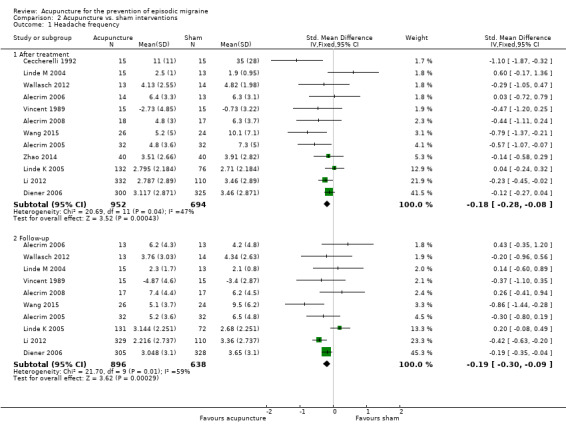
Comparison 2 Acupuncture vs. sham interventions, Outcome 1 Headache frequency.
2.2. Analysis.
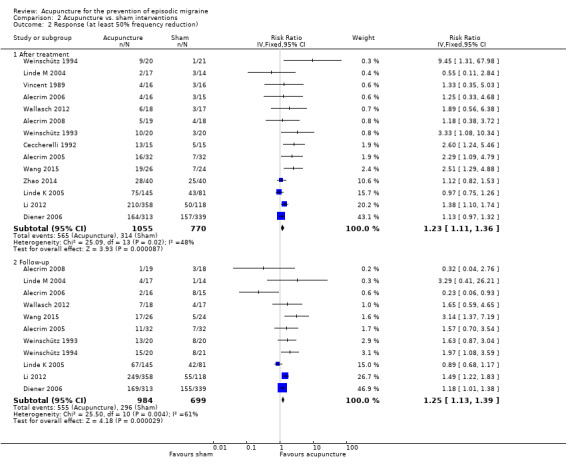
Comparison 2 Acupuncture vs. sham interventions, Outcome 2 Response (at least 50% frequency reduction).
Comparison 3. Acupuncture vs. prophylactic drug treatment.
| Outcome or subgroup title | No. of studies | No. of participants | Statistical method | Effect size |
|---|---|---|---|---|
| 1 Headache frequency | 3 | Std. Mean Difference (IV, Fixed, 95% CI) | Subtotals only | |
| 1.1 After treatment | 3 | 739 | Std. Mean Difference (IV, Fixed, 95% CI) | ‐0.25 [‐0.39, ‐0.10] |
| 1.2 Follow‐up | 3 | 744 | Std. Mean Difference (IV, Fixed, 95% CI) | ‐0.13 [‐0.28, 0.01] |
| 2 Response (at least 50% frequency reduction) | 3 | Risk Ratio (IV, Fixed, 95% CI) | Subtotals only | |
| 2.1 After treatment | 3 | 743 | Risk Ratio (IV, Fixed, 95% CI) | 1.24 [1.08, 1.44] |
| 2.2 Follow‐up | 3 | 744 | Risk Ratio (IV, Fixed, 95% CI) | 1.11 [0.97, 1.26] |
| 3 Headache frequency (various measures) | 3 | Std. Mean Difference (IV, Fixed, 95% CI) | Subtotals only | |
| 3.1 Up to 8 weeks/2 months after randomization | 3 | 746 | Std. Mean Difference (IV, Fixed, 95% CI) | ‐0.18 [‐0.32, ‐0.03] |
| 3.2 3 to 4 months after randomization | 3 | 741 | Std. Mean Difference (IV, Fixed, 95% CI) | ‐0.23 [‐0.37, ‐0.08] |
| 3.3 5 to 6 months after randomization | 3 | 744 | Std. Mean Difference (IV, Fixed, 95% CI) | ‐0.13 [‐0.28, 0.01] |
| 3.4 > 6 months after randomization | 0 | 0 | Std. Mean Difference (IV, Fixed, 95% CI) | 0.0 [0.0, 0.0] |
| 4 Response | 3 | Risk Ratio (M‐H, Fixed, 95% CI) | Subtotals only | |
| 4.1 Up to 8 weeks/2 months after randomization | 3 | 746 | Risk Ratio (M‐H, Fixed, 95% CI) | 1.17 [1.01, 1.35] |
| 4.2 3 to 4 months after randomization | 3 | 741 | Risk Ratio (M‐H, Fixed, 95% CI) | 1.22 [1.06, 1.40] |
| 4.3 5 to 6 months after randomization | 3 | 744 | Risk Ratio (M‐H, Fixed, 95% CI) | 1.11 [0.97, 1.26] |
| 4.4 > 6 months after randomization | 0 | 0 | Risk Ratio (M‐H, Fixed, 95% CI) | 0.0 [0.0, 0.0] |
| 5 Migraine attacks | 3 | Mean Difference (IV, Fixed, 95% CI) | Subtotals only | |
| 5.1 Up to 8 weeks/2 months after randomization | 2 | 241 | Mean Difference (IV, Fixed, 95% CI) | ‐0.49 [‐0.91, ‐0.08] |
| 5.2 3 to 4 months after randomization | 3 | 316 | Mean Difference (IV, Fixed, 95% CI) | ‐0.32 [‐0.59, ‐0.04] |
| 5.3 5 to 6 months after randomization | 2 | 237 | Mean Difference (IV, Fixed, 95% CI) | ‐0.31 [‐0.61, ‐0.01] |
| 5.4 > 6 months after randomization | 0 | 0 | Mean Difference (IV, Fixed, 95% CI) | 0.0 [0.0, 0.0] |
| 6 Migraine days | 2 | Mean Difference (IV, Fixed, 95% CI) | Subtotals only | |
| 6.1 Up to 8 weeks/2 months after randomization | 2 | 596 | Mean Difference (IV, Fixed, 95% CI) | ‐0.38 [‐0.83, 0.06] |
| 6.2 3 to 4 months after randomization | 2 | 591 | Mean Difference (IV, Fixed, 95% CI) | ‐0.56 [‐1.03, ‐0.10] |
| 6.3 5 to 6 months after randomization | 2 | 594 | Mean Difference (IV, Fixed, 95% CI) | ‐0.41 [‐0.90, 0.08] |
| 6.4 > 6 months after randomization | 0 | 0 | Mean Difference (IV, Fixed, 95% CI) | 0.0 [0.0, 0.0] |
| 7 Headache days | 1 | Mean Difference (IV, Fixed, 95% CI) | Subtotals only | |
| 7.1 Up to 8 weeks/2 months after randomization | 1 | 91 | Mean Difference (IV, Fixed, 95% CI) | 0.10 [‐1.26, 1.46] |
| 7.2 3 to 4 months after randomization | 1 | 89 | Mean Difference (IV, Fixed, 95% CI) | ‐0.10 [‐1.52, 1.32] |
| 7.3 5 to 6 months after randomization | 1 | 87 | Mean Difference (IV, Fixed, 95% CI) | ‐0.60 [‐1.99, 0.79] |
| 7.4 > 6 months after randomization | 0 | 0 | Mean Difference (IV, Fixed, 95% CI) | 0.0 [0.0, 0.0] |
| 8 Headache intensity | 3 | Std. Mean Difference (IV, Fixed, 95% CI) | Subtotals only | |
| 8.1 Up to 8 weeks/2 months after randomization | 0 | 0 | Std. Mean Difference (IV, Fixed, 95% CI) | 0.0 [0.0, 0.0] |
| 8.2 3 to 4 months after randomization | 3 | 639 | Std. Mean Difference (IV, Fixed, 95% CI) | ‐0.27 [‐0.44, ‐0.10] |
| 8.3 5 to 6 months after randomization | 2 | 565 | Std. Mean Difference (IV, Fixed, 95% CI) | ‐0.31 [‐0.49, ‐0.14] |
| 8.4 > 6 months after randomization | 0 | 0 | Std. Mean Difference (IV, Fixed, 95% CI) | 0.0 [0.0, 0.0] |
| 9 Analgesic use | 2 | Std. Mean Difference (IV, Fixed, 95% CI) | Subtotals only | |
| 9.1 Up to 8 weeks/2 months after randomization | 2 | 241 | Std. Mean Difference (IV, Fixed, 95% CI) | ‐0.24 [‐0.49, 0.02] |
| 9.2 3 to 4 months after randomization | 2 | 239 | Std. Mean Difference (IV, Fixed, 95% CI) | ‐0.08 [‐0.33, 0.18] |
| 9.3 5 to 6 months after randomization | 2 | 237 | Std. Mean Difference (IV, Fixed, 95% CI) | ‐0.09 [‐0.35, 0.17] |
| 9.4 > 6 months after randomization | 0 | 0 | Std. Mean Difference (IV, Fixed, 95% CI) | 0.0 [0.0, 0.0] |
| 10 Headache scores | 1 | Std. Mean Difference (IV, Fixed, 95% CI) | Subtotals only | |
| 10.1 Up to 8 weeks/2 months after randomization | 1 | 91 | Std. Mean Difference (IV, Fixed, 95% CI) | ‐0.08 [‐0.50, 0.34] |
| 10.2 3 to 4 months after randomization | 1 | 89 | Std. Mean Difference (IV, Fixed, 95% CI) | ‐0.16 [‐0.59, 0.27] |
| 10.3 5 to 6 months after randomization | 1 | 87 | Std. Mean Difference (IV, Fixed, 95% CI) | ‐0.23 [‐0.67, 0.20] |
| 10.4 > 6 months after randomization | 0 | 0 | Std. Mean Difference (IV, Fixed, 95% CI) | 0.0 [0.0, 0.0] |
| 11 Safety/acceptability | 5 | Odds Ratio (M‐H, Random, 95% CI) | Subtotals only | |
| 11.1 Number of participants dropping out due to adverse effects | 4 | 451 | Odds Ratio (M‐H, Random, 95% CI) | 0.27 [0.08, 0.86] |
| 11.2 Number of participants reporting adverse effects | 5 | 931 | Odds Ratio (M‐H, Random, 95% CI) | 0.25 [0.10, 0.62] |
| 11.3 Number of participants not reaching primary endpoint | 4 | 995 | Odds Ratio (M‐H, Random, 95% CI) | 0.28 [0.10, 0.78] |
| 11.4 Number of participants with serious adverse events | 3 | 721 | Odds Ratio (M‐H, Random, 95% CI) | 1.33 [0.38, 4.73] |
3.1. Analysis.
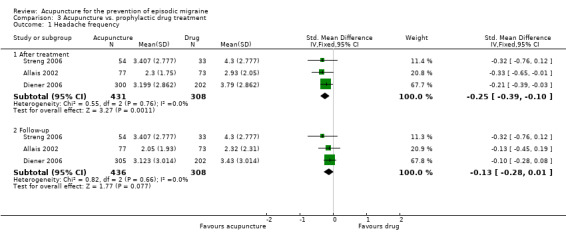
Comparison 3 Acupuncture vs. prophylactic drug treatment, Outcome 1 Headache frequency.
3.2. Analysis.
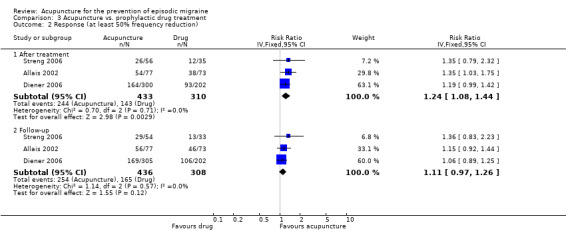
Comparison 3 Acupuncture vs. prophylactic drug treatment, Outcome 2 Response (at least 50% frequency reduction).
3.3. Analysis.
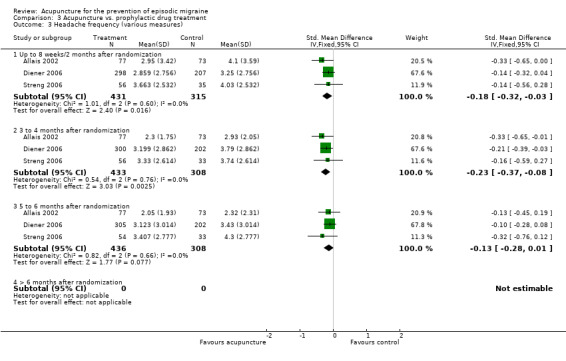
Comparison 3 Acupuncture vs. prophylactic drug treatment, Outcome 3 Headache frequency (various measures).
3.4. Analysis.
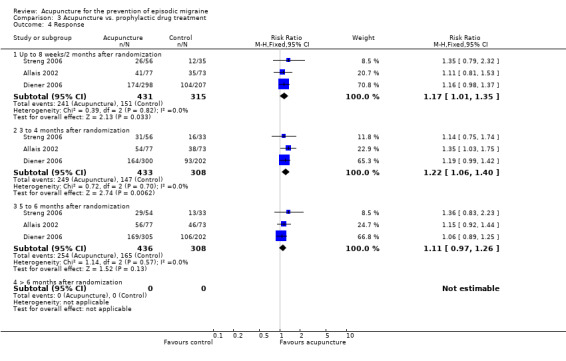
Comparison 3 Acupuncture vs. prophylactic drug treatment, Outcome 4 Response.
Characteristics of studies
Characteristics of included studies [ordered by study ID]
Alecrim 2005.
| Methods | This trial is only available as an abstract publication. On request the first author informed us that sequence generation, allocation concealment and blinding were performed as in Alecrim 2008. Triallists performed both intention‐to‐treat analyses and analyses based on available data. | |
| Participants | Number of participants included/analysed: 64/64 (in intention‐to‐treat analysis; information from author) Condition: migraine with or without aura Demographics: not reported Setting: outpatient headache clinic of a neurology department of State University of Campinas, Brazil Time since onset of headaches: not reported | |
| Interventions | Acupuncture points: individualized selection according to traditional Chinese medicine DeChi achieved?: yes (information from author) Number of treatment sessions: 16 Frequency of sessions: 2/week for first 4 weeks, then 1/week for 8 weeks (information from author) Information on acupuncturists: 1 acupuncturist trained in Spain and 12 years of practical experience (information from author) Control intervention: sham acupuncture (superficial needling without manipulation at non‐indicated points) | |
| Outcomes | Method for outcome measurement: diary | |
| Notes | This trial is the third in a series performed by the study authors. The trials Alecrim 2006and Alecrim 2008 were performed before this study. The authors provided data for effect size calculations (50% response rates, migraine days, attacks, rescue medication use). | |
| Risk of bias | ||
| Bias | Authors' judgement | Support for judgement |
| Random sequence generation (selection bias) | Unclear risk | Only published abstract available, therefore the study was not assessed formally. According to study authors, methods are the same as in Alecrim 2006 and Alecrim 2008. |
| Allocation concealment (selection bias) | Unclear risk | Only published abstract available, therefore the study was not assessed formally. According to study authors, methods are the same as in Alecrim 2006 and Alecrim 2008. |
| Blinding (performance bias and detection bias) All outcomes | Unclear risk | Only published abstract available, therefore the study was not assessed formally. According to study authors, methods are the same as in Alecrim 2006 and Alecrim 2008. |
| Incomplete outcome data (attrition bias) All outcomes up to 3 month after randomisation | Unclear risk | Only published abstract available, therefore the study was not assessed formally. According to study authors, methods are the same as in Alecrim 2006 and Alecrim 2008. |
| Incomplete follow‐up outcome data (attrition bias) All outcomes later than 3 months after randomisation | Unclear risk | Only published abstract available, therefore the study was not assessed formally. According to study authors, methods are the same as in Alecrim 2006 and Alecrim 2008. |
| Selective reporting (reporting bias) | Unclear risk | Only published abstract available, therefore the study was not assessed formally. According to study authors, methods are the same as in Alecrim 2006 and Alecrim 2008. |
Alecrim 2006.
| Methods | Blinding: participants, research assistants, neurologist; blinding tested and successful Dropout/withdrawals: substantial bias is unlikely in the first 3 months, but it cannot be ruled out for late follow‐up (< 10% attrition (3/31) in the first 3 months, 5/31 until end of month 5, 7 /31 until end of month 9; similar rates in both groups; no intention‐to‐treat analysis) Observation period: 4 weeks baseline, 12 weeks treatment, 24 weeks follow‐up Acupuncturists' assessments: GA similarly/70% ‐ BB differently/60% | |
| Participants | Number of participants included/analysed: 31/28 Condition: migraine with or without aura (IHS 1988) Demographics: mean age 32.5 (acupuncture) and 39.1 (sham) years, 79% female Setting: outpatient headache clinic of a neurology department of State University of Campinas, Brazil Time since onset of headaches: mean 16.9 (acupuncture) and 20.0 (sham) years | |
| Interventions | Acupuncture points: semi‐standardized point selection (GB12/20/21 and BL10 in all participants + individualized additional points from a selection); point selection for a participant was not changed over treatment sessions Information on acupuncturists: 1 acupuncturist trained in Spain and 12 years of practical experience (information from author) De‐Chi achieved?: yes Number of sessions: 16 (30 min each) Frequency of treatment sessions: 2/week for first 4 weeks, then 1/week for 8 weeks Control intervention: sham (superficial needling without manipulation at non‐indicated points Ex‐B1, SJ17/20, Sp7, St37, Lu5) | |
| Outcomes | Method for outcome measurement: diary Primary outcomes: at least 40% reduction in attack frequency, at least 50% attack reduction and total migraine days during treatment period Other outcomes: frequency of migraine attacks, duration of attacks, severity, migraine hours, rescue medication, nausea and vomiting frequency | |
| Notes | Rigorous but small trial; selection of existing acupuncture points in the sham group problematic Authors provided additional information on methods and data for effect size calculations (50% response rates, migraine days, attacks, rescue medication use) | |
| Risk of bias | ||
| Bias | Authors' judgement | Support for judgement |
| Random sequence generation (selection bias) | Low risk | "Random digits (reference 14) were used to define the sequence" |
| Allocation concealment (selection bias) | Low risk | Opaque, numbered and sealed envelopes |
| Blinding (performance bias and detection bias) All outcomes | Low risk | Participants blinded; test of blinding suggests successful blinding |
| Incomplete outcome data (attrition bias) All outcomes up to 3 month after randomisation | Low risk | Low attrition unlikely to cause major bias: 3 of 31 participants (2 of 16 acupuncture, 1 of 15 sham) did not complete the 12‐week treatment phase |
| Incomplete follow‐up outcome data (attrition bias) All outcomes later than 3 months after randomisation | Unclear risk | 13 participants in both groups at 2 month follow‐up after treatment (5 months after randomisation) and 12 in both groups at 6 months after treatment (9 months after randomisation); no intention‐to‐treat analysis |
| Selective reporting (reporting bias) | Low risk | Relevant outcomes described in publication and additional data provided on request |
Alecrim 2008.
| Methods | Blinding: participants, research assistants, neurologist; blinding tested and successful Dropouts/withdrawals: bias unlikely ‐ during the first 3 months only 1 patient in sham group without diary data, at late follow‐up 1 exclusion and 1 lacking diary in the acupuncture group Observation period: 4 weeks baseline, 12 weeks treatment, 24 weeks follow‐up Acupuncturists' assessments: GA can't tell ‐ BB can't tell | |
| Participants | Number of participants included/analysed: 37/36 Condition: migraine with or without aura (IHS 1988) Demographics: mean age 35 years, 89% female Setting: outpatient headache clinic of a neurology department of State University of Campinas, Brazil Time since onset of headaches: mean 20.6 (acupuncture) and 14.5 (sham) years | |
| Interventions | Acupuncture points: individualized selection based on principles of traditional Chinese medicine DeChi achieved?: yes Number of treatment sessions: 16 (30 minutes each) Frequency of sessions: 2/week for first 4 weeks, then 1/week for 8 weeks (not reported in paper) Information on acupuncturists: 1 acupuncturist trained in Spain and 12 years of practical experience (information from author) Control intervention: very superficial insertion of 10‐15 needles at acupuncture points considered irrelevant for headache (some on the head) | |
| Outcomes | Method for outcome measurement: diary Primary outcome: at least 50% attack reduction (each month) Other outcomes: at least 40% attack reduction, attack frequency, number of migraine days, migraine hours, duration per attack, severity, amount and type of rescue medication, nausea and vomiting frequency | |
| Notes | Rigorous but small trial; selection of existing acupuncture points in the sham group problematic First author provided additional information on methods and data for effect size calculations (50% response rates, migraine days, attacks, rescue medication use) | |
| Risk of bias | ||
| Bias | Authors' judgement | Support for judgement |
| Random sequence generation (selection bias) | Low risk | Use of random digits as in Alecrim 2006 |
| Allocation concealment (selection bias) | Low risk | Opaque and sealed envelopes; inclusion by independent neurologist |
| Blinding (performance bias and detection bias) All outcomes | Low risk | participants blinded; test of blinding suggests successful blinding |
| Incomplete outcome data (attrition bias) All outcomes up to 3 month after randomisation | Low risk | 36 of 37 randomized participants (1 dropout sham group) included in analysis |
| Incomplete follow‐up outcome data (attrition bias) All outcomes later than 3 months after randomisation | Low risk | 34 of 37 participants with data at long‐term follow‐up (2 vs. 1 dropouts/withdrawals) |
| Selective reporting (reporting bias) | Low risk | Relevant outcomes described in publication and additional data provided on request |
Allais 2002.
| Methods | Blinding: diary evaluator Dropouts/withdrawals: substantial bias unlikely (attrition only 10 of 160 participants in 6 months) Observation period: baseline 2 months; treatment 6 months, no follow‐up Acupuncturists' assessments: BB different/65% ‐ AW different/55% | |
| Participants | Number of participants included/analysed: 160/150 Condition: migraine without aura (IHS) Demographics: mean age 38 years; all female Setting: Women's Headache Center, University of Turin, Italy Age at onset of headaches: mean 18 years | |
| Interventions | Acupuncture points: LR3, SP6, ST36, CV12, LI4, PC6, GB20, GB14, Taiyang, GV20 Information on acupuncturists; n = 3, "experienced and qualified" DeChi achieved?: yes Number of treatment sessions: 12 Frequency of treatment sessions: 1/week for 2 months, then 1/month for 4 months Control intervention: flunarizine 10 mg (2 months daily, then 20 days per month for 4 months) | |
| Outcomes | Method for outcome measurement: headache diary Primary outcome: attack frequency Other outcomes: intensity, use of rescue medication | |
| Notes | Unblinded, but otherwise rigorous trial; additional information provided from author The paper presents data on attack frequency and analgesics use for 2‐month intervals. For calculating mean differences in this review the means for attack frequency presented in the publication were divided by 2, as all other trials refer to 4‐week periods. The same was done with the standard deviations provided by the study author. For calculation of standardized mean differences we used the 2‐month means presented in the publication. We imputed frequency of response from baseline means and post‐treatment (months 3‐4) and follow‐up (months 5‐6) means and standard deviations | |
| Risk of bias | ||
| Bias | Authors' judgement | Support for judgement |
| Random sequence generation (selection bias) | Low risk | Computer program |
| Allocation concealment (selection bias) | Low risk | Central telephone procedure (information from author) |
| Blinding (performance bias and detection bias) All outcomes | High risk | Participants not blinded; diary evaluation blinded |
| Incomplete outcome data (attrition bias) All outcomes up to 3 month after randomisation | Low risk | Only 10 (3 acupuncture, 7 flunarizine) of 160 participants did not complete the study |
| Incomplete follow‐up outcome data (attrition bias) All outcomes later than 3 months after randomisation | Low risk | Only 10 (3 acupuncture, 7 flunarizine) of 160 participants did not complete the study |
| Selective reporting (reporting bias) | Low risk | Relevant outcomes presented |
Ceccherelli 1992.
| Methods | Blinding: participants, statistician (information from author) Dropout/withdrawals: no dropouts mentioned in the publication (first author remembers that there were a limited number of participants dropping out from the study, but he did not document the exact number) Observation period: baseline unclear; treatment 10 weeks; follow‐up only in participants with good response Acupuncturists' assessments: GA similarly/70% ‐ BB differently/45% | |
| Participants | Number of participants included/analysed: 30?/30 Condition: migraine without aura Demographics: mean age 40 years; 9 female, 6 male in acupuncture group; 15 female in sham group Setting: unclear, Italy Time since onset of headaches: 179 +/‐ 127 months (control group: 226 +/‐ 140) | |
| Interventions | Acupuncture points: BL 2, BL10, BL 60, GB 3, GB 20, GV 11, GV 20, LR 3, CV 13 Ex HN1, ST 8 (on non‐painful side) Information on acupuncturist: n = 1, trained 3 years DeChi achieved?: no information Number of treatment sessions: 10 Frequency of treatment sessions: 1/week Control intervention: placebo acupuncture (complex procedure without real needling suggesting superficial anaesthesia to the patient) | |
| Outcomes | Method for outcome measurement: headache diary Primary outcome: at least 50% score reduction Other outcomes: headache hours, intensity | |
| Notes | Participants were not informed that they might get a placebo; unusual sham technique; sex differences between groups; no interpretable follow‐up data (only follow‐up of responders) | |
| Risk of bias | ||
| Bias | Authors' judgement | Support for judgement |
| Random sequence generation (selection bias) | Low risk | Random number table (information from author) |
| Allocation concealment (selection bias) | Low risk | Numbered envelopes, inclusion and random allocation by different persons (information from author) |
| Blinding (performance bias and detection bias) All outcomes | Low risk | Participants were blinded. The sham procedures differed from true acupuncture but participants were not informed that they might get a placebo. |
| Incomplete outcome data (attrition bias) All outcomes up to 3 month after randomisation | Unclear risk | No dropouts mentioned. The author reports on request that there were a few participants who did not complete the study. |
| Incomplete follow‐up outcome data (attrition bias) All outcomes later than 3 months after randomisation | Unclear risk | Follow‐up only performed in treatment responders |
| Selective reporting (reporting bias) | Low risk | Relevant outcomes reported |
Diener 2006.
| Methods | Blinding: participants (comparison acupuncture vs. sham), telephone interviewers; blinding acupuncture vs. sham tested and successful Dropouts/withdrawals: no bias for comparison with sham acupuncture, major bias possible for comparison with medication (8 of 313 participants allocated to acupuncture withdrew consent before the first treatment, 11 of 339 allocated to sham acupuncture and 106 of 308 allocated to standard treatment; after start of treatment 15 of 305 in the acupuncture group did not reach the primary endpoint, 11 of 328 in the sham acupuncture group and 15 of 202 in the standard treatment group) Acupuncturists' assessment: GA similarly/85% ‐ BB similarly/70% | |
| Participants | Number of participants included/analysed: 960/794 Condition: migraine (IHS) Demographics: mean age 37 years, 83% female Observation period: 4 weeks baseline, 6 weeks treatment (+ optionally 2 further weeks), 20 weeks follow‐up Setting: 149 primary care physicians in Germany Time since onset of headaches: mean 16 years | |
| Interventions | Acupuncture points: semi‐standardized ‐ depending on Chinese syndrome diagnosis predefined collections of obligatory and flexible points Information on acupuncturists: 149 physicians with at least 140 hours' acupuncture training and 2 years' professional experience DeChi achieved?: yes Number of treatment sessions: 10 (if moderate response further 5 sessions possible) Frequency of treatment sessions: 2/week Control intervention 1: sham acupuncture (superificial needling at distant non‐acupuncture points) Control intervention 2: guideline‐based individualized standard treatment ‐ 1. preference beta‐blockers, 2. preference flunarizine, 3. preference valproic acid | |
| Outcomes | Method for outcome measurement: diary and interviews Primary outcome: difference in migraine days between baseline and weeks 23‐26 after randomisation Other outcomes: migraine days, medication use, response (defined as at least 50% reduction of migraine days), pain intensity, impairment, pain days, quality of life, global assessments | |
| Notes | Very large, rigorous multicenter trial. The interpretation of the comparison with standard treatment is compromised by the fact that more than a third of participants allocated to standard treatment withdrew consent. No information is given on dosage and compliance in the standard treatment group. Authors provided biometrical report Data for migraine days and response at 6, 13 and 26 used for meta‐analysis in this review were obtained from individual patient data re‐analysis within the Acupuncture Trialists' Collaboration (see section Data collection and analysis) |
|
| Risk of bias | ||
| Bias | Authors' judgement | Support for judgement |
| Random sequence generation (selection bias) | Low risk | Computer program |
| Allocation concealment (selection bias) | Low risk | Central fax procedure |
| Blinding (performance bias and detection bias) All outcomes | Low risk | Participants and telephone interviewers were blinded for the comparison with sham acupuncture. Test of blinding suggests successful blinding (low risk of bias). The comparison with drug treatment was not blinded (high risk of bias) |
| Incomplete outcome data (attrition bias) All outcomes up to 3 month after randomisation | Low risk | Very low attrition and intention‐to‐treat analysis for comparison with sham acupuncture (low risk of bias). For the comparison with drug treatment the risk of bias is high as a large proportion of participants allocated to drug treatment withdrew consent immediately after randomisation or discontinued treatment |
| Incomplete follow‐up outcome data (attrition bias) All outcomes later than 3 months after randomisation | Low risk | Very low attrition and intention‐to‐treat analysis for comparison with sham acupuncture (low risk of bias). For the comparison with drug treatment the risk of bias is high as a large proportion of participants allocated drug treatment withdrew consent immediately after randomisation or dropped out |
| Selective reporting (reporting bias) | Low risk | Relevant outcomes reported and additional data provided on request |
Facco 2008.
| Methods | Blinding: participants (no blinding for the comparison with rizatriptan only). Participants were informed that stronger (for true acupuncture group) and milder (for mock acupuncture control groups) acupuncture treatments would be applied (information from author) Dropouts/withdrawals: 17 of 160 in the first 3 months (5, 5, 5, and 2 in the 4 groups), further 16 in the following 3 months (3, 5, 4, 4); no intention‐to‐treat analysis ‐ bias cannot be ruled out with certainty but does not seem likely Observation period: no baseline period, treatment 11 weeks, follow‐up 3 months Quality scores: Acupuncturists' assessments: GA similarly/80% ‐ BB similarly/60% | |
| Participants | Number of participants included/analysed: 160/127 Condition: migraine without aura (IHS) Demographics: mean age 36 years 54% female Setting: unclear, Italy Time since onset of headaches: > 1 year inclusion criterion | |
| Interventions | All participants treated acute attacks with rizatriptan Acupuncture points: depending on the Chinese diagnosis (3 external and 4 internal syndromes) predefined point selection DeChi achieved?: yes Number of treatment sessions: 20 (2 courses of 10 sessions with 1 week rest between the courses) of 30 minutes each Frequency of sessions: 2/week Information on acupuncturists: n = 3, at least 560 hours training and 5 years clinical experience (information from authors) Control intervention 1: non‐penetrating sham (non‐penetrating needles with manipulation) at correct, individualized points with full process of Chinese diagnosis ("ritualised mock acupuncture") Control intervention 2: non‐penetrating sham (non‐penetrating needles with manipulation) at standardized points (ST8, GB5, GB20, GV14, LU7) without the process of Chinese diagnosis ("standard mock acupuncture") Control group 3: attack treatment with rizatriptan only | |
| Outcomes | Method for outcome measurement: Migraine Disability questionnaire (MIDAS) at baseline and after 3 and 6 months + number of rizatriptan wafers per 3‐month period | |
| Notes | Only MIDAS score and rizatriptan intake measured, poor description of the sample, surprisingly little variability in several post‐treatment and follow‐up measures | |
| Risk of bias | ||
| Bias | Authors' judgement | Support for judgement |
| Random sequence generation (selection bias) | Low risk | Computer program |
| Allocation concealment (selection bias) | Low risk | Sealed, opaque, consecutively numbered envelopes (information from author) |
| Blinding (performance bias and detection bias) All outcomes | Low risk | Participants were blinded for the comparison with the two sham groups (low risk of bias); no blinding for the comparison with Rizatriptan only (high risk of bias). Participants were informed that stronger and milder acupuncture treatments would be applied (information from author). |
| Incomplete outcome data (attrition bias) All outcomes up to 3 month after randomisation | High risk | 33 of 160 dropped out; reasons were not reported; no intention‐to‐treat analysis |
| Incomplete follow‐up outcome data (attrition bias) All outcomes later than 3 months after randomisation | High risk | 33 of 160 dropped out; reasons were not reported; no intention‐to‐treat analysis |
| Selective reporting (reporting bias) | Low risk | Very limited outcome measurement; outcomes measured were adequately reported |
Facco 2013.
| Methods | Blinding: no blinding Dropouts/withdrawals: 18 participants (9 both in acupuncture and medication group) dropped out (3 vs. 4 refusing allocated treatment; without reporting group: 9 problems with work or moving town, 1 severe traffic accident, 1 tumour) Observation period: no baseline period, about 3 months treatment, 3 months post‐treatment follow‐up Acupuncturists's assessment: GA similarly/85% ‐ BB differently/55% |
|
| Participants | Number of participants included/analysed: 100/82 Condition: migraine without aura (IHS) Demographics: median age 40 (acupuncture group) and 34 years (valproate group); 66% female Setting: Institute for Traditional Medicine in Rome, Italy Time since onset of headaches: median 4 years (inclusion criterion at least 1 year) |
|
| Interventions | Acupuncture points: following Chinese syndrome classification; for exogenous syndromes: GB20, ST8, EX‐HN5, plus GB8, BL12, BL60, in wind‐cold syndrome, or plus TE5 and GV14 in wind‐heat syndrome, or plus ST40, SP6 and CV12 in wind‐dampness syndrome. For endogenous syndromes: a) hyperactivity of liver yang acupoints GB8, GB20, GB38, ST8, LR3,4, EX‐HN5; b) obstruction of middle jiao due to damp‐phlegm acupoints ST8, ST40, SP9,GV23, CV12, EX‐HN5; c) deficiency of kidney essence acupoints GB12, GB20, BL10, BL12, BL23, KI3; stagnation of qi and blood acupoints GB8, GB20, SP6, SP10, LR3, EX‐HN5, plus ashi (trigger) points on GB channel Information on acupuncturists: Licence certificated, number unclear Number of sessions: 2 courses of 10 sessions, with 1 week rest between the 2 sessions Frequency of sessions: 2/week Control intervention: valproic acid 600 mg/day for 3 months All participants used 10 mg rizatriptan (wafer) for attack treatment (second dose allowed if attack persist) |
|
| Outcomes | Migraine Disability (MIDAS) Questionnaire, pain intensity, Pain relief Score (PRF), rizatriptan intake | |
| Notes | Publication reports medians and interquartile ranges; author provided means and variability data for MIDAS data. However, we decided to not include the data on efficacy into meta‐analyses because standard deviation seemed clinically implausibly small, not consistent with P values from regression analyses, and the first author could not clarify the problem | |
| Risk of bias | ||
| Bias | Authors' judgement | Support for judgement |
| Random sequence generation (selection bias) | Low risk | Random number generator in MS Excel; stratified for sex |
| Allocation concealment (selection bias) | Unclear risk | Centrally stored, numbered sealed envelopes, but no further details |
| Blinding (performance bias and detection bias) All outcomes | High risk | No blinding |
| Incomplete outcome data (attrition bias) All outcomes up to 3 month after randomisation | Unclear risk | 18 of 100 participants (9 both in acupuncture and medication group) dropped out (3 vs. 4 refusing allocated treatment; without reporting group: 9 problems with work or moving town, 1 severe traffic accident, 1 tumour) |
| Incomplete follow‐up outcome data (attrition bias) All outcomes later than 3 months after randomisation | Unclear risk | As above |
| Selective reporting (reporting bias) | Low risk | MIDAS data presented in detail; details of diary data not presented, but this was only secondary |
Hesse 1994.
| Methods | Blinding: participants and evaluators Dropouts/withdrawals: bias unlikely (8 of 85 participants dropped out) Observation period: baseline 4 weeks; treatment 17 weeks; no follow‐up Acupuncturists' assessments: GA completely differently/50% ‐ BB different /30% | |
| Participants | Number of participants included/analysed: 85/77 Condition: migraine with or without aura (IHS) Demographics: mean age 45 years; 84% female Setting: outpatient pain clinic in Denmark Time since onset of headaches: mean 23 years | |
| Interventions | Acupuncture points: needling individual trigger points together with placebo tablets Information on acupuncturist: n = 1, no further information DeChi achieved?: no information Number of treatment sessions: individualized Duration of treatment sessions: needling for a few seconds only Control intervention: beta blocker metoprolol 100 mg and placebo stimulation (superficial touch with blunt end of the needle) | |
| Outcomes | Method for outcome measurement: diary Primary outcome: probably attack frequency Other outcomes: severity, duration, global rating, consumption of analgesics | |
| Notes | Rigorous trial; sham acupuncture procedure possibly distinguishable; non‐traditional acupuncture technique (brief needling at trigger points); mean frequency and mean severity of attacks in the last 4 weeks were recalculated from raw data in Figure 1 | |
| Risk of bias | ||
| Bias | Authors' judgement | Support for judgement |
| Random sequence generation (selection bias) | Unclear risk | No description |
| Allocation concealment (selection bias) | Unclear risk | No description |
| Blinding (performance bias and detection bias) All outcomes | Unclear risk | "Blinding was obtained through a double‐dummy technique and by keeping the therapist blinded to the results, whilst both investigator and statistician were blinded to the treatment". Dry needling of individual trigger point was used in the acupuncture group compared to a superficial touch with the blunt end of the needle in the medication/sham acupuncture group at a random selection of points. The success of blinding is not discussed. The way of informing participants about interventions is not reported. No details on the drug placebo reported |
| Incomplete outcome data (attrition bias) All outcomes up to 3 month after randomisation | Low risk | 8 of 85 participants dropped out. Analysis according to intention‐to‐treat principle. |
| Incomplete follow‐up outcome data (attrition bias) All outcomes later than 3 months after randomisation | Unclear risk | Probably rigorous trial with data presented in a manner not feasible for effect size calculation. Authors could not be contacted. Trial ended 17 weeks after randomisation. |
| Selective reporting (reporting bias) | Low risk | Relevant outcomes reported |
Jena 2008.
| Methods | Blinding: none Dropouts/withdrawals: 1479 of 1613 included in the acupuncture group with 3 month data vs. 1456 of 1569 in the control group; sensitivity analyses with missing values replaced confirm main analysis based on available data; in addition the trial observed 11,874 non‐randomized participants receiving acupuncture Observation period: no baseline period; treatment 3 months; no follow‐up (for randomized comparison) Acupuncturists' assessments: GA can't tell ‐ AW can't tell | |
| Participants | Number of participants included/analysed: 3182/2935 with migraine or tension‐type headache (TTH) (of those included 1715 with migraine, 167 with migraine and TTH, no information on numbers of migraine participants analysed) Condition: migraine and/or TTH (IHS) Demographics: mean age 44 years, 77% female (for total group) Setting: 4686 practices in Germany Time since onset of headaches: 10.8 years (for total group) | |
| Interventions | Acupuncture points: not documented (acupuncturists were free to treat outside the trial in routine acupuncture practice) Information on acupuncturists: at least 140 hours acupuncture training DeChi achieved?: no information Number of treatment sessions: up to a maximum of 15 (mean 10) Frequency of treatment sessions: individualized Control intervention: waiting list received "usual care" (without acupuncture) | |
| Outcomes | Method for outcome measurement: questionnaires, no diary Primary outcome: headache days in the third month Other outcomes: pain intensity, quality of life | |
| Notes | Large, very pragmatic study including both participants with migraine and TTH; treating physicians were completely free to choose points, number of sessions (upper limit allowed 15) etc. Unclear what usual care consisted of. Some diagnostic misclassification likely. Study authors provided raw means, standard deviations and number of observations for headache days and headache intensity for participants suffering from migraine Data for headache days and response at 3 months used for meta‐analysis in this review were obtained from individual patient data re‐analysis within the Acupuncture Trialists' Collaboration (see section Data Collection and Analysis) |
|
| Risk of bias | ||
| Bias | Authors' judgement | Support for judgement |
| Random sequence generation (selection bias) | Low risk | Computer program |
| Allocation concealment (selection bias) | Low risk | Central telephone randomisation |
| Blinding (performance bias and detection bias) All outcomes | High risk | No blinding |
| Incomplete outcome data (attrition bias) All outcomes up to 3 month after randomisation | Low risk | 1711 participants were allocated to acupuncture and 1693 to control, but consent forms were available for only 1613 and 1569, respectively; baseline questionnaires were available for 1572 and 1522 (all numbers refer to both participants with migraine and participants with TTH). 3‐month data were available for 1479 and 1456 participants. Sensitivity analyses with replacing missing values confirmed main analyses |
| Incomplete follow‐up outcome data (attrition bias) All outcomes later than 3 months after randomisation | Unclear risk | Not applicable ‐ participants in the waiting list group received acupuncture after 3 months. While all participants were followed for six months this was no longer a randomized comparison of two treatments |
| Selective reporting (reporting bias) | Low risk | Limited outcome measurement. Data on relevant outcomes for migraine subgroup provided by study authors |
Li 2012.
| Methods | Blinding: participants, outcome ‘assessors’, statisticians Dropout/withdrawals: 34/476 dropouts + 4 participants excluded post‐randomisation, ITT analysis Observation period: 4 weeks baseline, 4 weeks treatment, follow‐up weeks 5‐8 and weeks 13‐16 after randomisation Acupuncturists' assessment: GA completely different/20% ‐ YF similarly/70% |
|
| Participants | Number of participants included/analysed: 480/476 Condition: migraine with or without aura (IHS second edition) Demographics: mean age 37 (SD 12) years, 83% female Setting: 9 hospital departments in China Time since onset of headaches: mean 98 months |
|
| Interventions | Acupuncture points (3 treatment groups): group 1) Shaoyang‐specific acupuncture at TE5, GB34, GB40, GB20; group 2) Shaoyang nonspecific acupuncture with TE19, TE8, GB33, GB42; group 3) Yangming‐specific acupuncture with ST8, LI6, ST36, ST42; in all groups, point selection for a participant was not changed over treatment sessions. Acupuncture was applied unilaterally, alternating between the left and right sides. Auxiliary points: 2 mm lateral to every acupoint or non‐acupoint and punctured to a depth of 2 mm without manual stimulation. Transcutaneous electric acupoint stimulation (HANS: Han's acupoint nerve stimulator, HANS‐200, made in Nanjing, China) at every acupoint or non‐acupoint after needle insertion Information on acupuncturists: specialized acupuncturists who had at least 5 years’ training and five years’ experience; number not reported DeChi achieved?: yes Number of treatment sessions: 20 Frequency of treatment sessions: 5/week Control intervention: sham acupuncture on the points below with manipulation: i) in the medial arm on the anterior border of the insertion of the deltoid muscle at the junction of deltoid and biceps muscles; ii) the edge of tibia 1‐2 cm lateral to the ST36 horizontally; iii) half between the tip of the elbow and the axilla; iv) ulnar side, half between epicondylus medialis of the humerus and ulnar side of the wrist. Auxiliary points: 2 mm lateral to every acupoint or non‐acupoint and punctured to a depth of 2 mm without manual stimulation. Transcutaneous electric acupoint stimulation (HANS: Han's acupoint nerve stimulator, HANS‐200, made in Nanjing, China) is used for electro‐acupuncture stimulation at every acupoint or non‐acupoint after needle insertion. DeChi not sought |
|
| Outcomes | Method for outcome measurement: diary, questionnaire Primary outcome: number of migraine days in weeks 5‐8 Other outcomes: migraine attacks, intensity of migraine, intensity of pain, medication intake, Migraine Specific Quality of Life Questionnaire |
|
| Notes | Data for migraine days, attack frequency, intensity and response in weeks 5‐8 and weeks 13‐16 used for meta‐analysis in this review were obtained from individual patient data re‐analysis within the Acupuncture Trialists' Collaboration (see section Data collection and analysis) | |
| Risk of bias | ||
| Bias | Authors' judgement | Support for judgement |
| Random sequence generation (selection bias) | Low risk | “The randomisation sequence (blocked, stratified for centres) was generated by use of the randomisation module of the synthesized management platform of the Chengdu Good Clinical Practice Centre (block length 12, unknown to centres).” |
| Allocation concealment (selection bias) | Low risk | “randomisation was performed by the National Clinical Trial Center of Chinese Medicine, Chengdu Good Clinical Practice Center. Central randomisation was performed by text messages sent by the investigator or by use of a website and email confirmation.” |
| Blinding (performance bias and detection bias) All outcomes | Low risk | “Patients, outcome assessors and statisticians were blinded as to randomisation. Patients were informed that they would receive one of four types of acupuncture treatment, three of which used traditional Chinese acupuncture theories and one which was based on modern acupuncture theory.” |
| Incomplete outcome data (attrition bias) All outcomes up to 3 month after randomisation | Low risk | 34/476 dropouts + 4 participants excluded post‐randomisation. Number and reasons for dropout similar in the four groups, ITT analysis |
| Incomplete follow‐up outcome data (attrition bias) All outcomes later than 3 months after randomisation | Low risk | See above |
| Selective reporting (reporting bias) | Low risk | Detailed reporting of findings for main outcomes; pain medication use not reported |
Linde K 2005.
| Methods | Blinding: participants, diary evaluators Dropouts/withdrawals: major bias unlikely Observation period: baseline 4 weeks; treatment 8 weeks; follow‐up 16 weeks Acupuncturists' assessments: AW similarly/80% ‐ GA exactly as in the study/90% | |
| Participants | Number of participants included/analysed: 302/302 Condition: Migraine (IHS) Demographics: mean age 43 years, 88% female Setting: 18 primary care practices in Germany Time since onset of headaches: mean 20 years | |
| Interventions | Acupuncture points: in all participants recommended GB20, GB40 or 41 or 42, DU20, LIV3, SJ3 or 5, Taiyang; additional optional points recommended according to individual symptoms Information on acupuncturists: n = 30, at least 160 h of training DeChi achieved?: yes Number of treatment sessions: 12 of 30 minutes Frequency of treatment sessions: 2/week for 4 weeks, then 1/week for 4 weeks Control intervention: minimal acupuncture (superficial needling at non‐acupuncture points) Control 2: waiting list (attack treatment only) for 12 weeks | |
| Outcomes | Method for outcome measurement: diary and pain questionnaire Primary outcome: number of days with moderate or severe headache in weeks 9‐12 Other outcomes: migraine days, attacks, headache days; days with nausea, vomiting, disability, analgesics, headache score, intensity; quality of life, pain disability, depressive symptoms | |
| Notes | Additional information from unpublished study report used for 8‐week data, migraine days and headache scores. Data for number of days with moderate or severe headache, migraine days, and response in weeks 5‐8, 9‐12 and 21‐24 used for meta‐analysis in this review were obtained from individual patient data re‐analysis within the Acupuncture Trialists Collaboration (see section Data Collection and Analysis) |
|
| Risk of bias | ||
| Bias | Authors' judgement | Support for judgement |
| Random sequence generation (selection bias) | Low risk | Computer program |
| Allocation concealment (selection bias) | Low risk | Central telephone procedure |
| Blinding (performance bias and detection bias) All outcomes | Low risk | Participants and diary evaluators were blinded for the comparison with sham acupuncture. Participants were informed that two different types of acupuncture were compared. Early tests of blinding indicate successful blinding, but at follow‐up guesses of allocation status were different between groups (although the sham group reported slightly better outcomes). Overall we considered the risk of bias low. Comparison with no treatment waiting list not blinded (high risk of bias) |
| Incomplete outcome data (attrition bias) All outcomes up to 3 month after randomisation | Low risk | Low attrition and intention‐to‐treat analysis |
| Incomplete follow‐up outcome data (attrition bias) All outcomes later than 3 months after randomisation | Low risk | Low attrition and intention‐to‐treat analysis |
| Selective reporting (reporting bias) | Low risk | Relevant outcomes reported and additional data available for analyses |
Linde M 2000.
| Methods | Blinding: none Dropouts/withdrawals: substantial bias possible (16 of 39 participants dropped out/not included in analysis) Observation period: baseline 4 weeks; treatment 4‐6 weeks; follow‐up 12 weeks Acupuncturists' assessments: GA differently/45% ‐ BB differently/40% | |
| Participants | Number of participants included/analysed: 39/23 Condition: migraine without aura (IHS) Demographics: mean age 41 years, 82% female Setting: Gothenburg Migraine Clinic, Sweden Time since onset of headaches: more than 20 years on average | |
| Interventions | Acupuncture points: GB40, GB14, DU20, LI4 and ST44 in all participants + additional points selected according to symptoms Information on acupuncturists: 1 experienced physiotherapist DeChi achieved?: yes Number of treatment sessions: 7‐10 Frequency of treatment sessions: 1‐2 sessions/week Control intervention: no acupuncture All participants received pharmacological acute treatment as before the study | |
| Outcomes | Method for outcome measurement: diary Primary outcome: migraine days Other outcomes: attack frequency, medication use | |
| Notes | Pilot study hardly interpretable due to very high dropout rate; one patient in the acupuncture group had no migraine days during the baseline period and 26 during follow‐up; some additional information provided by authors (M Linde and C Dahlöf). The trial originally had a third arm (relaxation) but results were not reported and are not available. | |
| Risk of bias | ||
| Bias | Authors' judgement | Support for judgement |
| Random sequence generation (selection bias) | Low risk | Random number list |
| Allocation concealment (selection bias) | High risk | Inadequate method, although bias seems unlikely (random list was openly accessible to the physician including the patient; this physician was, however, not involved further ‐ information from author) |
| Blinding (performance bias and detection bias) All outcomes | High risk | No blinding |
| Incomplete outcome data (attrition bias) All outcomes up to 3 month after randomisation | High risk | 16/39 participants (9 acupuncture, 7 control) dropped out early or could not be analysed. Detailed description, no intention‐to‐treat analysis. |
| Incomplete follow‐up outcome data (attrition bias) All outcomes later than 3 months after randomisation | High risk | See above |
| Selective reporting (reporting bias) | Low risk | Relevant outcomes reported |
Linde M 2004.
| Methods | Blinding: participants, statistical analysis Dropouts/withdrawals: 3 during treatment, further 5 during follow‐up, major bias unlikely Observation period: baseline at least 2 months; treatment 3 months; 6 months follow‐up Acupuncturists' assessments: GA completely differently/20% ‐ BB differently/45% | |
| Participants | Number of participants included/analysed: 31/28 Condition: menstrual‐related migraine without aura (IHS) Demographics: mean age 36 years, all female Setting: Gothenburg Migraine Clinic, Sweden (information provided by study author) Time since onset of headaches: not reported | |
| Interventions | Acupuncture points: in all participants GB8, GB20, LI4, LR3, SP6 + either GB14, Taiyang or UB10 depending on site of maximum pain Information on acupuncturists: 2 experienced physiotherapists DeChi achieved?: yes Number of treatment sessions: 9 sessions Frequency of treatment sessions: 8, 5, and 3 days before expected date of menstruation in three cycles Control intervention: non‐penetrating sham needles at the same points All participants wore a cap on the head to allow fixation of plaster holders through which both true and sham needles were applied | |
| Outcomes | Method for outcome measurement: diary Primary outcome: migraine attack frequency Other outcomes: migraine days, intensity, medication use, intensity | |
| Notes | Rigorous but small study; use of non‐penetrating sham needles at true points; additional information provided by study author. As frequency measure after treatment, only attack frequency was reported, while migraine days was reported for other time‐points in addition to attack frequency. For consistency, we used migraine attack data also in the analysis of frequency in follow‐up. The number of responders was only reported after treatment. Response for later time‐points was imputed from means and standard deviations for attack frequency | |
| Risk of bias | ||
| Bias | Authors' judgement | Support for judgement |
| Random sequence generation (selection bias) | Low risk | Random number table (information from author) |
| Allocation concealment (selection bias) | Unclear risk | Method not optimal, but bias seems unlikely: inclusion of participants by a neurologist, then a research nurse randomly took a twice folded card from a collection of six cards prepared by the neurologist; the opened card was forwarded to the acupuncturist who met the prescheduled participants (information provided by study author) |
| Blinding (performance bias and detection bias) All outcomes | Low risk | Participants and data analysis blinded. Test suggests that blinding was successful |
| Incomplete outcome data (attrition bias) All outcomes up to 3 month after randomisation | Low risk | Low attrition rate and intention‐to‐treat analysis |
| Incomplete follow‐up outcome data (attrition bias) All outcomes later than 3 months after randomisation | Low risk | Acceptable attrition rate and intention‐to‐treat analysis |
| Selective reporting (reporting bias) | Low risk | Relevant outcome reported |
Streng 2006.
| Methods | Blinding: diary evaluators Dropouts/withdrawals: substantial bias possible Observation period: baseline 4 weeks; treatment 12 weeks; follow‐up 12 weeks Acupuncturists' assessments: BB similarly/80% ‐ GA similarly/90% | |
| Participants | Number of Participants included/analysed: 114/89 Condition: migraine (IHS) Demographics: mean age 40 years, 88% female Setting: 17 primary care practices in Germany Time since onset of headaches: mean 16 years | |
| Interventions | Acupuncture points: individualized Information on acupuncturists: n = 21, at least 160 hours acupuncture training DeChi achieved?: yes Number of treatment sessions: on average 13.4 Frequency of treatment sessions: 1‐2/week Control intervention: Metoprolol 100‐200 mg daily for 3 months | |
| Outcomes | Method for outcome measurement: diary and pain questionnaires Primary outcome: migraine days (in weeks 9‐12) Other outcomes: migraine attacks, headache days, days with rescue medication, at least 50% attack/migraine days reduction, days with nausea, vomiting, disability; intensity, headache score; quality of life, pain disability, depressive symptoms | |
| Notes | Additional information available from full study report; more dropout in metoprolol group
Data on number of participants with side effects taken from full study report (patient questionnaire) Data migraine days, and response in weeks 5‐8, 9‐12 and 21‐24 used for meta‐analysis in this review were obtained from individual patient data re‐analysis within the Acupuncture Trialists' Collaboration (see section Data collection and analysis) |
|
| Risk of bias | ||
| Bias | Authors' judgement | Support for judgement |
| Random sequence generation (selection bias) | Low risk | Computer program |
| Allocation concealment (selection bias) | Low risk | Central telephone randomisation |
| Blinding (performance bias and detection bias) All outcomes | High risk | Participants not blinded; diary evaluators blinded |
| Incomplete outcome data (attrition bias) All outcomes up to 3 month after randomisation | High risk | Unequal attrition in the two groups: very low in acupuncture group while a relevant proportion of participants in the metoprolol group either withdrew consent immediately after randomisation or dropped out later |
| Incomplete follow‐up outcome data (attrition bias) All outcomes later than 3 months after randomisation | High risk | See above |
| Selective reporting (reporting bias) | Low risk | Relevant outcomes reported |
Vickers 2004.
| Methods | Blinding: none Dropouts/withdrawals: careful handling of dropouts and withdrawals ‐ substantial bias unlikely Observation period: 4 weeks baseline; 3 months treatment; 9 months follow‐up Acupuncturists' assessments: GA can't tell ‐ BB exactly as in the trial/90% | |
| Participants | Number of participants included/analysed: 401/326 at 3 months and 301 at 12 months Condition: 94% migraine, 6% tension‐type headache (IHS) Demographics: mean age 46 years, 84% female Setting: 12 separate sites consisting of a single acupuncture practice and 2‐5 general practices in the UK Time since onset of headaches: mean 21 years | |
| Interventions | Acupuncture points: individualized Information on acupuncturists: 12 practices, members of the Acupuncture Association of Chartered Physiotherapists with at least 250 hours acupuncture training (median 12 years acupuncture practice) DeChi achieved?: not reported Number of treatment sessions: median 9, (25th and 75th percentiles 6 and 11) in 3 months Frequency of treatment sessions: median 1/week Control intervention: usual care by general practitioner | |
| Outcomes | Method for outcome measurement: diary and questionnaires Primary outcome measure: headache score (at 1 year) Other outcomes: headache days, severity, % improvement, medication use, at least 50% reduction of headache days, quality of life | |
| Notes | Pragmatic trial with additional cost‐effectiveness analysis Data for headache and response at 3 and 12 months used for meta‐analysis in this review were obtained from individual patient data re‐analysis within the Acupuncture Trialists' Collaboration (see section Data collection and analysis) |
|
| Risk of bias | ||
| Bias | Authors' judgement | Support for judgement |
| Random sequence generation (selection bias) | Low risk | Computer‐generated minimization procedure (gender, age, chronicity, severity, diagnoses and number per group as minimized variables) |
| Allocation concealment (selection bias) | Low risk | Secure, password protected database |
| Blinding (performance bias and detection bias) All outcomes | High risk | No blinding |
| Incomplete outcome data (attrition bias) All outcomes up to 3 month after randomisation | Low risk | Acceptable attrition rates and sensitivity analyses (several imputations for missing values) confirming primary analysis |
| Incomplete follow‐up outcome data (attrition bias) All outcomes later than 3 months after randomisation | Low risk | See above |
| Selective reporting (reporting bias) | Low risk | Relevant outcomes reported |
Vincent 1989.
| Methods | Blinding: participants Dropouts and withdrawals: bias unlikely for treatment and early follow‐up (only 2/32 participants did not complete this phase), for late follow‐up attrition is also comparably low (6/32) but bias cannot be ruled out completely Observation period: baseline 4 weeks; treatment 6 weeks; follow‐up 1 year Acupuncturist's GA assessment: similarly/75% ‐ BB similarly/70% | |
| Participants | Number of participants included/analysed: 32/30 (6‐week follow‐up)/26 (1‐year follow‐up) Condition: classical or common migraine Demographics: mean 37 years; 84% female Setting: university outpatient department, UK Time since onset of headaches: mean 20 years | |
| Interventions | Acupuncture points: classical points chosen individually by tenderness; 8 both local and distant points used No information on acupuncturist(s) DeChi achieved?: no information Number of treatment sessions: 6 sessions of 15 minutes each Frequency of treatment sessions: 1/week Control group intervention: superficial needling only, 2‐3 cm from classical points | |
| Outcomes | Method for outcome measurement: diary Primary outcome: total weekly pain score Outcomes: pain‐free days, intensity, medication use | |
| Notes | Significant effect on intensity, but no relevant effect on number of pain‐free days; credibility of blinding tested; rigorous trial; author provided individual patient data which allowed calculation of responders and number of headache days | |
| Risk of bias | ||
| Bias | Authors' judgement | Support for judgement |
| Random sequence generation (selection bias) | Unclear risk | No description |
| Allocation concealment (selection bias) | Unclear risk | Sealed envelopes (information from author) |
| Blinding (performance bias and detection bias) All outcomes | Low risk | Participants blinded. Test suggests successful blinding |
| Incomplete outcome data (attrition bias) All outcomes up to 3 month after randomisation | Low risk | Very low attrition rate (3/32 participants) in early phase of the trial |
| Incomplete follow‐up outcome data (attrition bias) All outcomes later than 3 months after randomisation | Unclear risk | 25/32 participants completed the follow‐up 4 months after treatment and 26/32 participants after 12 months; no intention‐to‐treat analysis |
| Selective reporting (reporting bias) | Low risk | Most important outcomes presented and individual patient data for headache days provided |
Wallasch 2012.
| Methods | Blinding: participants (personnel doing transcranial Doppler measurement ‐ data not used for meta‐analysis) Droput/withdrawals: It seems that 5/18 acupuncture and 3/17 sham participants were excluded from analysis due to missing Doppler data Observation period: 6 weeks baseline, 8 weeks treatment, 12 weeks follow‐up Acupuncturists' assessment: BB differently/50% ‐ AW similarly/85% |
|
| Participants | Number of participants included/analysed: 35/27 Condition: migraine with or without aura (IHS second edition) Demographics: mean age 38 years, 31/35 participants female Setting: not reported Time since onset of headaches: mean 18 years |
|
| Interventions | Acupuncture points: chosen by expert consensus. 6‐10 needles used (however, the given points required a total of 22 needles; therefore a selection was used. But the text states: "the same combination of acupuncture points and mode of stimulation was used in all participants and sessions". Available points were LI4, ST36, TE5, GB41, SI3, BL62, GV20, GB20, Taiyang, TE23, LR3, KI3 Information on acupuncturists: licensed, with long experience in traditional Chinese medicine and history of practising acupuncture methodology in China. Number not stated DeChi achieved?: yes, implied once each session Number of treatment sessions: 8 of 30 minutes Frequency of treatment sessions: once weekly Control intervention: sham (superificial needling 1‐2 cm from true points) |
|
| Outcomes | Method for outcome measurement: headache diary, transcranial Doppler Primary outcome: unclear Other outcomes: frequency, duration and intensity of migraine/headache, function Doppler measurements |
|
| Notes | Study author contacted but no additional information received. The number of responders was imputed from baseline means and post‐treatment and follow‐up means and standard deviations | |
| Risk of bias | ||
| Bias | Authors' judgement | Support for judgement |
| Random sequence generation (selection bias) | Unclear risk | “Patients were randomly allocated” “Groups were paralleled according to age, sex, duration of migraine disorder, and headache frequency.” Unclear how this could be implemented unless all participants were included simultaneously |
| Allocation concealment (selection bias) | Unclear risk | No details reported |
| Blinding (performance bias and detection bias) All outcomes | Low risk | Participants were blinded for the treatment. None of the participants had received acupuncture treatment prior to the study. |
| Incomplete outcome data (attrition bias) All outcomes up to 3 month after randomisation | High risk | It seems that 5/18 acupuncture and 3/17 sham participants were excluded/counted as dropouts as Doppler measurements were missing |
| Incomplete follow‐up outcome data (attrition bias) All outcomes later than 3 months after randomisation | High risk | See above |
| Selective reporting (reporting bias) | Unclear risk | Frequency data well reported, pain intensity not reported. Medication not mentioned |
Wang 2015.
| Methods | Blinding: participants Droput/withdrawals: one participant per group until completion of treatment, one more participant at early follow‐up; the study also included a long‐term follow‐up about 17 months after randomisation with high loss to follow‐up (> 50%) Observation period: 4 weeks baseline, 20 weeks treatment, early follow‐up further 3 months; long‐term follow‐up 1 year after completion of treatment Acupuncturists' assessment: BB similarly/85% ‐ AW differently/90% |
|
| Participants | Number of participants included/analysed: 50/50 Condition: frequent migraine (at least 5 migraine days per month; 23/50 participants on prophylactic drug treatment Demographics: mean age 43 years, 37/50 female Setting: outpatient unit at hospital in Melbourne, Australia; recruitment through media releases/advertisements Time since onset of headaches: mean 20 years |
|
| Interventions | Acupuncture points: semi‐standardized, 9‐12 needles: (GB20, Taiyang, GB8, LI4 in all participants + supplementary points selected from GV20, LR2, LR3, KI3, GB39, SP6 according to syndrome diagnosis) Information on acupuncturists: one registered acupuncturist, 5‐year degree and 3 years' clinical experience DeChi achieved?: Yes, with stimulation every 10 minutes Number of treatment sessions: 16, over 20 weeks (25 minutes each) Frequency of treatment sessions: 2/week for 4 weeks, 1/week for 4 weeks, 1/2 weeks for 4 weeks, 1/month for 2 months Control intervention: sham acupuncture: (combination of non‐penetrating blunted cocktail stick tapped on sham locations on scalp, face and neck + superficial needle insertion to sham locations, 1‐2 cm away from real points, on four extremities according to syndrome differentiation; no manipulation; duration not specified) |
|
| Outcomes | Method for outcome measurement: diary, questionnaires Primary outcomes: intensity, frequency and duration of migraine and percentage of participants with more than 50% reduction in the number of migraine days Other outcomes: usage of relief medication, severity and quality of migraine, quality of life, pressure pain threshold |
|
| Notes | ||
| Risk of bias | ||
| Bias | Authors' judgement | Support for judgement |
| Random sequence generation (selection bias) | Low risk | Computer‐generated, block size 8 |
| Allocation concealment (selection bias) | Unclear risk | Independent researcher generated the sequence, prepared opaque, sealed envelopes. These were stored in a locked cabinet in blocks of 8. The next eligible participant took an envelope from the block. This could imply that at the end of blocks the next treatment in line might have been predictable to the person including a participant |
| Blinding (performance bias and detection bias) All outcomes | Low risk | Participants were blinded. Restricted communication between patient and acupuncturist. Credibility of procedure was assessed with a questionnaire after one week – suggests successful blinding |
| Incomplete outcome data (attrition bias) All outcomes up to 3 month after randomisation | Low risk | 1/26 dropout in acupuncture groups vs. 1/24 in sham group until completion of treatment (week 20) |
| Incomplete follow‐up outcome data (attrition bias) All outcomes later than 3 months after randomisation | Low risk | 1 more dropout in the acupuncture group until month 8 |
| Selective reporting (reporting bias) | Low risk | Detailed reporting of results |
Weinschütz 1993.
| Methods | Blinding: participants Dropouts/withdrawals: unclear Observation period: baseline 6 weeks; treatment 8 weeks; follow‐up 12 months Acupuncturists' assessments: GA exactly the same way/95% ‐ BB differently/45% | |
| Participants | Number of participants included/analysed: 40?/40? Condition: migraine with or without aura (IHS) Demographics: mean age 41 years; 90% female Setting: pain outpatient department of a university hospital, Germany Time since onset of headaches: mean 18 years | |
| Interventions | Acupuncture points: up to 10 points chosen according to pain localization and modalities Information on acupuncturist: n = 1, experienced and qualified DeChi achieved?: yes Number of treatment sessions: 8 sessions of 15 minutes each Frequency of treatment sessions: 1/week Control intervention: sham acupuncture (superficial needling 1‐2 cm distant from true points) | |
| Outcomes | Method for outcome measurement: diary Primary outcomes: attack frequency and migraine hours (data mainly presented as responder rate evaluated by time‐series analysis) | |
| Notes | Possibly rigorous, but insufficiently reported (in spite of multiple publication); no information on whether there were dropouts/withdrawals Additional information could not be obtained despite of several requests | |
| Risk of bias | ||
| Bias | Authors' judgement | Support for judgement |
| Random sequence generation (selection bias) | Unclear risk | No description |
| Allocation concealment (selection bias) | Unclear risk | No description |
| Blinding (performance bias and detection bias) All outcomes | Low risk | Participants were blinded, sham acupuncture with superficial needling of the same number of needles 1 to 2 cm from true points without DeChi |
| Incomplete outcome data (attrition bias) All outcomes up to 3 month after randomisation | Unclear risk | No statements on whether any attrition or exclusions from analyses occurred |
| Incomplete follow‐up outcome data (attrition bias) All outcomes later than 3 months after randomisation | Unclear risk | See above |
| Selective reporting (reporting bias) | High risk | Only responder data derived from single‐case statistics reported |
Weinschütz 1994.
| Methods | Blinding: participants Dropouts/withdrawals: unclear Observation period: baseline 6 weeks; treatment 8 weeks; follow‐up 12 months Acupuncturists' assessments: GA exactly the same way/95% ‐ BB differently/45% | |
| Participants | Number of participants included/analysed: 41?/41? Condition: migraine with or without aura (IHS) Demographics: mean age 38 years; 90% female Setting: pain outpatient department of a university hospital, Germany Time since onset of headaches: mean 18 years | |
| Interventions | Acupuncture points: up to 10 points chosen according to pain localization and modalities Information on acupuncturist: n = 1, experienced and qualified DeChi achieved?: yes Number of treatment sessions: 8 sessions of 15 minutes each Frequency of treatment sessions: 1/week Control intervention: sham acupuncture (superficial needling 1‐2 cm distant from true points) | |
| Outcomes | Method for outcome measurement: diary Primary outcomes: attack frequency and migraine hours (data mainly presented as responder rate evaluated by time‐series analysis) | |
| Notes | Possibly rigorous, but insufficiently reported (in spite of multiple publication); no information on whether there were dropouts/withdrawals; replication of Weinschütz 1993 (with additional needling of foot points) | |
| Risk of bias | ||
| Bias | Authors' judgement | Support for judgement |
| Random sequence generation (selection bias) | Unclear risk | No description |
| Allocation concealment (selection bias) | Unclear risk | No description |
| Blinding (performance bias and detection bias) All outcomes | Low risk | Participants were blinded, sham acupuncture with superficial needling of the same number of needles 1‐2 cm from true points without DeChi |
| Incomplete outcome data (attrition bias) All outcomes up to 3 month after randomisation | Unclear risk | No statements on whether any attrition or exclusions from analyses occurred |
| Incomplete follow‐up outcome data (attrition bias) All outcomes later than 3 months after randomisation | Unclear risk | See above |
| Selective reporting (reporting bias) | High risk | Only responder data derived from single‐case statistics reported |
Zhao 2014.
| Methods | Blinding: participants, study personnel except acupuncturists Droput/withdrawals: 2/40 vs. 5/40 dropped out Observation period: 4 weeks baseline, 8 weeks treatment, no post‐treatment follow‐up Acupuncturists' assessment: YF similarly/75% ‐ AW differently/60% |
|
| Participants | Number of participants included/analysed: 80/80 Condition: migraine without aura (IHS) Demographics: mean age 33 years, 57/80 female Setting: teaching hospital in Chengdu, China Time since onset of headaches: mean 11 years |
|
| Interventions | Acupuncture points: ‘Chinese style’ based on literature and consensus. TE5, GB20, GB34, GB40 Information on acupuncturists: two specialised acupuncturists with at least 5 years' training and 3 years' experience; trained to achieve consistent approach in this study DeChi achieved?: yes Number of treatment sessions: 32 (30 minutes each) Frequency of treatment sessions: 4 times per week Control intervention: sham ‐ points considered as ‘inactive’: TE22, PC7, GB37, SP3 |
|
| Outcomes | Method for outcome measurement: diary, questionnaires, neuroimaging Primary outcome: pain intensity Other outcomes: migraine days and attack, HIT‐6 questionnaire |
|
| Notes | Focus on resting‐state brain activity. The number of responders was imputed from baseline means and post‐treatment and follow‐up means and standard deviations | |
| Risk of bias | ||
| Bias | Authors' judgement | Support for judgement |
| Random sequence generation (selection bias) | Low risk | “randomisation numbers of 80 patients were generated through computerized block‐randomisation with the SAS procedure PROC PLAN in the SAS package (SAS Version 9.0, SAS Institute, Inc., Cary, NC) by an independent statistician. In this study, the block size was set to 4, and the number of blocks was 20.” |
| Allocation concealment (selection bias) | Unclear risk | “Opaque, sealed envelopes with consecutive numbers were used for allocation concealment. Investigators who selected the eligible participants after baseline screening opened the envelopes according to the patients’ screening sequence numbers, and placed the patients into either the active group or the inactive group.” Unclear whether people, including participants, aware of the block size? |
| Blinding (performance bias and detection bias) All outcomes | Low risk | “Due to the procedure of the acupuncture technique, two acupuncturists in this study were not blinded. Investigators in charge of patient screening and randomized distribution were not involved in treatment and data analyses. They knew the group assignment, but they did not know the corresponding treatment schedule.” “To guarantee that the patients were blinded during the treatment period, several approaches were performed for migraine patients in both groups: they were informed that they would receive one of two types of acupuncture treatment, which depended on different traditional Chinese acupuncture theories; acupuncture treatment was achieved in a large independent single room with screen dividers for patient blinding and privacy; and two groups of patients received bilateral and equivalent number of acupoint stimulations each time.” |
| Incomplete outcome data (attrition bias) All outcomes up to 3 month after randomisation | Low risk | 2/40 vs. 5/40 participants dropped out; reasons reported and similar; ITT analysis using a last value carried forward approach for replacing missing data |
| Incomplete follow‐up outcome data (attrition bias) All outcomes later than 3 months after randomisation | Unclear risk | Not applicable (no follow‐up) |
| Selective reporting (reporting bias) | Low risk | All relevant outcomes reported |
Acupuncturists' assessment = At least two reviewers who are trained in acupuncture and have several years of practical experience (GA, BB, YF, AW) answered two questions. First, they were asked how they would treat the participants included in the study. Answer options were 'exactly or almost exactly the same way', 'similarly', 'differently', 'completely differently' or 'could not assess' due to insufficient information (on acupuncture or on the participants). Second, they were asked to rate their degree of confidence that acupuncture was applied in an appropriate manner on a 100‐mm visual scale (with 0% = complete absence of evidence that the acupuncture was appropriate, and 100% = total certainty that the acupuncture was appropriate).
DeChi = irradiating sensation said to indicate effective needling
IHS = International Headache Society
ITT = intention to treat
TTH = tension‐type headache
Characteristics of excluded studies [ordered by study ID]
| Study | Reason for exclusion |
|---|---|
| Agro 2005 | Participants/control/outcomes: duration of complaints unclear, part of control group received dihydroergotamine as prophylactic treatment, only headache index reported. Only short report with limited detail |
| Baust 1978 | Outcomes: post‐randomisation observation period is unclear (individualized 10 typical intervals between attacks before trial); the only outcome data reported is some sort of response derived from a headache index (additional information not available). Trial was included in 2009 version of the review |
| Boutouyrie 2010 | Intervention: only 3 treatments with monthly intervals (trial focusses on physiological measurements) |
| Ceccherelli 2012 | Control: compares somatic and ear acupuncture only |
| Deng 2006 | Methods/participants/control/outcomes: allocation possibly by alternation, participants enter study with acute attack, only 14 days of treatment with flunarizine, no fitting outcome measure |
| Doerr‐Proske 1985 | Participants: contradictory information on headache frequency in baseline/before trial (19 participants had attacks on 4 or more days per week = > 50%), but baseline data suggest mean slightly below 15 days in all 3 groups); suspicion that the trial included a majority of participants with analgesic abuse (28/30 used – mostly daily – analgesics). In addition (no formal selection criteria): no usable data, group 3 received a psychological intervention (but group 2 was a 8‐week wait‐list which would meet criteria); very low acupuncture scores by both acupuncturists voting. Trial was included in 2009 version of the review |
| Dowson 1985 | Participants: no information on duration of migraine. Trial was included in 2009 version of the review |
| Ferro 2012 | Participants: chronic migraine (mean of headache days/month 20.6 to 24.2). 3‐arm trial (acupuncture, feverfew, both) |
| Foroughipour 2014 | Methods: randomisation probably inadequate (dropouts in groups were replaced) |
| Han 2011 | Comparator/outcomes: nimodipine only given for 30 days, not fitting outcome measure. Some participants with disease duration < 1 year duration, but probably < 20% |
| Henry 1985 | Outcomes: only headache index and global assessments as outcomes. Trial was included in 2009 version of the review |
| Jia 2009 | Participants/control/outcomes: includes an unclear number of participants with disease duration < 1 year, compares 2 types of acupuncture, only improvement rates based on a score reported |
| Matra 2012 | Participants: chronic migraine. Only abstract available |
| Qin 2006 | Trial focusing on acute attack treatment with 1 month follow‐up, drug treatment not prophylactic and short‐term (ergotamine and caffeine for one month), only 4 week outcome measurement |
| Vijayalakshmi 2014 | Observation after randomisation only 30 days (study compares acupuncture and flunarizine) |
| Wang 2011 | Control: only 4‐week treatment with flunarizine as control |
| Wu 2011 | Control: only 4‐week treatment with flunarizine as control |
| Wylie 1997 | Control/comparator group: received massage and relaxation. Trial was included in 2009 version of the review |
| Yang 2009 | Participants: chronic migraine |
| Yang 2011 | Participants: chronic migraine |
| Zhang 2006 | Methods/control: randomisation not mentioned, acupuncture + herbs vs. acupuncture alone |
| Zhang 2009 | Control: flunarizine for only 4 weeks |
| Zheng 2013 | Control: flunarizine for only 4 weeks |
| Zhong 2009 | Control: flunarizine for only 4 weeks |
| Zhou 2007 | Participants/comparator/outcome: trial focusing on acute attack treatment, drug treatment not prophylactic (ergotamine + caffeine, probably not longer than 4 weeks), no outcomes ≥ 8 weeks |
Characteristics of studies awaiting assessment [ordered by study ID]
Giannini 2015.
| Methods | Randomized trial (no blinding) |
| Participants | Suffering from episodic migraine, n = 85 (preliminary) |
| Interventions | 12 sessions acupuncture vs. individualized prophylactic drug treatment |
| Outcomes | Migraine frequency, response at 4 months |
| Notes | Abstract with preliminary data on an ongoing trial |
Li 2016.
| Methods | Randomized trial |
| Participants | Suffering from migraine without aura, n = 100 (20 per group) |
| Interventions | 3 different acupuncture groups, 1 sham acupuncture and 1 waiting list group |
| Outcomes | Focus on physiological outcomes (functional magnetic resonance imaging) but clinical outcomes (frequency, intensity) also measured |
| Notes |
Sun 2015.
| Methods | Possibly randomized |
| Participants | 85 women with menstrual headache |
| Interventions | Body acupuncture combined with combined with auricular acupuncture |
| Outcomes | Physiological measures, total effectiveness rate |
| Notes | Translation of full text needs to be done before eligibility assessment possible |
Characteristics of ongoing studies [ordered by study ID]
Chen 2013.
| Trial name or title | |
| Methods | Multicenter randomized trial |
| Participants | 249 (planned) participants with migraine without aura |
| Interventions | Group 1: individualized acupuncture; group 2: non‐acupoint control group; waiting‐list control group |
| Outcomes | Primary: "change in frequency of migraine attacks during the 16th week after randomisation" |
| Starting date | |
| Contact information | |
| Notes | see also apps.who.int/trialsearch/Trial2.aspx?TrialID=NCT01687660 (accessed July 13 2015); last refreshed in trials register February 19 2015 recruiting participants at that date |
Lan 2013.
| Trial name or title | |
| Methods | RCT |
| Participants | 100 participants with migraine |
| Interventions | 3 verum and 2 sham acupuncture groups |
| Outcomes | Focus on functional MRI, but also headache diary for 8 weeks |
| Starting date | |
| Contact information | |
| Notes | see also apps.who.int/trialsearch/Trial2.aspx?TrialID=NCT01152632 (accessed July 13 2015); last refreshed in trials register February 19 2015 ‐ recruitment completed at that date |
Li 2007.
| Trial name or title | |
| Methods | RCT |
| Participants | 600 participants with migraine |
| Interventions | 4 groups: Zheng acupuncture, head acupuncture, simulation acupuncture, no acupuncture |
| Outcomes | Frequency of headache |
| Starting date | January 1 2008 |
| Contact information | |
| Notes | apps.who.int/trialsearch/Trial2.aspx?TrialID=ChiCTR‐TRC‐07000024 (accessed July 13 2015; last refreshed April 20 2015, status completed) |
Liang 2013.
| Trial name or title | |
| Methods | RCT |
| Participants | 60 participants with migraine |
| Interventions | 1 acupuncture and 2 sham groups |
| Outcomes | Headache diary |
| Starting date | June 18 2012 |
| Contact information | |
| Notes | Registered September 27 2013. See apps.who.int/trialsearch/Trial2.aspx?TrialID=ChiCTR‐TRC‐13003635 (accessed July 13 2015) |
Vas 2008.
| Trial name or title | |
| Methods | RCT |
| Participants | 270 participants with migraine with or without aura |
| Interventions | 3 groups: active acupuncture, minimal acupuncture or conventional treatment |
| Outcomes | Migraine days |
| Starting date | |
| Contact information | |
| Notes | The clinical phase is completed and all data entered (database locked). However, statistician currently not available. See also apps.who.int/trialsearch/Trial2.aspx?TrialID=ISRCTN98703707 (accessed July 13 2015) |
Wang J 2015.
| Trial name or title | |
| Methods | RCT |
| Participants | 90 participants with migraine with or without aura |
| Interventions | 2 acupuncture and 1 sham group |
| Outcomes | Migraine days |
| Starting date | March 1 2010 |
| Contact information | |
| Notes | apps.who.int/trialsearch/Trial2.aspx?TrialID=ChiCTR‐TRC‐10000807 (accessed July 13 2015; status recruitment completed June 8 2015) |
Xing 2015.
| Trial name or title | |
| Methods | RCT |
| Participants | 80 women with menstrual migraine |
| Interventions | 3 acupuncture groups, 1 sham group |
| Outcomes | Migraine attacks and migraine days |
| Starting date | First enrolment July 24 2015 |
| Contact information | |
| Notes | chictr.org.cn/showproj.aspx?proj=11273 (accessed July 13 2015; not yet recruiting) |
Zhang 2013.
| Trial name or title | |
| Methods | RCT |
| Participants | 184 participants with menstrual‐related migraine |
| Interventions | 1 acupuncture and 1 sham group |
| Outcomes | Migraine days |
| Starting date | December 30 2011 |
| Contact information | |
| Notes | Recruitment completed; manuscript submitted (summer 2015); see also apps.who.int/trialsearch/Trial2.aspx?TrialID=ISRCTN57133712 |
Differences between protocol and review
For this 2016 update we made the following changes.
The title was changed to 'Acupuncture for the prevention of episodic migraine' (formerly 'Acupuncture for migraine prophylaxis').
Additional subgroup analyses were performed post‐hoc for the secondary outcome response to check the robustness of differences found in the predefined subgroup analyses using the primary outcome, headache frequency.
Changes to types of participants:
in this update of the review we have excluded trials focusing on chronic migraine, as the definition of chronic migraine is still debated and the separation from other diagnoses, for example headache due to medication overuse, is difficult (in the previous version of this review (Linde 2009) we were not aware of any trials on chronic migraine and they were not explicitly excluded);
we have excluded trials in which a relevant proportion of participants had been suffering from migraine for less than one year or in which duration was unclear.
Changes to types of interventions: in the previous version we included trials using any prophylactic treatment other than acupuncture as comparison. With a slowly increasing number of trials using a wide range of different treatments (mainly various herbal medicines) we decided to concentrate on conventional prophylactic pharmacological treatment to keep the review focused. We have defined a minimum number and frequency of acupuncture treatment sessions to ensure that treatments meet basic quality criteria.
In this update we have defined outcome measures more precisely to ensure that measurement methods meet current standards of migraine research, and we have expanded the list of outcomes. Based on the recommendation of the statistician in our team (AV), we have used fixed‐effect models for calculating pooled estimates.
We have added 'Summary of findings' tables, including a judgement on the quality of evidence following the GRADE approach (GRADEpro GDT 2015; Schünemann 2011).
Contributions of authors
KL, GA, BB, YF, MM, AV and AW participated in the revision process of the protocol for this update, the extraction and assessment of the primary studies. EV re‐analysed individual patient data included in the database of the Acupuncture Trialists' Collaboration for this update. All authors reviewed drafts and approved the final version of this manuscript. KL co‐ordinated the review process and wrote the draft of the review.
Sources of support
Internal sources
No sources of support supplied
External sources
-
NIH grant R01AT006794/NIH P30‐CA008748, USA.
The participation of Andrew Vickers and Emily Vertosick was supported in part by an NIH grant to Dr Vickers and a Center Support Grant to MSKCC.
Declarations of interest
This review includes trials in which some of the reviewers were involved, as follows: Allais 2002 ‐ Gianni Allais; Jena 2008 ‐ Benno Brinkhaus; Linde K 2005 ‐ Benno Brinkhaus and Klaus Linde; Streng 2006 ‐ Klaus Linde; and Vickers 2004 ‐ Andrew Vickers. These trials were reviewed by at least two other members of the review team.
Gianni Allais, Benno Brinkhaus, Yutong Fei, and Michael Mehring use acupuncture in their clinical work. Adrian White has used acupuncture in the past but has retired from clinical practice.
Within the last three years (June 2013 to May 2016): Gianni Allais received fees for teaching acupuncture in private schools; Klaus Linde once received a fee from the German Medical Acupuncture Society for speaking about research at a conference; Benno Brinkhaus has received fees for presenting research findings at meetings of acupuncture societies in various countries; Adrian White is employed by the British Medical Acupuncture Society as a journal editor and has received fees for lecturing on acupuncture on several occasions.
Emily Vertosick's and Andrew Vickers' contribution to this review was supported by the NIH grant R01AT006794 (see Sources of support).
Stable (no update expected for reasons given in 'What's new')
References
References to studies included in this review
Alecrim 2005 {published and unpublished data}
- Alecrim‐Andrade J, Maciel‐Júnior JA, Carne i Cladellas X, Correa‐Filho HR, Machado HC, Vasconcelos GMS. Efficacy of acupuncture in migraine attack prophylaxis: a randomized sham‐controlled trial. Cephalalgia 2005;25(10):942. [DOI] [PubMed] [Google Scholar]
- Alecrim‐Andrade J, Maciel‐Júnior JA, Carne i Cladellas X, Correa‐Filho HR, Machado HC, Vasconcelos GMS. The long‐lasting response of acupuncture treatment for migraine prophylaxis: 44 weeks' post‐treatment follow‐up. Cephalalgia 2005;25(10):942‐3. [Google Scholar]
Alecrim 2006 {published data only}
- Alecrim‐Andrade J, Maciel‐Júnior JA, Cladellas XC, Correa‐Filho HR, Machado HC. Acupuncture in migraine prophylaxis: a randomized sham‐controlled trial. Cephalalgia 2006;26(5):520‐9. [MEDLINE: ] [DOI] [PubMed] [Google Scholar]
Alecrim 2008 {published and unpublished data}
- Alecrim‐Andrade J, Maciel‐Júnior JA, Carnè X, Severino Vasconcelos GM, Correa‐Filho HR. Acupuncture in migraine prevention: a randomized sham controlled study with 6‐months posttreatment follow‐up. Clinical Journal of Pain 2008;24(2):98‐105. [MEDLINE: ] [DOI] [PubMed] [Google Scholar]
- Alecrim‐Andrade J, Maciel‐Júnior JA, Carnè X, Vascocelos GMS, Correa‐Filho HR. Acupuncture in migraine prevention: a randomized sham controlled study with 6‐months post‐treatment follow‐up. Journal of Alternative and Complementary Medicine 2007;13(8):891. [Google Scholar]
Allais 2002 {published and unpublished data}
- Allais G, Lorenzo C, Quirico PE, Airola G, Tolardo G, Mana O, et al. Acupuncture in the prophylactic treatment of migraine without aura: a comparison with flunarizine. Headache 2002;42(9):855‐61. [MEDLINE: ] [DOI] [PubMed] [Google Scholar]
Ceccherelli 1992 {published and unpublished data}
- Ceccherelli F, Ambrosio F, Avila M, Duse G, Munari A, Giron GP. Acupuncture vs. placebo in the common migraine: a double‐blind study. Cephalalgia 1987;7 Suppl 6:499‐500. [Google Scholar]
- Ceccherrelli F, Altafini L, Rossato M, Meneghetti O, Duse G, Donolato C, et al. Acupuncture in migraine without aura. Double blind placebo controlled study [Trattamento agopunturale dell' emicrania senz'aura. Studio in doppio cieco vs. placebo]. Atti ‐ XV Congresso Nazionale A.I.S.D. S. Margherita Ligure: Associazione Italiana per lo Studio del Dolore, 1992:310‐8.
Diener 2006 {published and unpublished data}
- Diener HC, Kronfeld K, Boewing G, Lungenhausen M, Maier C, Molsberger A, et al. GERAC Migraine Study Group. Efficacy of acupuncture for the prophylaxis of migraine: a multicentre randomised controlled clinical trial. Lancet Neurology 2006;5(4):310‐6. [MEDLINE: ] [DOI] [PubMed] [Google Scholar]
- Molsberger AF, Boewing G, Diener HC, Endres HG, Kraehmer N, Kronfeld K, et al. Designing an acupuncture study: the nationwide, randomized, controlled German acupuncture trials on migraine and tension‐type headache. Journal of Alternative and Complementary Medicine 2006;12(3):237‐45. [MEDLINE: ] [DOI] [PubMed] [Google Scholar]
Facco 2008 {published data only}
- Facco E, Liguori A, Petti F, Zanette G, Coluzzi F, Nardin M, et al. Traditional acupuncture in migraine: a controlled, randomized study. Headache 2008;48(3):398‐407. [MEDLINE: ] [DOI] [PubMed] [Google Scholar]
Facco 2013 {published data only}
- Facco E, Liguori A, Petti F, Fauci AJ, Cavallin F, Zanette G. Acupuncture versus valproic acid in the prophylaxis of migraine without aura: a prospective controlled study. Minerva anestesiologica 2013;79:634‐42. [PubMed] [Google Scholar]
Hesse 1994 {published data only}
- Hesse J, Mogelvang B, Simonsen H. Acupuncture versus metoprolol in migraine prophylaxis: a randomized trial of trigger point inactivation. Journal of Internal Medicine 1994;235(5):451‐6. [MEDLINE: ] [DOI] [PubMed] [Google Scholar]
Jena 2008 {published and unpublished data}
- Jena S, Becker‐Witt C, Brinkhaus B, Selim D, Willich S. Effectiveness of acupuncture treatment for headache ‐ the Acupuncture in Routine Care Study (ARC‐Headache). Focus on Alternative and Complementary Therapies 2004;9 Suppl:17. [Google Scholar]
- Jena S, Witt CM, Brinkhaus B, Wegscheider K, Willich SN. Acupuncture in patients with headache. Cephalalgia 2008; Vol. 28, issue 9:969‐79. [DOI] [PubMed]
Li 2012 {published data only}
- Deng ZQ, Zheng H, Zhao L, Zhou SY, Li Y, Liang FR. Health economic evaluation of acupuncture along meridians for treating migraine in China: results from a randomized controlled trial. BMC complementary and alternative medicine 2012;12:75. [DOI] [PMC free article] [PubMed] [Google Scholar]
- Li Y, Liang F, Yu S, Liu X, Tang Y, Yang X, et al. Randomized controlled trial to treat migraine with acupuncture: design and protocol. Trials 2008;9:57. [DOI] [PMC free article] [PubMed] [Google Scholar]
- Li Y, Liang FR, Zheng H, Witt C, Roll S, Yu SG, et al. Acupuncture to treat migraine: A multi‐center randomized controlled trial. European Journal of Integrative Medicine 2010;2(4):194‐5. [Google Scholar]
- Li Y, Zheng H, Witt CM, Roll S, Yu SG, Yan J, et al. Acupuncture for migraine prophylaxis: a randomized controlled trial. CMAJ : Canadian Medical Association journal 2012;184:401‐10. [DOI] [PMC free article] [PubMed] [Google Scholar]
- Zheng H, Liang FR, Li Y, Yan J, Chang XR, Wang DJ. Cerebrovascular changes of migraineurs after different types of acupuncture treatment: A transcranial Doppler study. European Journal of Integrative Medicine 2010;2(4):192. [Google Scholar]
Linde K 2005 {published and unpublished data}
- Linde K, Streng A, Hoppe A, Brinkhaus B, Witt CM, Hammes M, et al. Treatment in a randomized multicenter trial of acupuncture for migraine (ART migraine). Forschende Komplementärmedizin 2006;13(2):101‐8. [MEDLINE: ] [DOI] [PubMed] [Google Scholar]
- Linde K, Streng A, Jürgens S, Hoppe A, Brinkhaus B, Witt C, et al. Acupuncture for patients with migraine: a randomized controlled trial. JAMA 2005;293(17):2118‐25. [MEDLINE: ] [DOI] [PubMed] [Google Scholar]
- Melchart D, Linde K, Streng A, Reitmayr S, Hoppe A, Brinkhaus B, et al. Acupuncture Randomized Trials (ART) in patients with migraine or tension‐type headache ‐ design and protocols. Forschende Komplementärmedizin und Klassische Naturheilkunde 2003;10:179‐84. [MEDLINE: ] [DOI] [PubMed] [Google Scholar]
Linde M 2000 {published and unpublished data}
- Linde MA, Carlsson JY, Dahlöf CG. Impact of acupuncture as add‐on therapy to pharmacological treatment of migraine: a pilot study. Pain Clinic 2000;12:247‐52. [Google Scholar]
Linde M 2004 {published and unpublished data}
- Linde M, Fjell A, Carlsson J, Dahlöf C. Role of the needling per se in acupuncture as prophylaxis for menstrually related migraine: a randomized placebo‐controlled study. Cephalalgia 2004;25(1):41‐7. [MEDLINE: ] [DOI] [PubMed] [Google Scholar]
Streng 2006 {published and unpublished data}
- Streng A, Linde K, Hoppe A, Pfaffenrath V, Hammes M, Wagenpfeil S, et al. Effectiveness and tolerability of acupuncture compared with metoprolol in migraine prophylaxis. Headache 2006;46(10):1492‐502. [MEDLINE: ] [DOI] [PubMed] [Google Scholar]
Vickers 2004 {published data only}
- Vickers A, Rees R, Zollman C, Smith C, Ellis N. Acupuncture for migraine and headache in primary care: a protocol for a pragmatic, randomized trial. Complementary Therapies in Medicine 1999;7(1):3‐18. [MEDLINE: ] [DOI] [PubMed] [Google Scholar]
- Vickers AJ, Rees RW, Zollman CE, McCarney R, Smith CM, Ellis N, et al. Acupuncture for chronic headache in primary care: large, pragmatic, randomised trial. BMJ 2004;328(7442):744‐7. [MEDLINE: ] [DOI] [PMC free article] [PubMed] [Google Scholar]
- Vickers AJ, Rees RW, Zollman CE, McCarney R, Smith CM, Ellis N, et al. Acupuncture of chronic headache disorders in primary care: randomised controlled trial and economic analysis. Health Technology Assessment 2004;8(48):1‐50. [MEDLINE: ] [DOI] [PubMed] [Google Scholar]
Vincent 1989 {published and unpublished data}
- Vincent CA. A controlled trial of the treatment of migraine by acupuncture. Clinical Journal of Pain 1989;5(4):305‐12. [MEDLINE: ] [DOI] [PubMed] [Google Scholar]
Wallasch 2012 {published data only}
- Wallasch TM, Weinschuetz T, Mueller B, Kropp P. Cerebrovascular response in migraineurs during prophylactic treatment with acupuncture: a randomized controlled trial. Journal of Alternative and Complementary Medicine 2012;18:777‐83. [DOI] [PubMed] [Google Scholar]
Wang 2015 {published data only}
- Wang Y, Xue CC, Helme R, DaCosta C, Zheng Z. Acupuncture for frequent migraine: a randomized, patient/assessor blinded, randomized controlled trial with one year follow up. Evidence‐Based Complementary and Alternative Medicine 2015;2015:Article ID 920353. [DOI] [PMC free article] [PubMed] [Google Scholar]
Weinschütz 1993 {published data only}
- Weinschütz T. Acupuncture in headache therapy [Akupunktur bei Kopfschmerzen]. Schmerz 1996;10(3):149‐55. [DOI] [PubMed] [Google Scholar]
- Weinschütz T, Lindner V, Niederberger U, Schreiber J, Soyka D. Potentials and limitations of acupuncture in a neurological pain outpatient unit: re‐evaluation of therapeutic efficacy in the case of migraine [Möglichkeiten und Grenzen der Akupunktur in einer neurologischen Schmerzambulanz: Reevaluierung der klinischen Wirkung am Beispiel der Migränebehandlung]. In: Schimrigk K editor(s). Verhandlungen der Deutschen Gesellschaft für Neurologie. Band 7. Berlin: Springer, 1993:533‐4. [Google Scholar]
- Weinschütz T, Niederberger U. The value of acupuncture in migraine therapy [Zum Stellenwert der Akupunktur in der Migränetherapie]. Nervenheilkunde 1995;14:295‐301. [Google Scholar]
- Weinschütz T, Niederberger U, Johnsen S, Schreiber J, Kropp P. The neuroregulative effects of acupuncture in patients with headache [Zur neuroregulativen Wirkung der Akupunktur bei Kopfschmerzpatienten]. Deutsche Zeitschrift für Akupunktur 1994;37:106‐17. [Google Scholar]
Weinschütz 1994 {published data only}
- Weinschütz T. Acupuncture in headache therapy [Akupunktur bei Kopfschmerzen]. Schmerz 1996;10(3):149‐55. [DOI] [PubMed] [Google Scholar]
- Weinschütz T, Niederberger U. The value of acupuncture in migraine therapy [Zum Stellenwert der Akupunktur in der Migränetherapie]. Nervenheilkunde 1995;14:295‐301. [Google Scholar]
- Weinschütz T, Niederberger U, Johnsen S, Schreiber J, Kropp P. The neuroregulative effects of acupuncture in patients with headache [Zur neuroregulativen Wirkung der Akupunktur bei Kopfschmerzpatienten]. Deutsche Zeitschrift für Akupunktur 1994;37:106‐17. [Google Scholar]
Zhao 2014 {published data only}
- Zhao L, Liu J, Zhang F, Dong X, Peng Y, Qin W, et al. Effects of long‐term acupuncture treatment on resting‐state brain activity in migraine patients: A randomized controlled trial on active acupoints and inactive acupoints. PloS one 2014;9:e99538. [DOI] [PMC free article] [PubMed] [Google Scholar]
References to studies excluded from this review
Agro 2005 {published data only}
- Agro F, Liguori A, Bangrazi Pretti F, Cataldo R, Petitti T, Totonelli A. Acupuncture versus pharmacological therapy in the treatment of migraine without aura: clinical results. The Pain Clinic 2005;17:245‐7. [Google Scholar]
Baust 1978 {published data only}
- Baust W, Stürtzbecher KH. Management of migraine using acupuncture in a double‐blind study [Akupunkturbehandlung der Migräne im Doppelblindversuch]. Medizinische Welt 1978;29(16):669‐73. [MEDLINE: ] [PubMed] [Google Scholar]
Boutouyrie 2010 {published data only}
- Boutouyrie P, Corvisier R, Ong K, Vulser C, Lassalle C, Azizi M, et al. [Action aigue et chronique de l'acupuncture sur l'hemodynamique de l'artere radiale chez le patient migraineux]. Acupuncture et Moxibustion 2010;9(2):108‐17. [Google Scholar]
- Boutouyrie P, Corvisier R, Ong KT, Vulser C, Lassalle C, Azizi M, et al. Acute and chronic effects of acupuncture on radial artery: A randomized double blind study in migraine. Artery research 2010;4:7‐14. [Google Scholar]
Ceccherelli 2012 {published data only}
- Ceccherelli F, Lovato A, Piana E, Gagliardi G, Roveri A. Somatic acupuncture versus ear acupuncture in migraine therapy: a randomized, controlled, blind study. Acupuncture & Electro‐Therapeutics Research 2012;37:277‐93. [DOI] [PubMed] [Google Scholar]
Deng 2006 {published data only}
- Deng W, Yang Z. Clinical observation of treating migraine with deep needling at point fengchi. International Journal of Clinical Acupuncture 2006;15(2):95‐8. [Google Scholar]
Doerr‐Proske 1985 {published data only}
- Doerr‐Proske H, Wittchen HU. A muscle and vascular oriented relaxation program for the treatment of chronic migraine patients. A randomized clinical comparative study [Ein muskel‐ und gefässorientiertes Entspannungsprogramm (SEP) zur Behandlung chronischer Migränepatienten. Eine randomisierte klinische Vergleichsstudie]. Zeitschrift für Psychosomatische Medizin und Psychoanalyse 1985;31(3):247‐66. [MEDLINE: ] [PubMed] [Google Scholar]
- Wittchen HU, Lässle R. The situation‐specific relaxation program for patients with chronic migraine ‐ stability and specificity of the therapeutic effects [Das situationsspezifische Entspannungsprogramm (SEP) für chronische Migränepatienten ‐ Stabilität und Spezifität der therapeutischen Veränderungen]. In: Wittchen HU, Brengelmann JC editor(s). Psychologische Therapie chronischer Schmerzen. Berlin: Springer, 1985:24‐49. [Google Scholar]
Dowson 1985 {published data only}
- Dowson DI, Lewith GT, Machin D. The effects of acupuncture versus placebo in the treatment of headache. Pain 1985;21(1):35‐42. [MEDLINE: ] [DOI] [PubMed] [Google Scholar]
Ferro 2012 {published data only}
- Ferro EC, Biagini AP, Silva ÍE, Silva ML, Silva JR. The combined effect of acupuncture and Tanacetum parthenium on quality of life in women with headache: randomised study. Acupuncture in medicine 2012;30:252‐7. [DOI] [PubMed] [Google Scholar]
Foroughipour 2014 {published data only}
- Foroughipour M, Golchian AR, Kalhor M, Akhlaghi S, Farzadfard MT, Azizi H. A sham‐controlled trial of acupuncture as an adjunct in migraine prophylaxis. Acupuncture in medicine 2014;32(1):12‐6. [DOI] [PubMed] [Google Scholar]
Han 2011 {published data only}
- Han P, Hu X. Clinical study on the influence of TCD and the efficacy of acupuncture therapy for migraine. International Journal of Clinical Acupuncture 2011;20(2):56‐9. [Google Scholar]
Henry 1985 {published data only}
- Henry P, Baille H, Dartigues F, Jogeix M. Headaches and acupuncture. In: Pfaffenrath V, Lundberg PO, Sjaastad O editor(s). Updating in headache. Berlin: Springer, 1985:208‐16. [Google Scholar]
Jia 2009 {published data only}
- Jia CS, Ma XS, Shi J, Wang YM, Li YF, Yuan J, et al. Electroacupuncture at Qiuxu (GB 40) for treatment of migraine ‐ a clinical multicentral random controlled study. Journal of Traditional Chinese Medicine 2009;29(1):43‐9. [DOI] [PubMed] [Google Scholar]
Matra 2012 {published data only}
- Matra A, Giovanardi CM, Cavoli S, Mazzanti U, Nicodemo N, Cortelli P, et al. Acupuncture in the prophylactic treatment of refractory chronic migraine with or without drug overuse: a pragmatic randomised study. European Journal of Integrative Medicine 2012;4:34‐5. [Google Scholar]
Qin 2006 {published data only}
- Qin L, Gu S. Treatment of 60 migraine sufferers with penetration needling of points and point selection based on following the corresponding meridians. International Journal of Clinical Acupuncture 2006;15(3):163‐7. [Google Scholar]
Vijayalakshmi 2014 {published data only}
- Vijayalakshmi I, Shankar N, Saxena A, Bhatia MS. Comparison of effectiveness of acupuncture therapy and conventional drug therapy on psychological profile of migraine patients. Indian Journal of Physiology and Pharmacology 2014;58:69‐76. [PubMed] [Google Scholar]
Wang 2011 {published data only}
- Wang LP, Zhang XZ, Guo J, Liu HL, Zhang Y, Liu CZ, et al. Efficacy of acupuncture for migraine prophylaxis: a single‐blinded, double‐dummy, randomized controlled trial. Pain 2011;152:1864‐71. [DOI] [PubMed] [Google Scholar]
Wu 2011 {published data only}
- Wu JP, Gu SZ. Randomized controlled clinical trials for acupuncture treatment of aura‐absence migraine patients. Zhen Ci Yan Jiu 2011;36:128‐31, 49. [PubMed] [Google Scholar]
Wylie 1997 {published data only}
- Wylie KR, Jackson C, Crawford PM. Does psychological testing help to predict the response to acupuncture or massage/relaxation therapy in patients presenting to a general neurology clinic with headache?. Journal of Traditional Chinese Medicine 1997;17(2):130‐9. [MEDLINE: ] [PubMed] [Google Scholar]
Yang 2009 {published data only}
- Yang CP. Acupuncture in patients with chronic migraine ‐ a randomized controlled trial ‐ a pilot study. Cephalalgia 2009;29:160‐1. [Google Scholar]
- Zhang Y, Wang L, Liu H, Li N, Li J, Yi J. The design and protocol of acupuncture for migraine prophylaxis: a multicenter randomized controlled trial. Trials 2009;10:25. [DOI] [PMC free article] [PubMed] [Google Scholar]
Yang 2011 {published data only}
- Yang CP, Chang MH, Li TC, Hsieh CL, Hwang KL, Chang HH. Predicting prognostic factors in a randomized controlled trial of acupuncture versus topiramate treatment in patients with chronic migraine. Clinical journal of pain 2013;29:982‐7. [DOI] [PubMed] [Google Scholar]
- Yang CP, Chang MH, Liu PE, Li TC, Hsieh CL, Hwang KL, et al. Acupuncture versus topiramate in chronic migraine prophylaxis: a randomized clinical trial. Cephalalgia 2011;31:1510‐21. [DOI] [PubMed] [Google Scholar]
Zhang 2006 {published data only}
- Zhang Y, Wang Q, Song L. The therapeutic effect of acupuncture and Western medicine in treating migraine. International Journal of Clinical Acupuncture 2006;15(3):159‐61. [Google Scholar]
Zhang 2009 {published data only}
- Zhang Y, Zhang L, Li B, Wang LP. Effects of acupuncture preventive treatment on the quality of life in patients of no‐aura migraine. Zhongguo Zhen Jiu 2009;29:431‐5. [PubMed] [Google Scholar]
Zheng 2013 {published data only}
- Zheng SH, Wu YJ, Jiao JK, Wei LL, Xu MZ, Lian JW, et al. Clinical efficacy of Chifeng Yingyuan manipulation for migraine and its effects on endothelin and nitric oxide. World Journal of Acupuncture ‐ Moxibustion 2013;23:46‐9. [Google Scholar]
Zhong 2009 {published data only}
- Zhong GW, Li W, Luo YH, Wang SE, Wu QM, Zhou B, et al. Acupuncture at points of the liver and gallbladder meridians for treatment of migraine: a multi‐center randomized and controlled study. Zhongguo Zhen Jiu 2009;29:259‐63. [PubMed] [Google Scholar]
Zhou 2007 {published data only}
- Zhou JW, Li J, Li N, Zhang F, Hu LX, Zhao JJ, et al. Transient analgesic effect of electroacupuncture at Taiyang (EX‐HN 5) for treatment of migraine with hyperactivity of the liver‐yang. Zhongguo Zhen Jiu 2007;27(3):159‐63. [PubMed] [Google Scholar]
References to studies awaiting assessment
Giannini 2015 {published and unpublished data}
- Giannini G, Nicodemo M, Favoni V, Matra A, Giovanardi CM, Pierangeli G, et al. The acumigran study: a randomized controlled clinical trial on the efficacy of acupuncture for migraine prophylaxis. Cephalalgia 2015;35(6 suppl):34. [Google Scholar]
Li 2016 {published data only}
- Li Z, Lan L, Zeng F, Makris N, Hwang J, Guo T, et al. The altered right frontoparietal network functional connectivity in migraine and the modulation effect of treatment. Cephalalgia 2016;36:epub ahead of print. [DOI] [PMC free article] [PubMed] [Google Scholar]
- Li Z, Liu M, Lan L, Zeng F, Makris N, Liang Y, et al. Altered periaqueductal gray resting state functional connectivity in migraine and the modulation effect of treatment. Scientific Reports 2016;6:20298. [DOI: 10.1038/srep20298] [DOI] [PMC free article] [PubMed] [Google Scholar]
Sun 2015 {published data only}
- Sun L, Li X, Li W, Liu L, Ma H, Liang Y. Body acupuncture combined with auricular acupressure for menstrual headache: a randomized controlled clinical trial. Chen Tzu Yen Chiu 2015;40:70‐4. [PubMed] [Google Scholar]
- Sun L, Liang Y, Li X, Liu L, Xu X, Ma H, et al. Efficacy of acupuncture combined with auricular point sticking on the content of serum prostaglandin F2alpha, and plasma arginine vasopressin in patients with menstrual headache. Zhongguo Zhen Jiu 2015;35:137‐40. [PubMed] [Google Scholar]
References to ongoing studies
Chen 2013 {published data only}
- Chen J, Zhao L, Zheng H, Li Y, Yang M, Chang X, et al. Evaluating the prophylaxis and long‐term effectiveness of acupuncture for migraine without aura: study protocol for a randomized controlled trial. Trials 2013;14:361. [DOI] [PMC free article] [PubMed] [Google Scholar]
Lan 2013 {published data only}
- Lan L, Gao YJ, Zeng F, Qin W, Dong MK, Liu ML, et al. A central analgesic mechanism of acupuncture for migraine: an ongoing functional MRI study. Neural Regeneration Research 2013;8:2649‐56. [DOI] [PMC free article] [PubMed] [Google Scholar]
Li 2007 {published data only}
- Li Y, Cai Y. Acupuncture with different point selection methods in the treatment of migraine. apps.who.int/trialsearch/Trial2.aspx?TrialID=ChiCTR‐TRC‐07000024 (accessed June 26 2016).
Liang 2013 {published data only}
- Liang F, Zhao L. The characteristics of central response of acupuncture for treating migraine. chictr.org/en/proj/show.aspx?proj=5249 (accessed 2015‐07‐13).
Vas 2008 {published data only}
- Ramos Font D, Vas J, Rebollo‐Aguirre AC, Gómez‐Rio A, Caballero D, Gorriz JM, et al. Subjective and objective (SVM) analysis of Brain perfusion SPECT in migraine patients treated with acupuncture. Preliminary results of a pragmatic randomised controlled trial. European Journal of Nuclear Medicine and Molecular Imaging 2010;37:S391. [Google Scholar]
- Vas J, Rebollo A, Perea‐Milla E, Méndez C, Font CR, Gómez‐Río M, et al. Study protocol for a pragmatic randomised controlled trial in general practice investigating the effectiveness of acupuncture against migraine. BMC Complementary and Alternative Medicine 2008;8:12. [DOI] [PMC free article] [PubMed] [Google Scholar]
Wang J 2015 {published data only}
- Wang J. A randomised control trial to evaluate the efficacy of acupuncture and "sham‐acupuncture" for migraine. who.int/trialsearch/Trial2.aspx?TrialID=ChiCTR‐TRC‐10000807 (accessed June 26 2016).
Xing 2015 {published data only}
- Xing W, Ling Z. The central mechanism study of acupuncture treatment for menstrual migraine patients. who.int/trialsearch/Trial2.aspx?TrialID=ChiCTR‐IOR‐15006648 (accessed June 26 2016) 2015.
Zhang 2013 {published data only}
- Zhang XZ, Zhang L, Guo J, Zeng L, Yang Y, Zhang T, et al. Acupuncture as prophylaxis for menstrual‐related migraine: study protocol for a multicenter randomized controlled trial. Trials 2013;14:374. [DOI] [PMC free article] [PubMed] [Google Scholar]
Additional references
Andlin‐Sobocki 2005
- Andlin‐Sobocki P, Jonsson B, Wittchen HU, Olesen J. Cost of disorders of the brain in Europe. European Journal of Neurology 2005;12 Suppl 1:1‐27. [MEDLINE: ] [DOI] [PubMed] [Google Scholar]
Benedetti 2008
- Benedetti F. Mechanism of placebo and placebo‐related effects across diseases and treatments. Annual Review of Pharmacology and Toxicology 2008;48:33‐60. [MEDLINE: ] [DOI] [PubMed] [Google Scholar]
Bodeker 2005
- Bodeker G, Ong CK, Grundy C, Burford G, Shein K. WHO global atlas of traditional, complementary and alternative medicine. Kobe, Japan: WHO Center for Health Development, 2005. [Google Scholar]
Borud 2010
- Borud E, Grimsgaard S, White A. Menopausal problems and acupuncture. Autonomic Neuroscience 2010;157:57‐62. [DOI] [PubMed] [Google Scholar]
Burke 2006
- Burke A, Upchurch DM, Dye C, Chyu L. Acupuncture use in the United States: findings from the National Health Interview Study. Journal of Alternative and Complementary Medicine 2006;12(7):639‐48. [MEDLINE: ] [DOI] [PubMed] [Google Scholar]
Bäcker 2004
- Bäcker M, Gareus IK, Knoblauch NTM, Michalsen A, Dobos G. Acupuncture in the treatment of pain ‐ hypothesis to adaptive effects [Akupunktur in der schmerztherapie ‐ hypothese zu adaptiven prozessen]. Forschende Komplementärmedizin und Klassische Naturheilkunde 2004;11(6):335‐45. [MEDLINE: ] [DOI] [PubMed] [Google Scholar]
Carlsson 2002
- Carlsson C. Acupuncture mechanisms for clinically relevant long‐term effects ‐ reconsideration and a hypothesis. Acupuncture in Medicine 2002;20(2‐3):82‐99. [MEDLINE: ] [DOI] [PubMed] [Google Scholar]
Crow 1999
- Crow R, Gage H. Hampson S, Hart J, Kimber A, Thomas H. The role of expectancies in the placebo effect and their use in the delivery of health care: a systematic review. Health Technology Assessment 1999;3(3):1‐96. [MEDLINE: ] [PubMed] [Google Scholar]
Da Silva 2015
- Silva AN. Acupuncture for migraine prevention. Headache 2015;55:470‐473. [DOI] [PubMed] [Google Scholar]
Dale 1997
- Dale J. Acupuncture practice in the UK. Part I: report of a survey. Complementary Therapies in Medicine 1997;5:215‐20. [Google Scholar]
Deeks 2011
- Deeks JJ, Higgins JPT, Altman DG (editors). Chapter 9: Analysing data and undertaking meta‐analyses. In: Higgins JPT, Green S (editors). Cochrane Handbook for Systematic Reviews of Interventions Version 5.1.0 (updated March 2011). The Cochrane Collaboration, 2011. Available from www.cochrane‐handbook.org.
Dodick 2007
- Dodick DW, Silberstein SD. Migraine prevention. Practical Neurology 2007;7(6):383‐93. [MEDLINE: ] [DOI] [PubMed] [Google Scholar]
Endres 2007
- Endres HG, Diener HC, Molsberger A. Role of acupuncture in the treatment of migraine. Expert Review of Neurotherapeutics 2007;7(9):1121‐34. [MEDLINE: ] [DOI] [PubMed] [Google Scholar]
Ernst 1998
- Ernst E, White A. Acupuncture for back pain. A meta‐analysis of randomized controlled trials. Archives of Internal Medicine 1998;158(20):2235‐41. [MEDLINE: ] [DOI] [PubMed] [Google Scholar]
GRADEpro GDT 2015 [Computer program]
- GRADEpro GDT 2015. GRADEpro Guideline Development Tool. McMaster University, 2015 (developed by Evidence Prime, Inc.), 2015.
Han 1997
- Han JS. Physiology of acupuncture: review of thirty years of research. Journal of Alternative and Complementary Medicine 1997;3 Suppl 1:S101‐8. [Google Scholar]
Higgins 2003
- Higgins JPT, Thompson SG, Deeks JJ, Altman DG. Measuring inconsistency in meta‐analyses. BMJ 2003; Vol. 327:557‐60. [DOI] [PMC free article] [PubMed]
Higgins 2011
- Higgins JPT, Altman DG, Sterne JAC (editors). Chapter 8: Assessing risk of bias in included studies. In: Higgins JPT, Green S (editors). Cochrane Handbook for Systematic Reviews of Interventions Version 5.1.0 (updated March 2011). The Cochrane Collaboration, 2011. Available from www.cochrane‐handbook.org.
Holroyd 1990
- Holroyd KA, Penzien DB. Pharmacological versus non‐pharmacological prophylaxis of recurrent migraine headache: a meta‐analytic review of clinical trials. Pain 1990;42(1):1‐13. [MEDLINE: ] [DOI] [PubMed] [Google Scholar]
Hróbjartsson 2010
- Hróbjartsson A, Gøtzsche PC. Placebo interventions for all clinical conditions. Cochrane Database of Systematic Reviews 2010, Issue 1. [DOI: 10.1002/14651858.CD003974.pub2] [DOI] [PMC free article] [PubMed] [Google Scholar]
Härtel 2004
- Härtel U, Volger E. Use and acceptance of classical and alternative medicine in Germany ‐ findings of a representative population‐based survey [Inanspruchnahme und Akzeptanz klassischer Naturheilverfahren und alternativer Heilmethoden in Deutschland ‐ Ergebnisse einer repräsentativen Bevölkerungsstudie]. Forschende Komplementärmedizin und Klassische Naturheilkunde 2004;11(6):327‐34. [MEDLINE: ] [DOI] [PubMed] [Google Scholar]
IHS 2000
- International Headache Society Clinical Trials Subcommittee. Guidelines for controlled trials of drugs in migraine: second edition. Cephalalgia 2000;20(9):765‐86. [MEDLINE: ] [DOI] [PubMed] [Google Scholar]
IHS 2012
- International Headache Society Clinical Trials Subcommittee. Guidelines for controlled trials of drugs in migraine: Third edition. A guide for investigators. Cephalalgia 2012;32:6‐38. [DOI] [PubMed] [Google Scholar]
IHS 2013
- Headache Classification Subcommittee of the International Headache Society. The International Classification of Headache Disorders, 3rd edition (beta version). Cephalalgia 2013;33:629‐808. [DOI] [PubMed] [Google Scholar]
Kaptchuk 2002
- Kaptchuk TJ. Acupuncture: theory, efficacy, and practice. Annals of Internal Medicine 2002;136(5):374‐83. [MEDLINE: ] [DOI] [PubMed] [Google Scholar]
Kaptchuk 2006
- Kaptchuk TJ, Stason WB, Davis RB, Legezda ATR, Schnyer RN, Kerr CE, et al. Sham device v inert pill: randomised controlled trial of two placebo treatments. BMJ 2006;332(7538):391‐7. [MEDLINE: ] [DOI] [PMC free article] [PubMed] [Google Scholar]
Kaptchuk 2008
- Kaptchuk TJ, Kelley JM, Conboy LA, Davis RB, Kerr CE, Jacobson EE, et al. Components of placebo effect: randomised controlled trial in patients with irritable bowel syndrome. BMJ 2008;336(7651):999‐1003. [MEDLINE: ] [DOI] [PMC free article] [PubMed] [Google Scholar]
Linde 2007a
- Linde K, Streng A, Hoppe A, Weidenhammer W, Wagenpfeil S, Melchart D. Randomized trial vs. observational study of acupuncture for migraine found that patient characteristics differed but outcomes were similar. Journal of Clinical Epidemiology 2007;60(3):280‐7. [MEDLINE: ] [DOI] [PubMed] [Google Scholar]
Linde 2007b
- Linde K, Witt CM, Streng A, Weidenhammer W, Wagenpfeil S, Brinkhaus B, et al. The impact of patient expectations on outcomes in four randomized controlled trials of acupuncture with chronic pain. Pain 2007;128(3):264‐71. [MEDLINE: ] [DOI] [PubMed] [Google Scholar]
Linde 2010a
- Linde K, Niemann K, Meissner K. Are sham acupuncture interventions more effective than (other) placebos? A re‐analysis of data from the Cochrane review on placebo effects. Forsch Komplementmed 2010;17:259‐64. [DOI] [PubMed] [Google Scholar]
Linde 2010b
- Linde K, Niemann K, Schneider A, Meissner K. How large are the nonspecific effects of acupuncture? A meta‐analysis of randomized controlled trials. BMC Med 2010;8:75. [DOI] [PMC free article] [PubMed] [Google Scholar]
Linde M 2013a
- Linde M, Mulleners WM, Chronicle EP, McCrory DC. Valproate (valproic acid or sodium valproate or a combination of the two) for the prophylaxis of episodic migraine in adults. Cochrane Database of Systematic Reviews 2013, Issue 6. [DOI: 10.1002/14651858.CD010611] [DOI] [PMC free article] [PubMed] [Google Scholar]
Linde M 2013b
- Linde M, Mulleners WM, Chronicle EP, McCrory DC. Topiramate for the prophylaxis of episodic migraine in adults. Cochrane Database of Systematic Reviews 2013, Issue 6. [DOI: 10.1002/14651858.CD010610] [DOI] [PMC free article] [PubMed] [Google Scholar]
Lund 2006
- Lund I, Lundeberg T. Are minimal, superficial or sham acupuncture procedures acceptable as inert placebo controls?. Acupuncture in Medicine 2006;24(1):13‐5. [MEDLINE: ] [DOI] [PubMed] [Google Scholar]
Lundeberg 2007
- Lundeberg T, Lund I, Naslund J. Acupuncture ‐ self‐appraisal and the reward system. Acupuncture in Medicine 2007;25(3):87‐99. [MEDLINE: ] [DOI] [PubMed] [Google Scholar]
MacPherson 2013
- MacPherson H, Maschino AC, Lewith G, Foster NE, Witt CM, Vickers AJ, Acupuncture Trialists' Collaboration. Characteristics of acupuncture treatment associated with outcome: an individual patient meta‐analysis of 17,922 patients with chronic pain in randomised controlled trials. PLoS ONE 2013;8:e77438. [DOI] [PMC free article] [PubMed] [Google Scholar]
MacPherson 2014
- MacPherson H, Vertosick E, Lewith G, Linde K, Sherman KJ, Witt CM, et al. Acupuncture Trialists' Collaboration. Influence of control group on effect size in trials of acupuncture for chronic pain: a secondary analysis of an individual patient data meta‐analysis. PLoS ONE 2014;9:e93739. [DOI] [PMC free article] [PubMed] [Google Scholar]
McGeeney 2015
- McGeeney BE. Acupuncture is all placebo and here is why. Headache 2015;55:465‐9. [DOI] [PubMed] [Google Scholar]
Meissner 2013
- Meissner K, Fässler M, Rücker G, Kleijnen J, Hróbjartsson A, Schneider A, et al. Differential effectiveness of placebo treatments: a systematic review of migraine prophylaxis. JAMA Internal Medicine 2013;173:1941‐51. [DOI] [PubMed] [Google Scholar]
Melchart 2006
- Melchart D, Weidenhammer W, Streng A, Hoppe A, Pfaffenrath V, Linde K. Acupuncture for chronic headaches ‐ an epidemiological study. Headache 2006;46(4):632‐41. [MEDLINE: ] [DOI] [PubMed] [Google Scholar]
Nestoriuc 2007
- Nestoriuc Y, Martin A. Efficacy of biofeedback for migraine: a meta‐analysis. Pain 2007;128(1‐2):111‐27. [MEDLINE: ] [DOI] [PubMed] [Google Scholar]
Oleson 2007
- Olesen J, Lekander I, Andlin‐Sobocki P, Jönsson B. Funding of headache research in Europe. Cephalalgia 2007;27(9):995‐9. [MEDLINE: ] [DOI] [PubMed] [Google Scholar]
RevMan 2014 [Computer program]
- The Nordic Cochrane Centre, The Cochrane Collaboration. Review Manager. Version 5.3. Copenhagen: The Nordic Cochrane Centre, The Cochrane Collaboration, 2014.
Schünemann 2011
- Schünemann HJ, Oxman AD, Vist GE, Higgins JPT, Deeks JJ, Glasziou P, Guyatt GH. Chapter 12: Interpreting results and drawing conclusions. In: Higgins JPT, Green S (editors), Cochrane Handbook for Systematic Reviews of Interventions Version 5.1.0 (updated March 2011). The Cochrane Collaboration, 2011. Available from www.cochrane‐handbook.org.
Schürks 2008
- Schürks M, Diener HC, Goadsby P. Update on the prophylaxis of migraine. Current Treatment Options in Neurology 2008;10(1):20‐9. [DOI] [PubMed] [Google Scholar]
Stewart 2001
- Stewart WF, Lipton RB, Dowson AJ, Sawyer J. Development and testing of the Migraine Disability Assessment (MIDAS) Questionnaire to assess headache‐related disability. Neuroloy 2001;56(suppl 1):S20‐S28. [DOI] [PubMed] [Google Scholar]
Thomas 1996
- Thomas M, Lundeberg T. Does acupuncture work?. Pain Clinical Update 1996;4:1‐4. [Google Scholar]
Van der Kuy 2002
- Kuy PH, Lohmann JJ. A quantification of the placebo response in migraine prophylaxis. Cephalalgia 2002;22(4):265‐70. [MEDLINE: ] [DOI] [PubMed] [Google Scholar]
Vickers 1998
- Vickers A, Goyal N, Harland R, Rees R. Do certain countries produce only positive results? A systematic review of controlled trials. Controlled Clinical Trials 1998;19(2):159‐66. [MEDLINE: ] [DOI] [PubMed] [Google Scholar]
Vickers 2010
- Vickers AJ, Cronin AM, Maschino AC, Lewith G, Macpherson H, Victor N, et al. Acupuncture Trialists' Collaboration. Individual patient data meta‐analysis of acupuncture for chronic pain: protocol of the Acupuncture Trialists' Collaboration. Trials 2010;11:90. [DOI] [PMC free article] [PubMed] [Google Scholar]
Vickers 2012
- Vickers AJ, Cronin AM, Maschino AC, Lewith G, MacPherson H, Foster NE, et al. Acupuncture Trialists' Collaboration. Acupuncture for chronic pain: individual patient data meta‐analysis. Archives of Internal Medicine 2012;172:1444‐53. [DOI] [PMC free article] [PubMed] [Google Scholar]
Wang 2007
- Wang G, Mao B, Xiong ZY, Fan T, Chen XD, Wang L, et al. CONSORT Group for Traditional Chinese Medicine. The quality of reporting of randomized controlled trials of traditional Chinese medicine: a survey of 13 randomly selected journals from mainland China. Clinical Therapeutics 2007;29(7):1456‐67. [MEDLINE: ] [DOI] [PubMed] [Google Scholar]
Weidenhammer 2006
- Weidenhammer W, Menz G, Streng A, Linde K, Melchart D. Acupuncture for chronic pain patients. Treatment outcomes ‐ the role of the acupuncturist [Akupunktur bei chronischen Schmerzpatienten. Behandlungsergebnisse ‐ Rolle des Akupunkteurs]. Schmerz 20;2006(5):418‐31. [DOI] [PubMed] [Google Scholar]
Weidenhammer 2007
- Weidenhammer W, Streng A, Linde K, Hoppe A, Melchart D. Acupuncture for chronic pain within the research program of 10 German Health Insurance Funds ‐ basic results from an observational study. Complementary Therapies in Medicine 2007;15(4):238‐46. [MEDLINE: ] [DOI] [PubMed] [Google Scholar]
References to other published versions of this review
Linde 2009
- Linde K, Allais G, Brinkhaus B, Manheimer E, Vickers A, White A. Acupuncture for migraine prophylaxis. Cochrane Database of Systematic Reviews 2009, Issue 1. [DOI: 10.1002/14651858.CD007587] [DOI] [PMC free article] [PubMed] [Google Scholar]
Melchart 2001
- Melchart D, Linde K, Berman B, White A, Vickers A, Allais G, et al. Acupuncture for idiopathic headache. Cochrane Database of Systematic Reviews 2001, Issue 1. [DOI: 10.1002/14651858.CD001218] [DOI] [PubMed] [Google Scholar]


